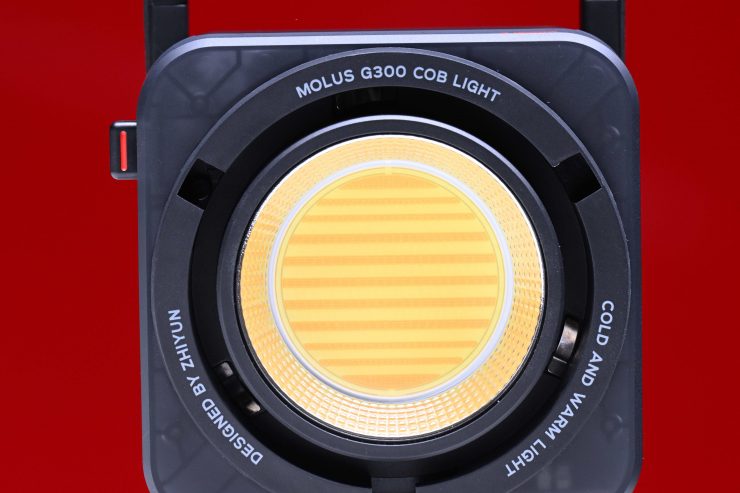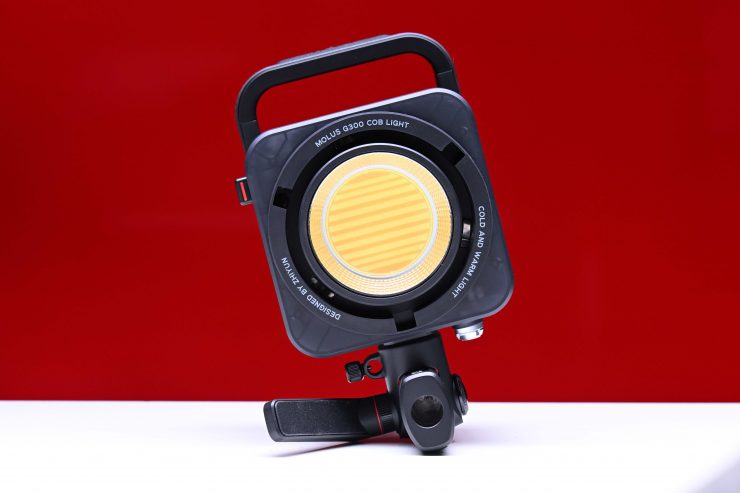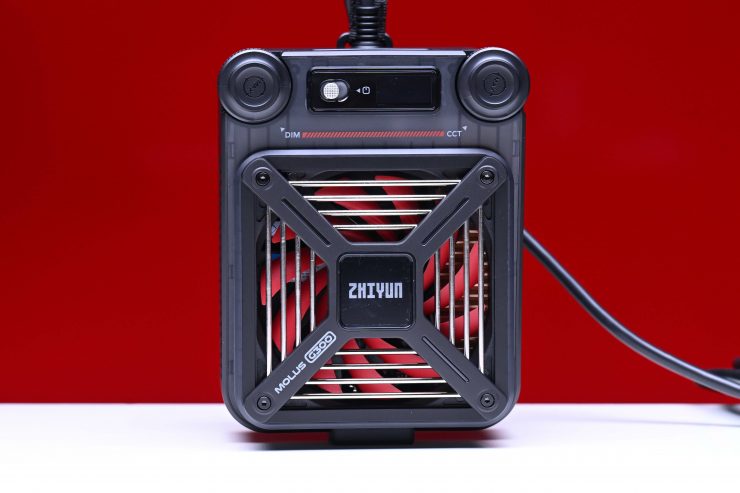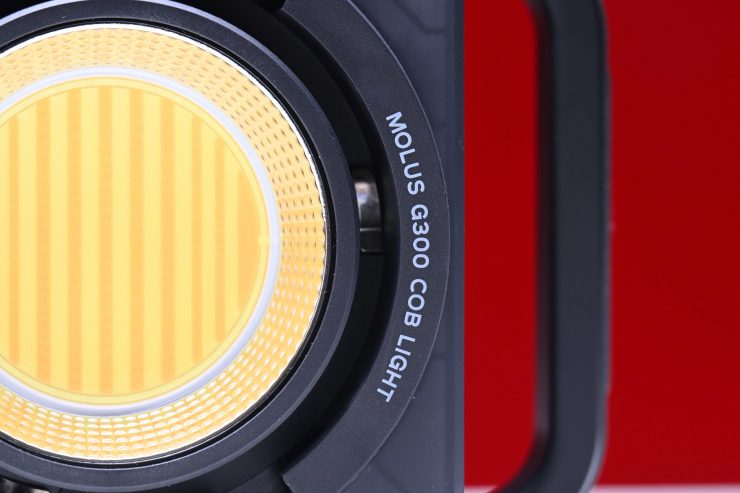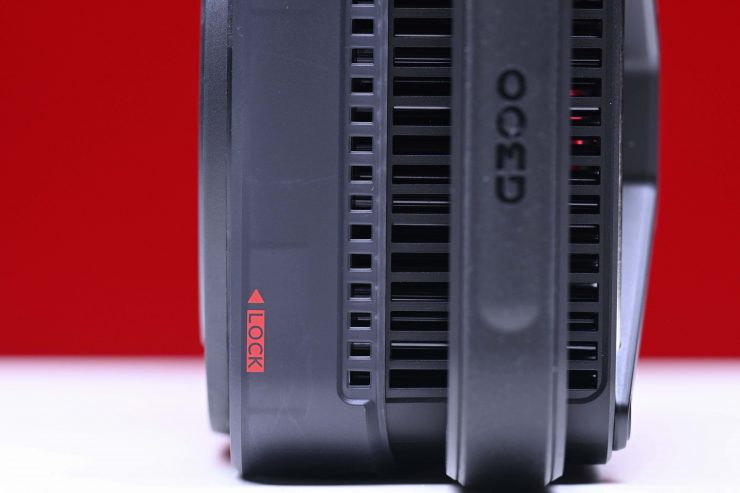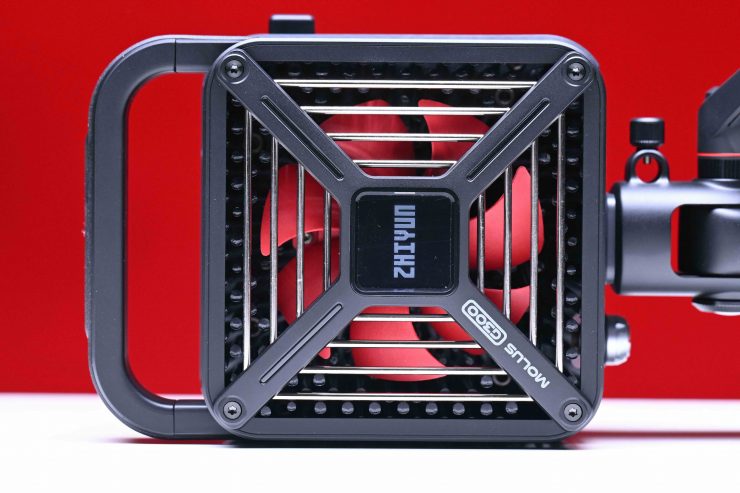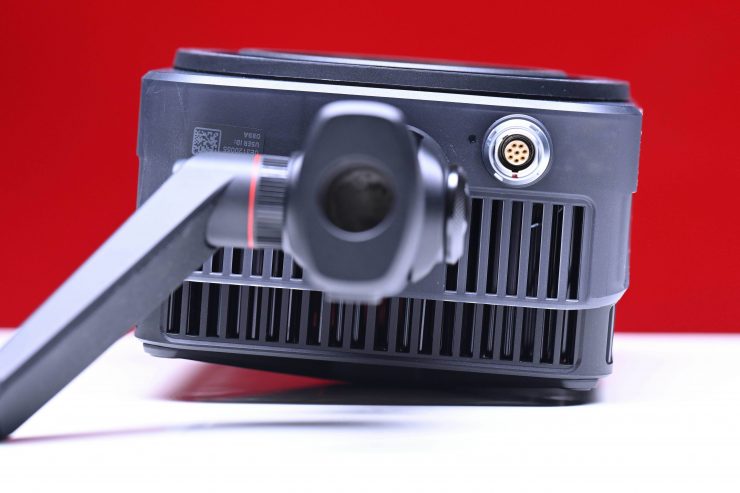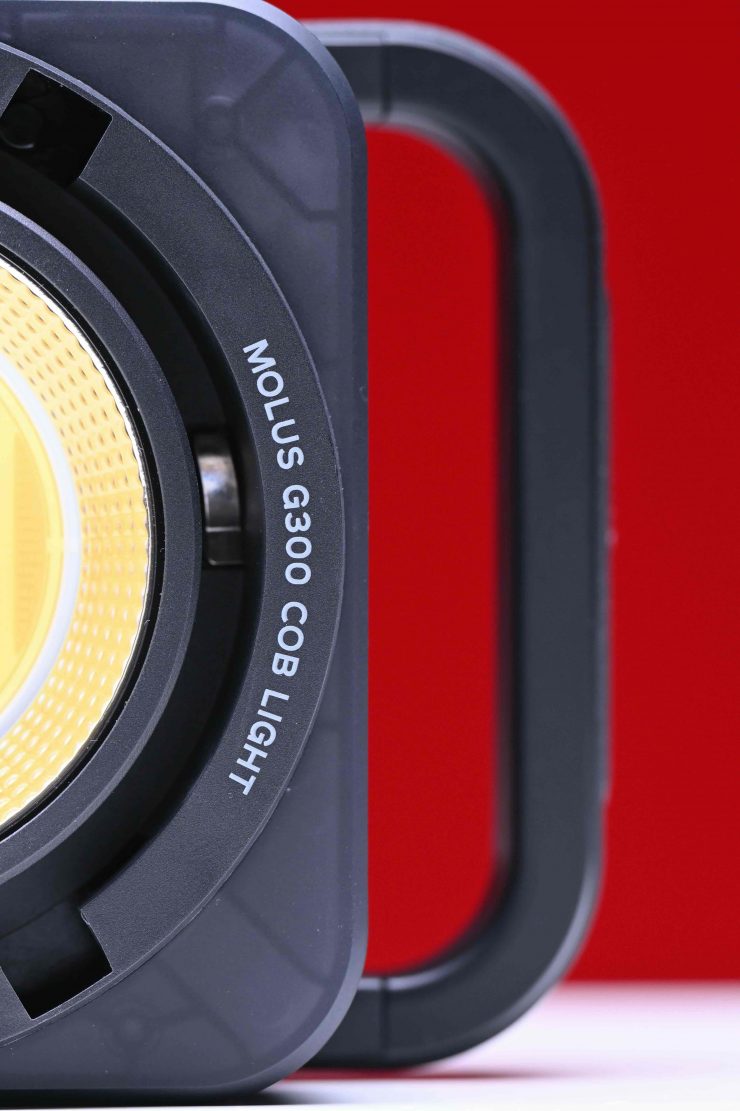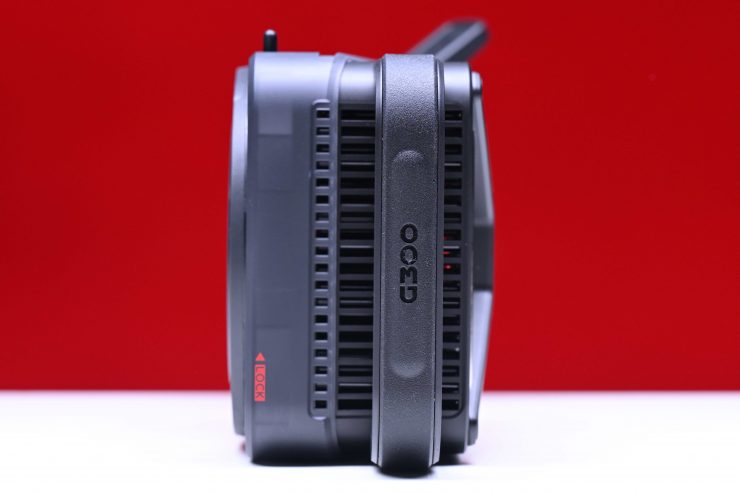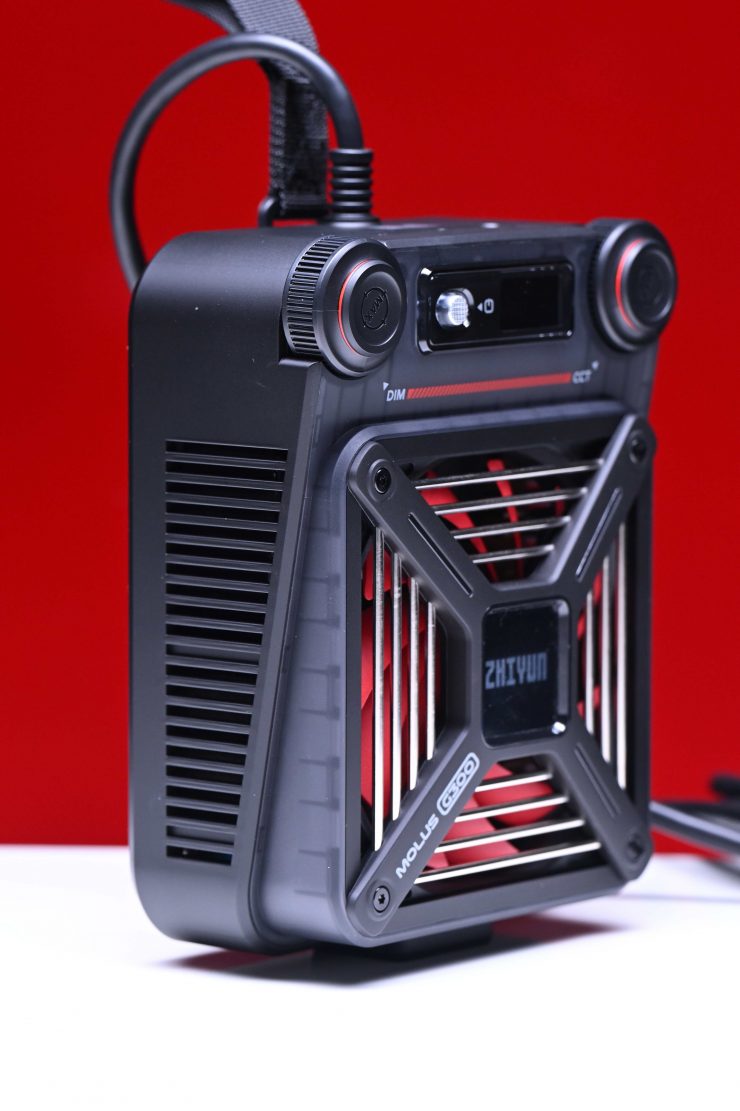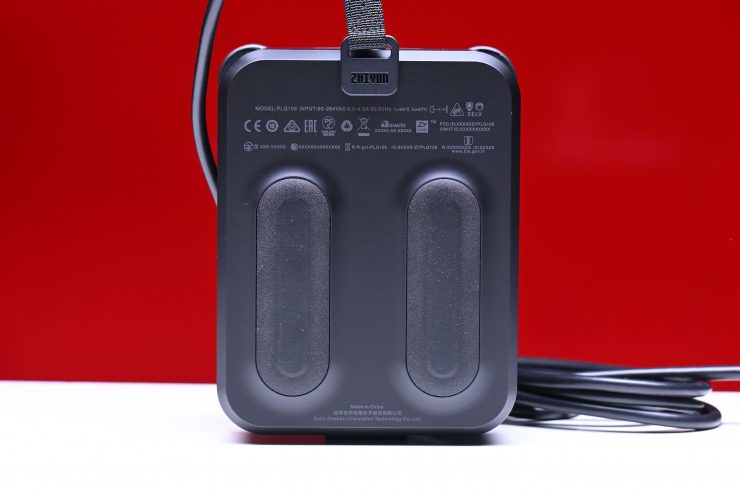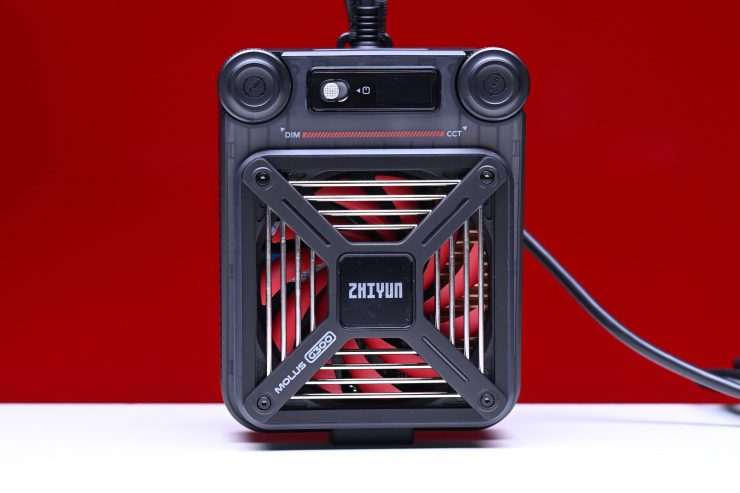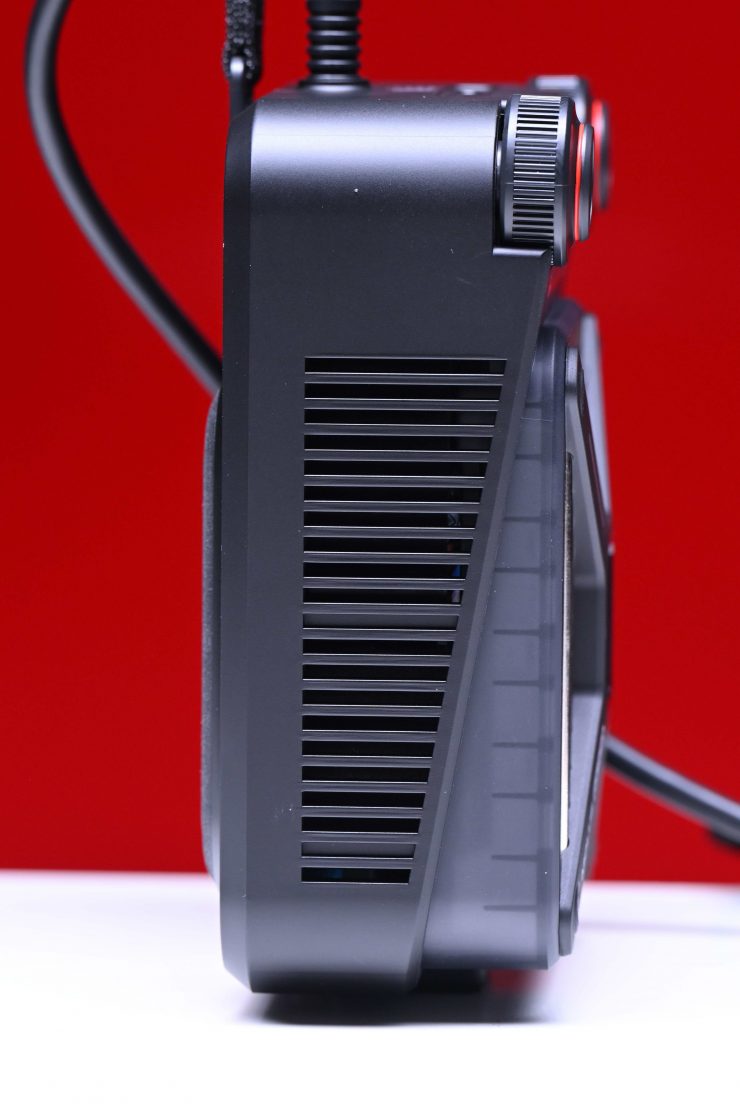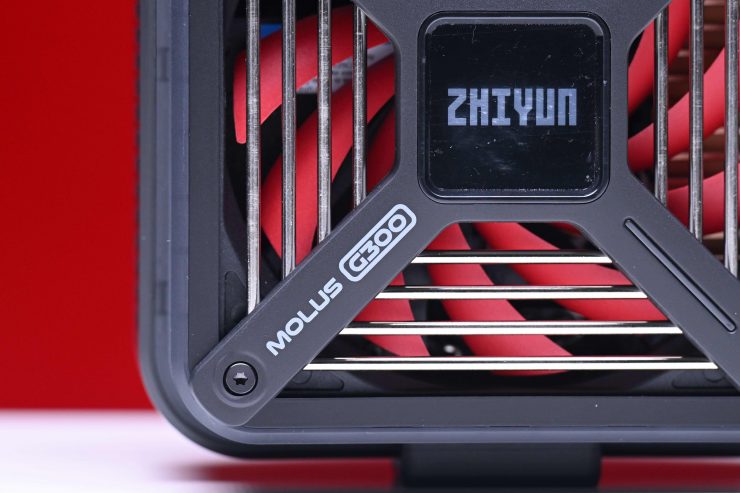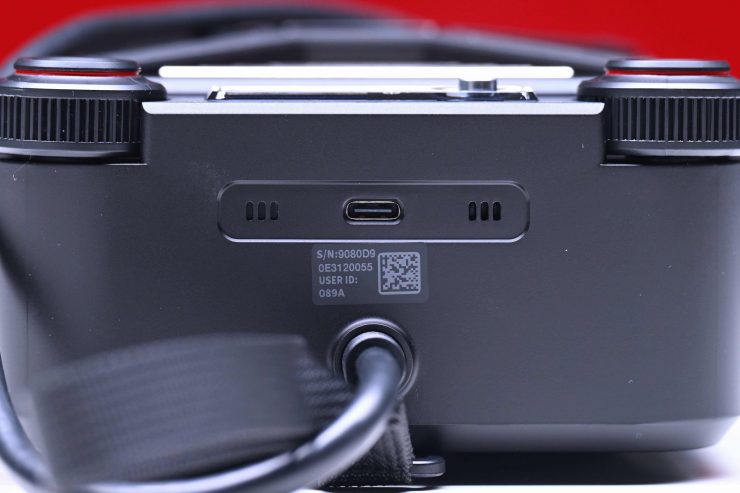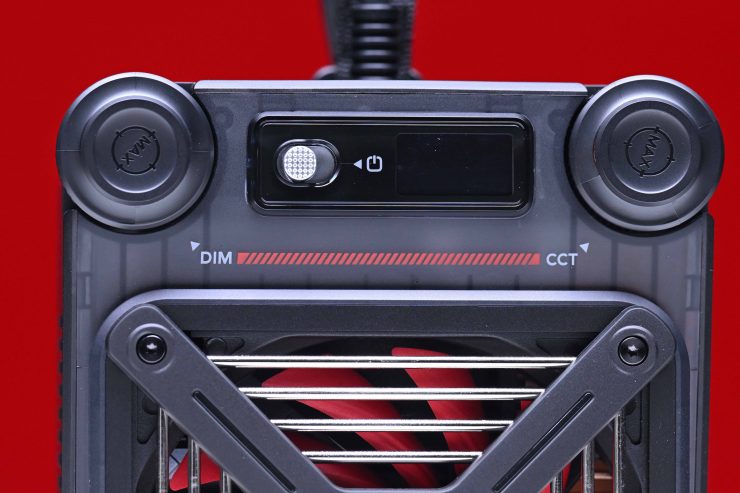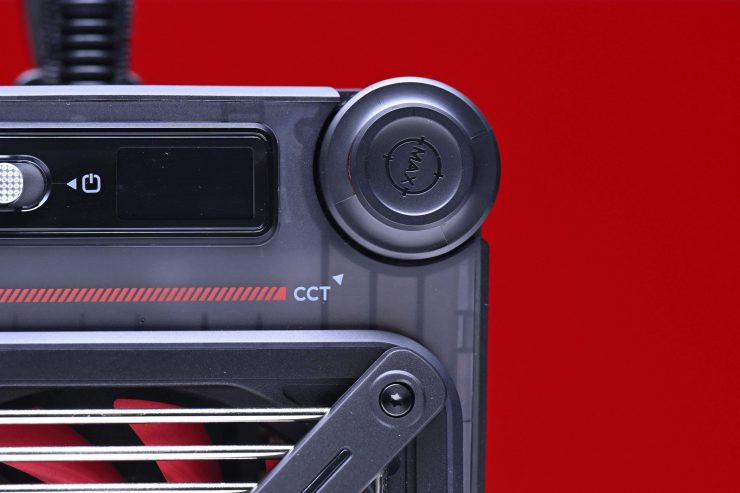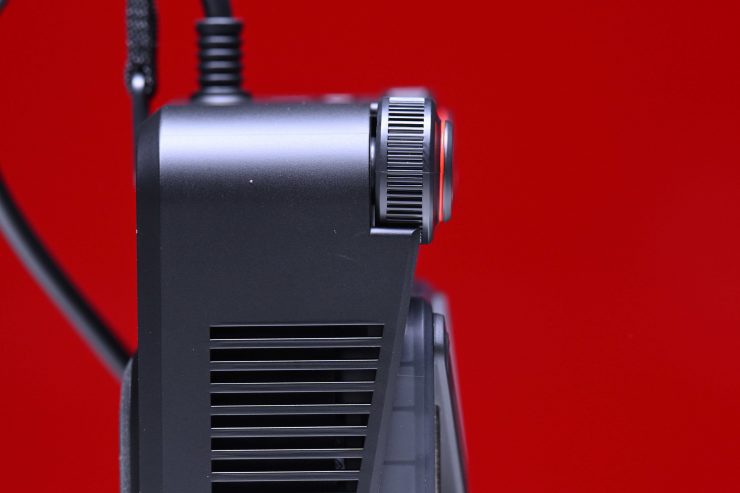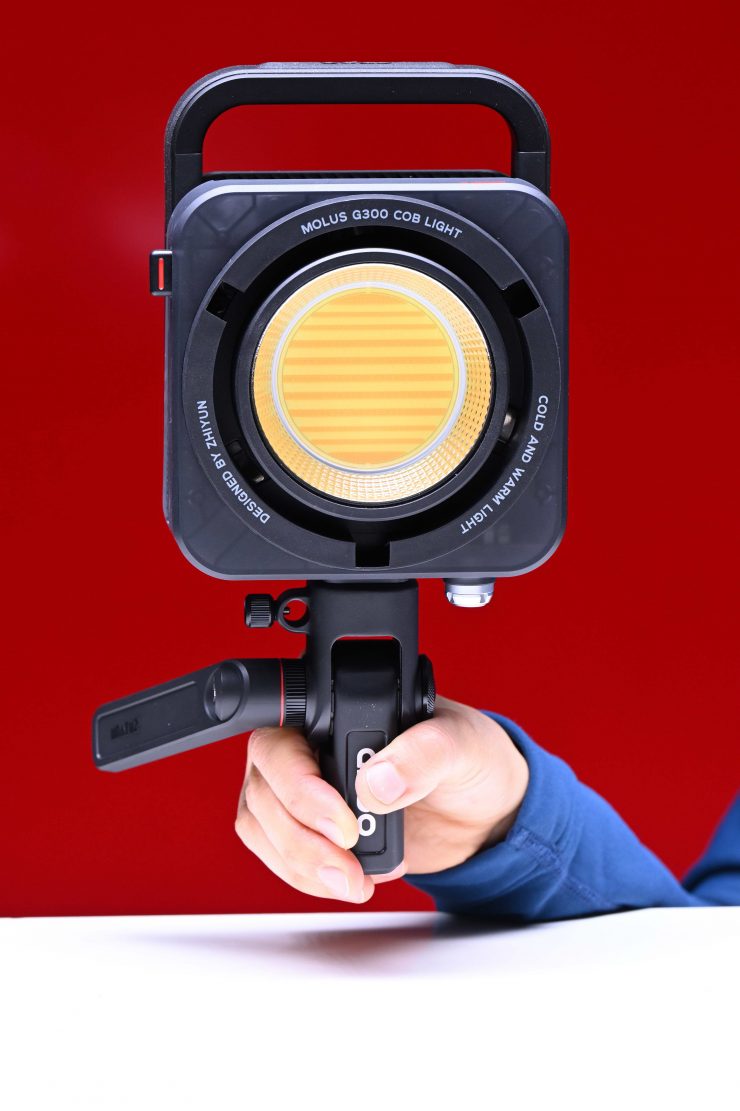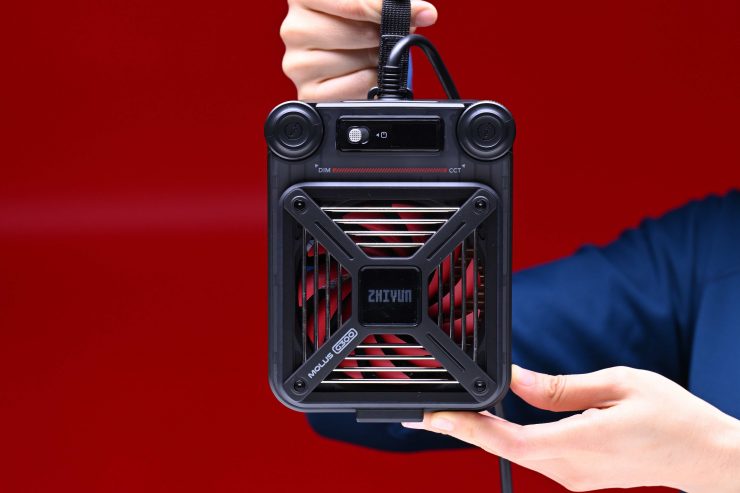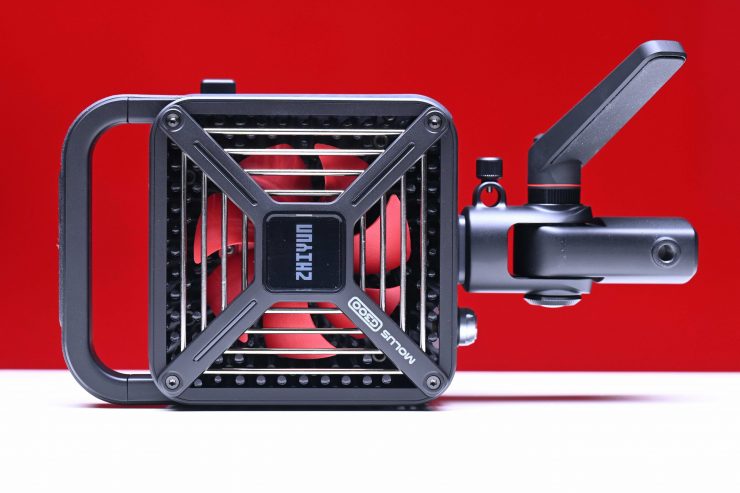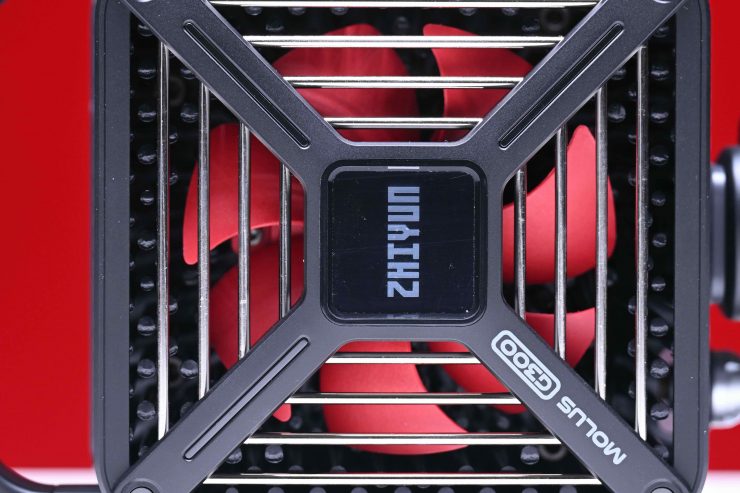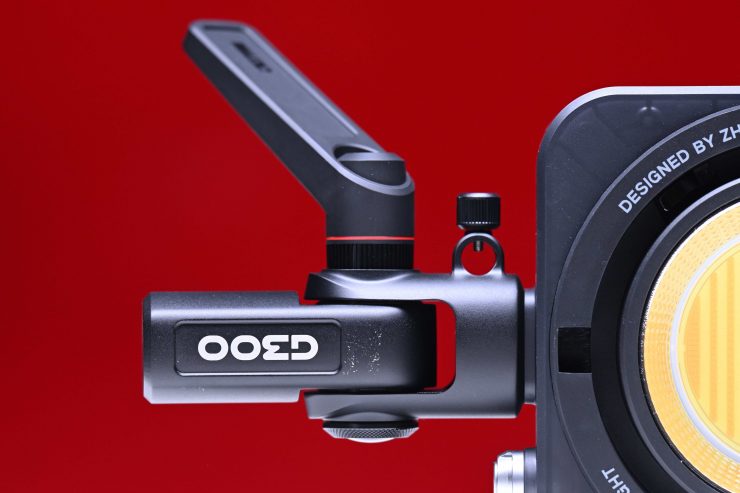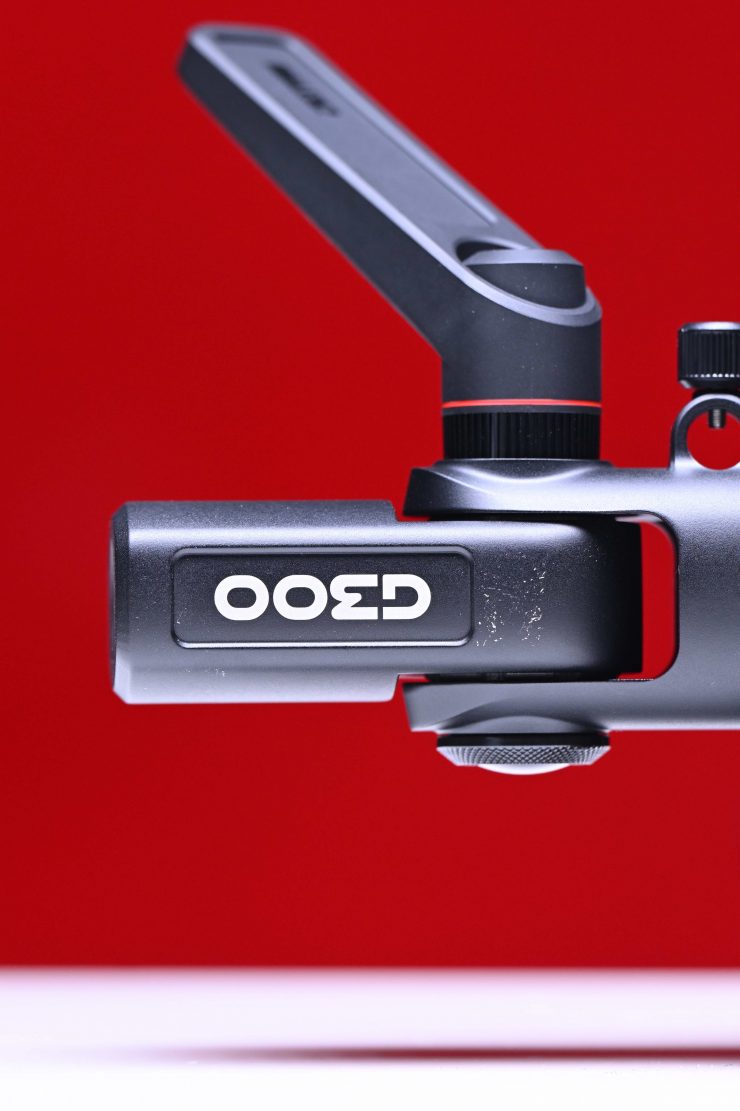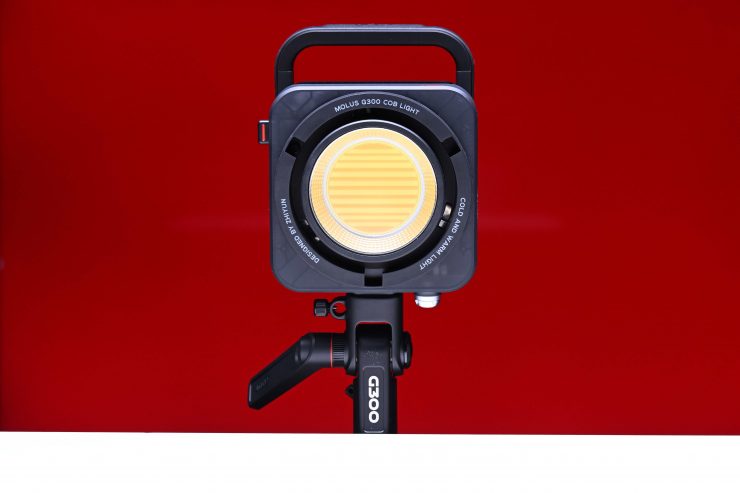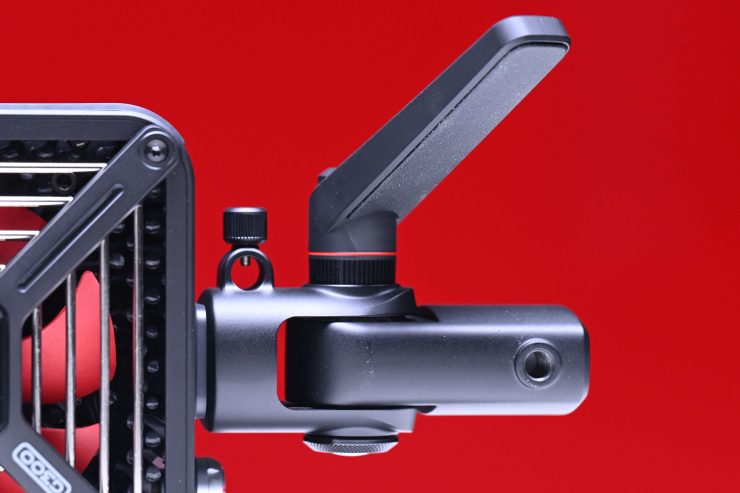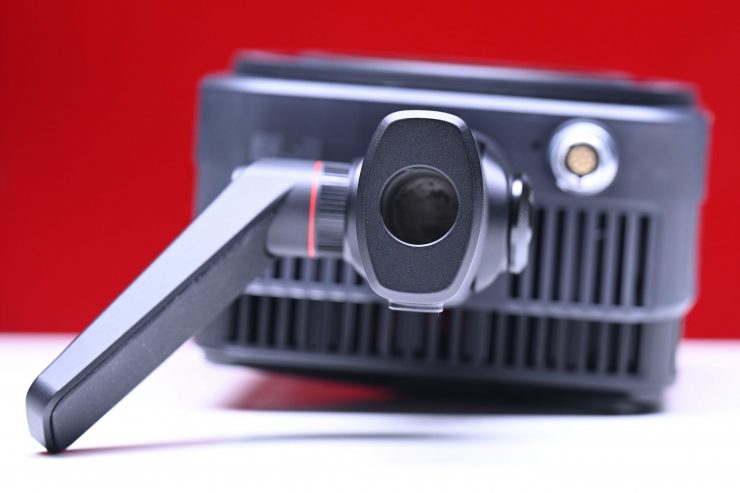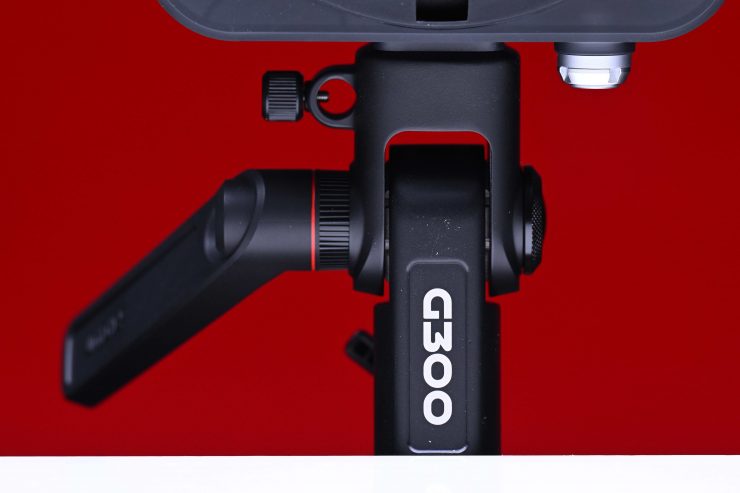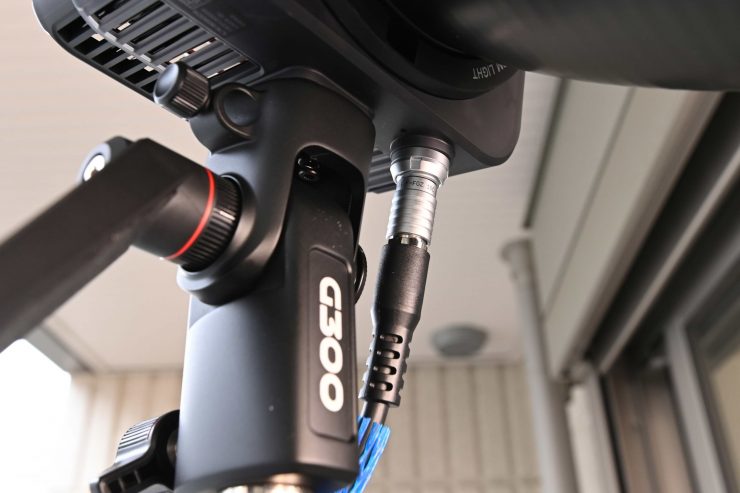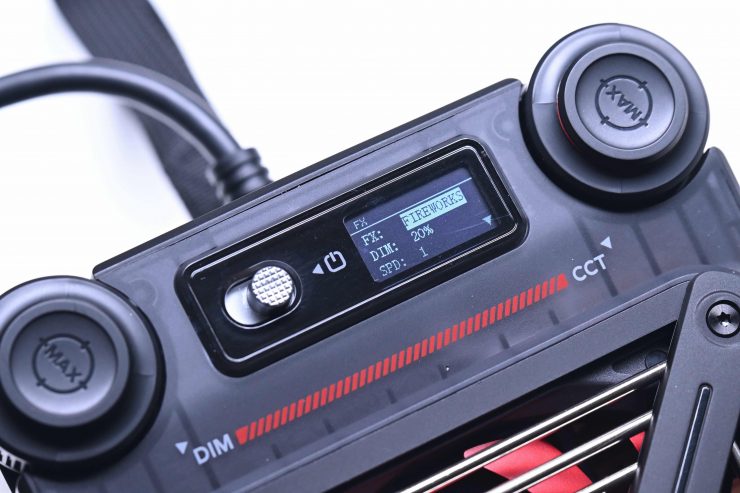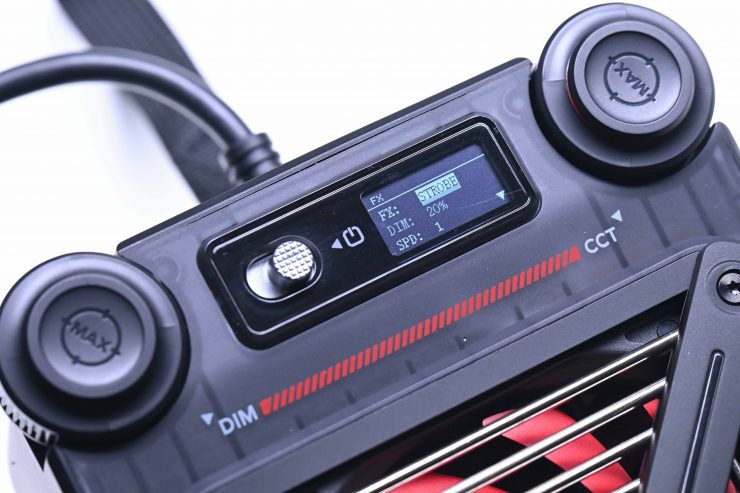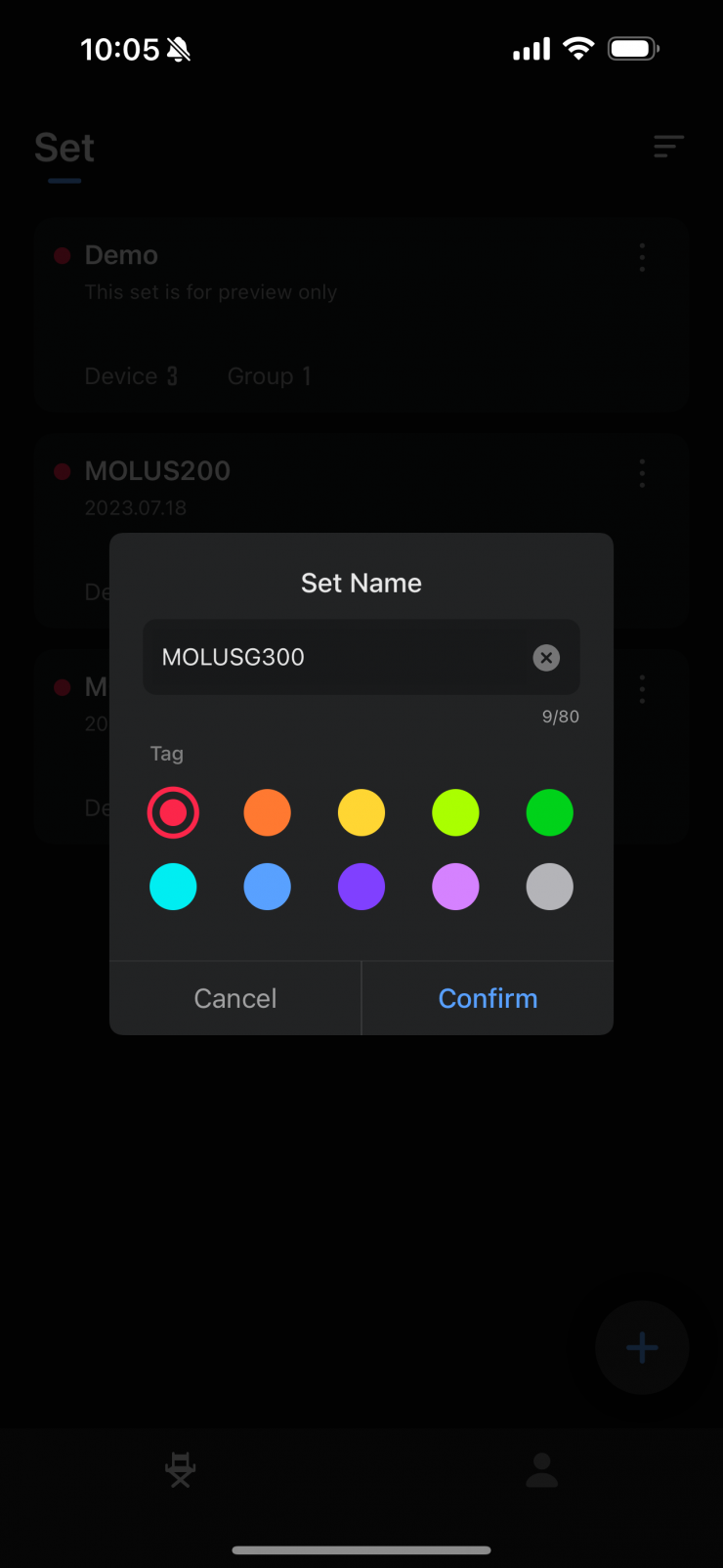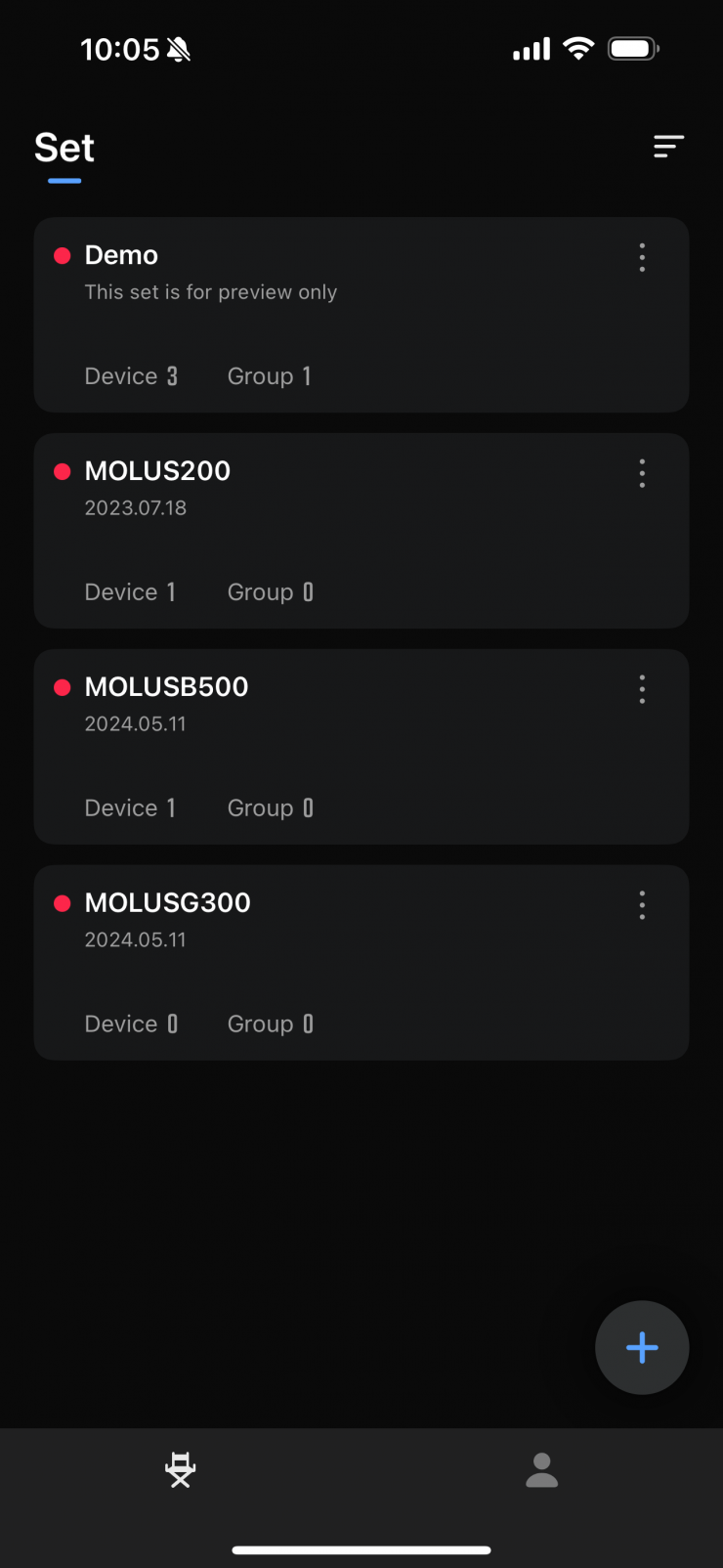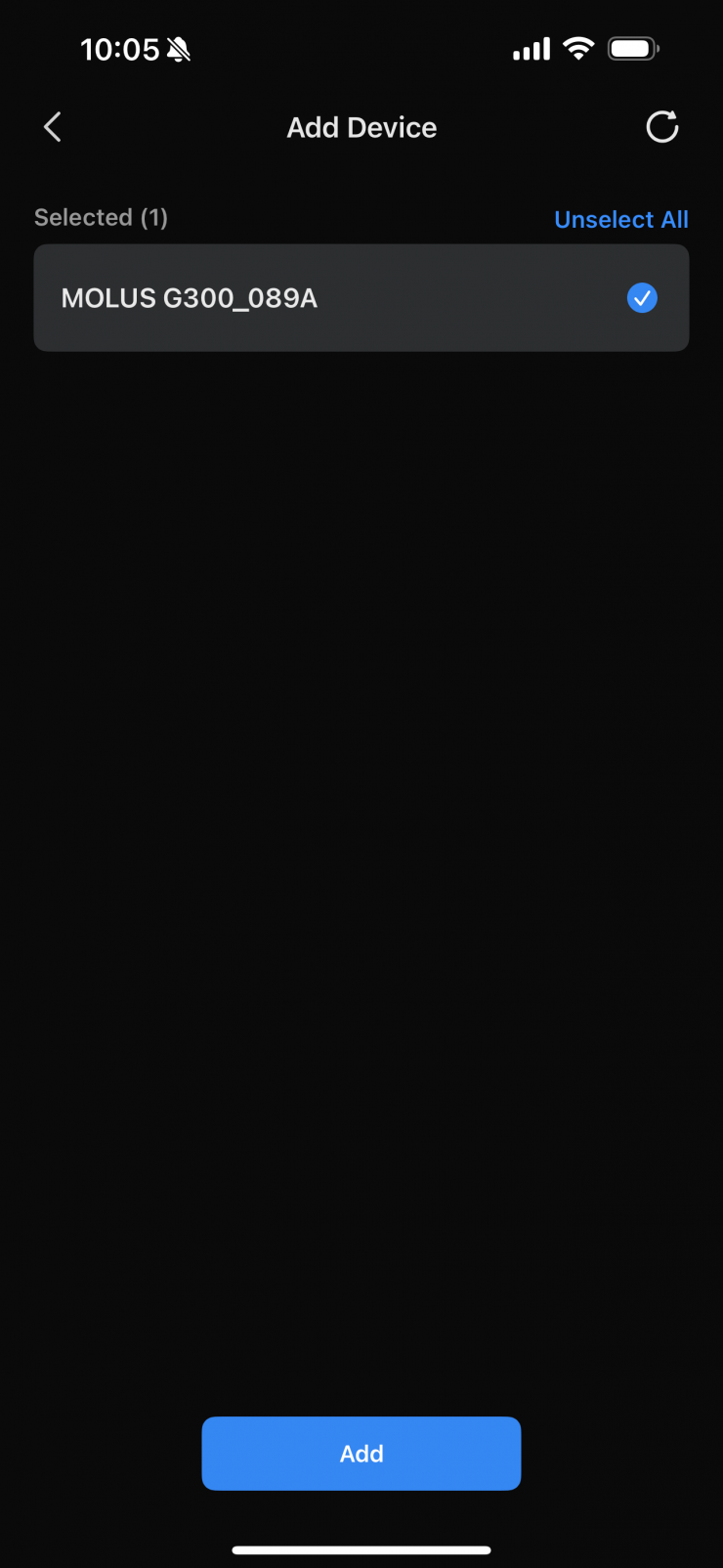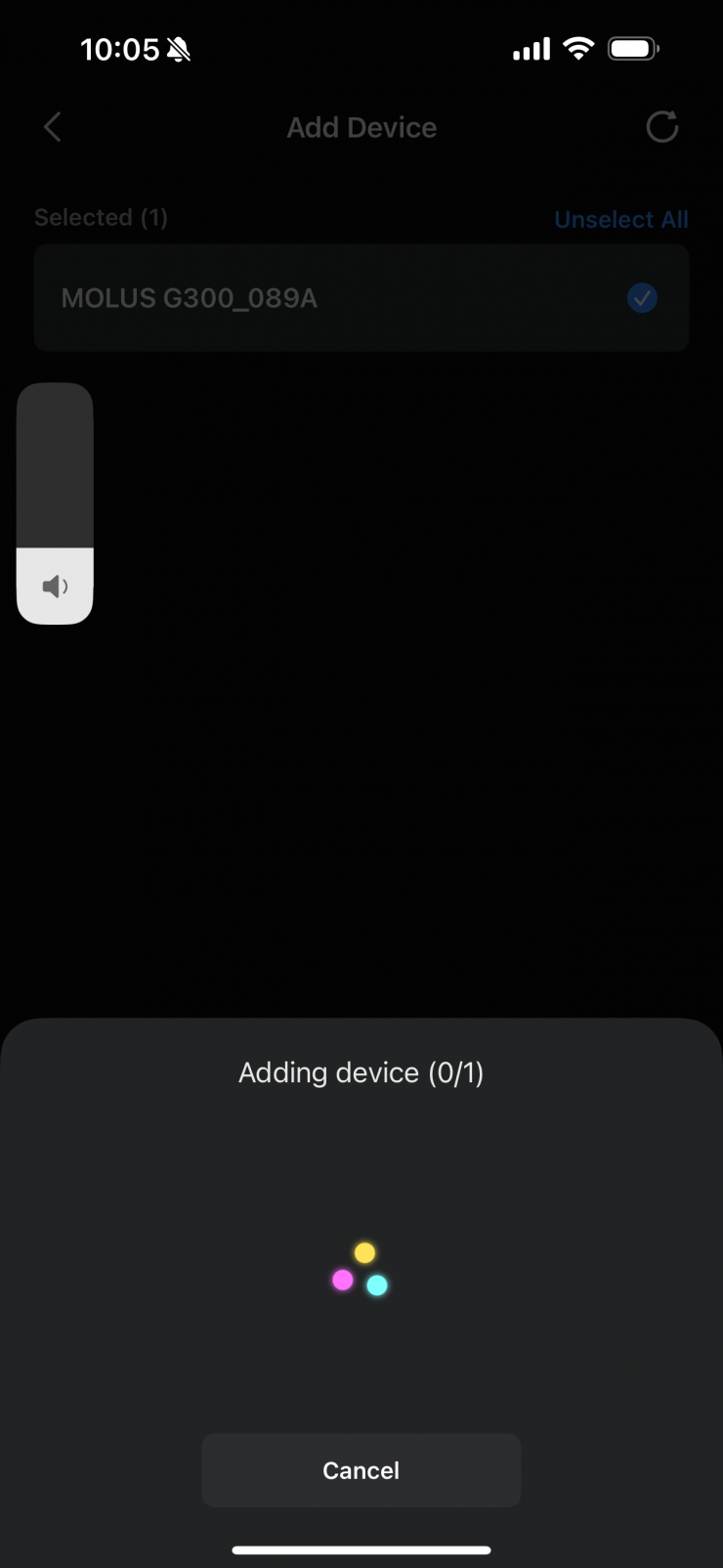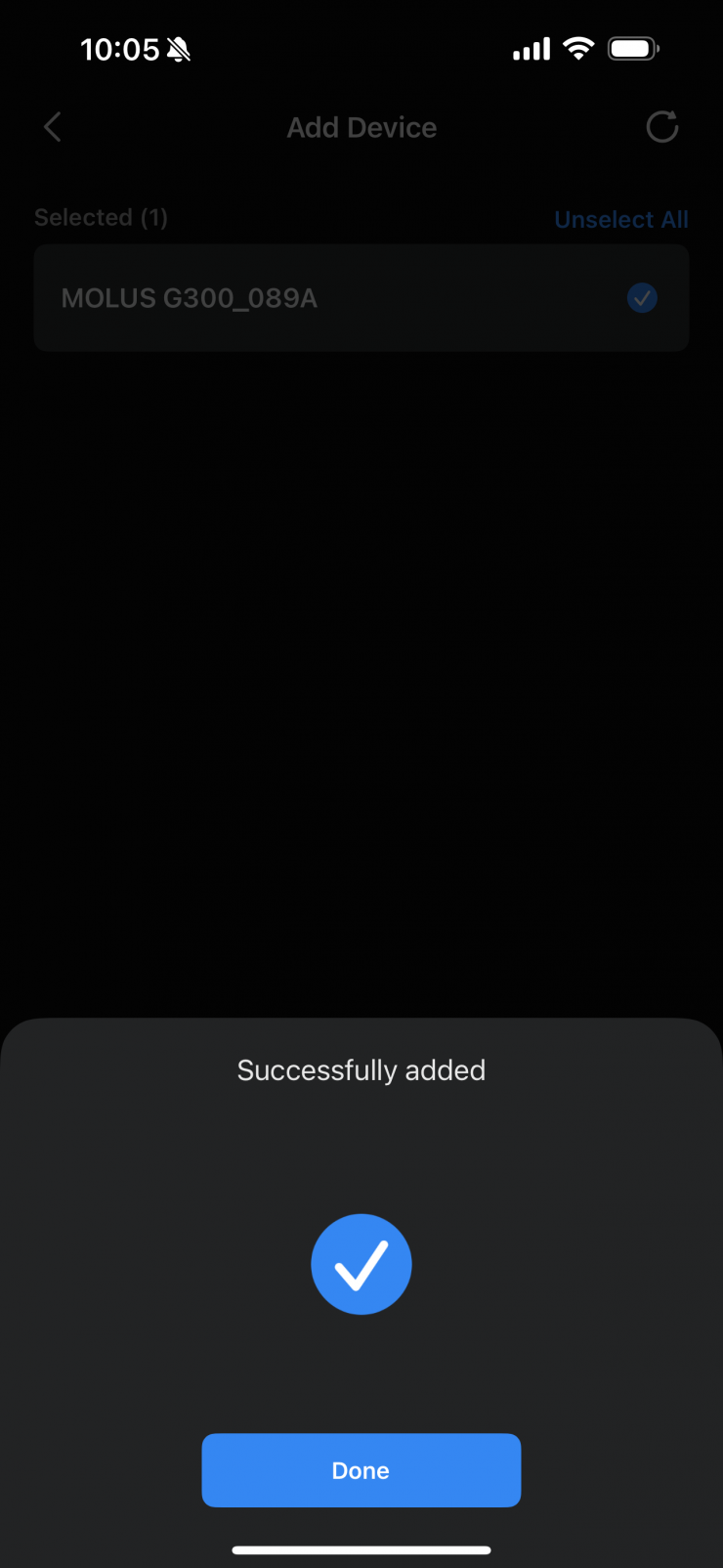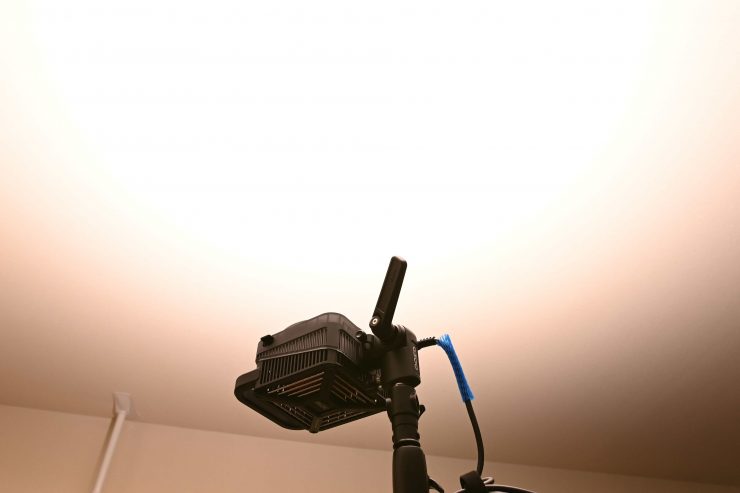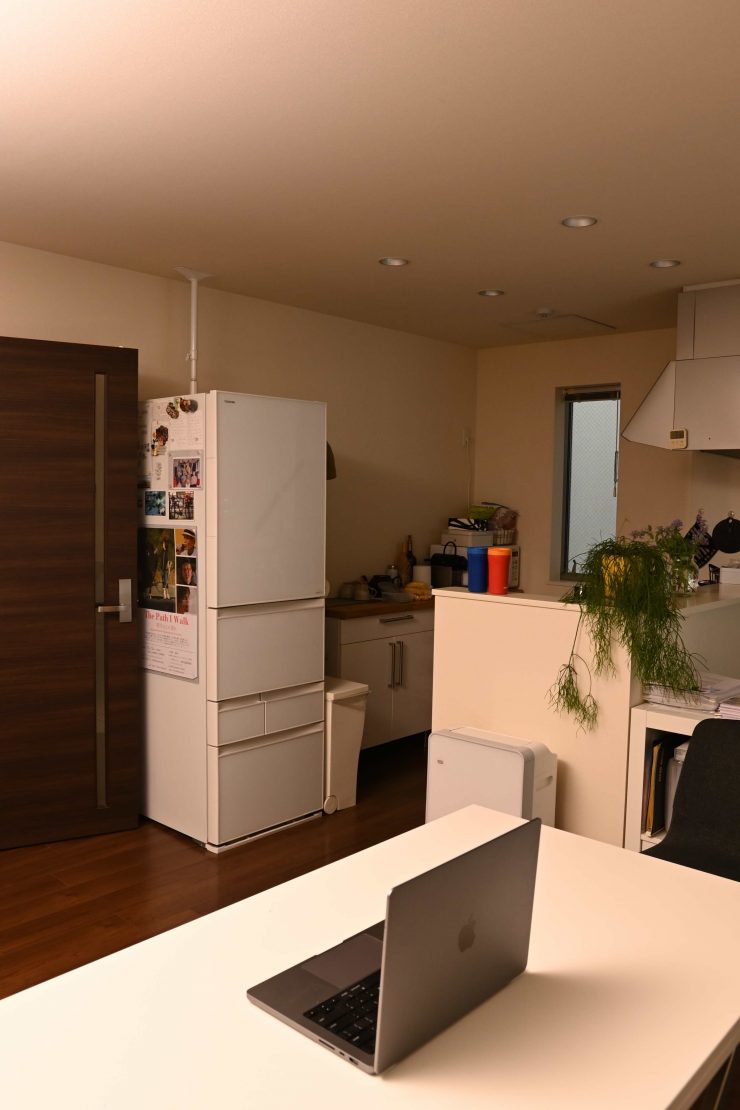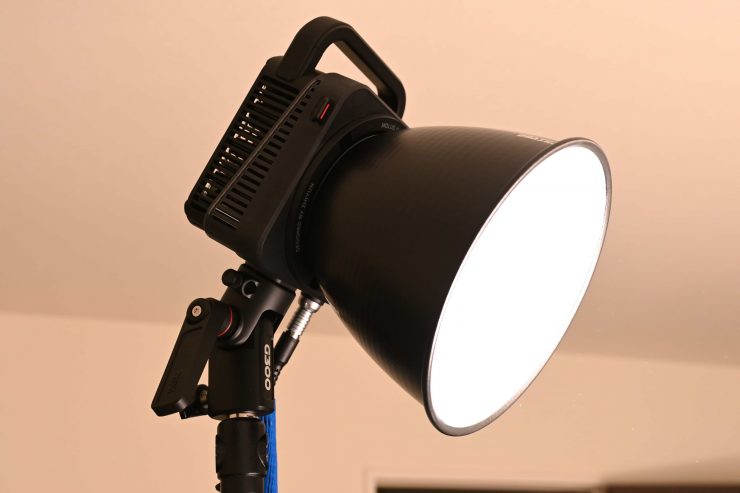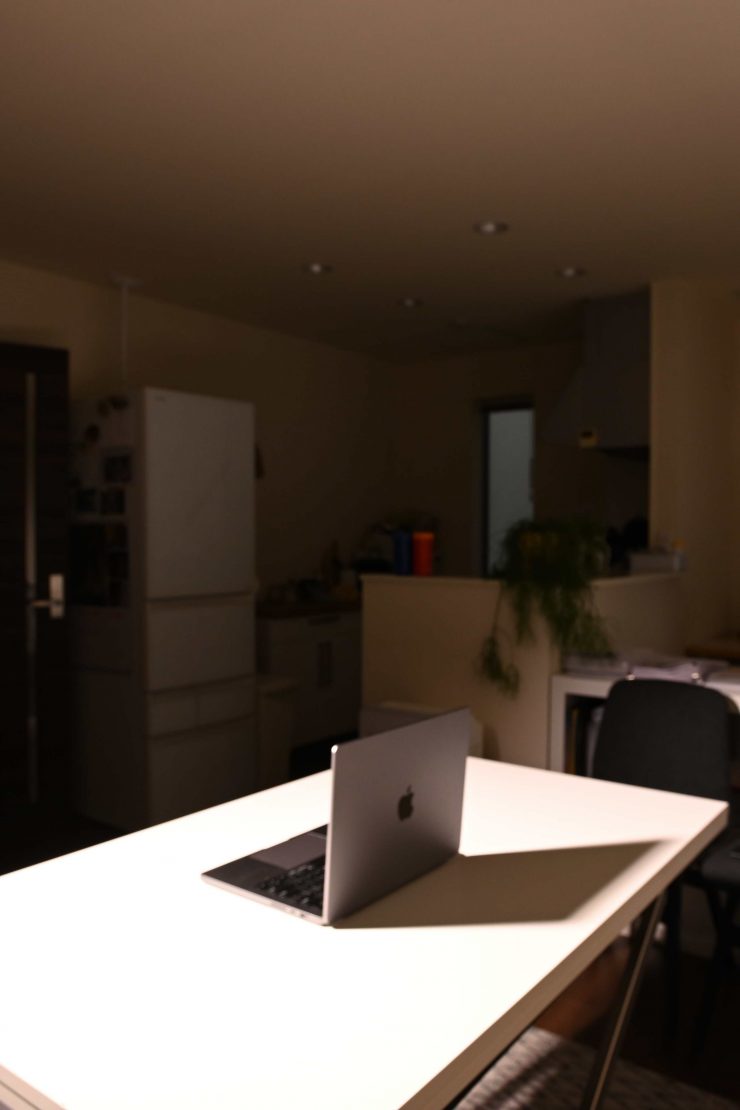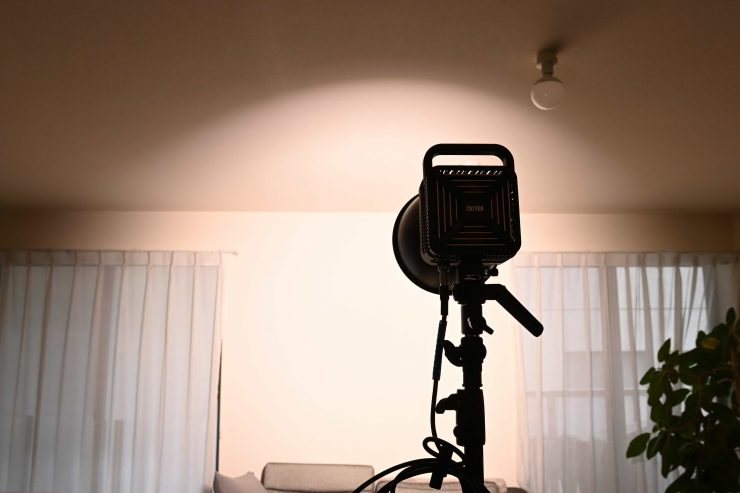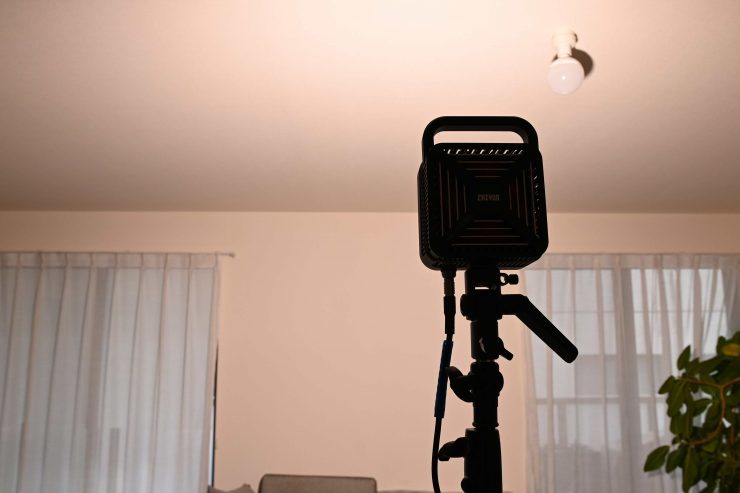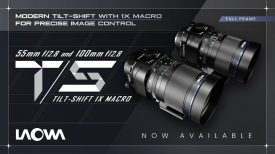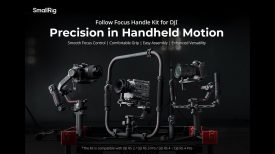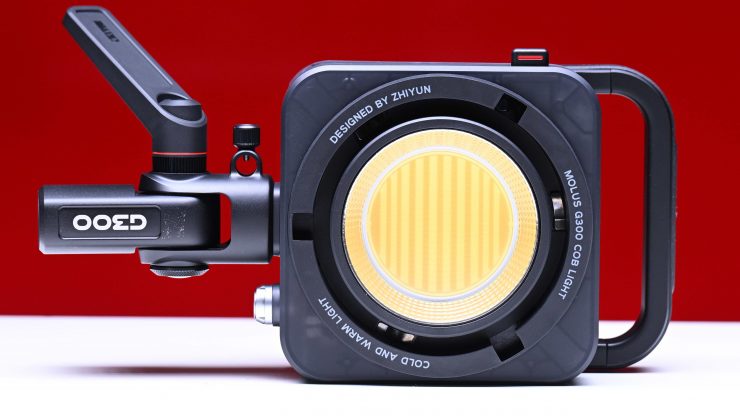
The ZHIYUN MOLUS G300 is a 300W COB Light that has a CCT range of 2700K to 6500K. It was designed to be lightweight and compact and ZHIYUN claims that it can output 15,500 lx when set at 5600K and used open face @1m / 3.3′.
It utilizes a standard Bowns S mount so that you can attach affordable lighting modifiers. I previously reviewed the ZHIYUN MOLUS G200 on the site and you can read that review here. I found that fixture wasn’t perfect, but there was certainly a lot to like about it. Its color rendering performance was good and in most of the tests I conducted, it performed well. Its compact size and high output made it a very intriguing option when compared to a lot of its competition. That light actually surprised me and I don’t think I have come across any other fixture of that size that has that much output and utilizes a Bowens Mount.
The light supports 180-degree directional adjustment on a light stand and omnidirectional conversion. It comes with a built-in umbrella hole and a newly upgraded power interface and light grip.
It is also equipped with a newly upgraded aviation interface, light stand handle, lamp head handle, side port switch, and controller cushioning pad.
The MOLUS G300 now joins the MOLUS G200, MOLUS G60, and MOLUS X100 that we first saw at Interbee 2022 in Japan.
I liked the ZHIYUN MOLUS G200 a lot and I was keen to see how its bigger brother performed. So without further ado, its get on with the review.
Key features
- Lighter but Brighter: 1.56kg, 300W high brightness
- MAX Extreme Mode: Overclockable to 500W for 20,300 Lux
- Separate Control: Easy to adjust the light settings
- User-Friendly Design: AC & aviation ports make it easily mounted on a light stand
- ZY Vega App: Tweak settings on the fly, orchestrate multi-light setups
Concept
The concept behind the MOLUS G300 was to come up with a high-power COB LED light that is suitable for studios, live streaming, and other lighting applications.
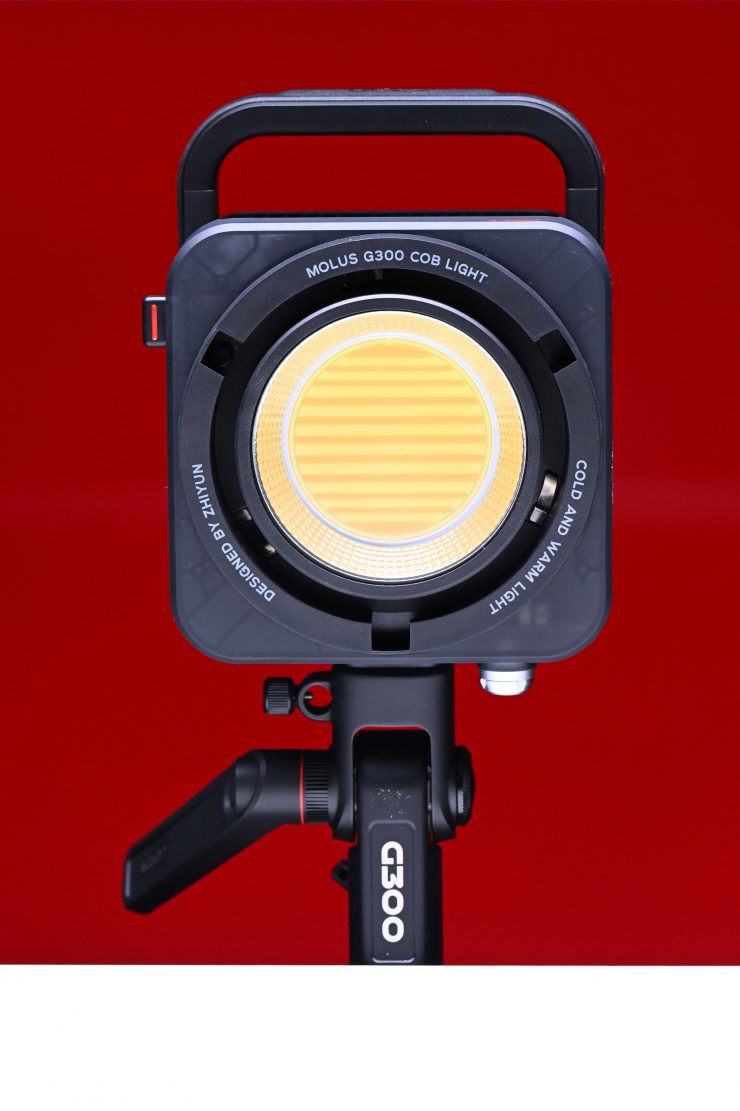
The MOLUS G300, just like the G200, features a quite unusual form factor and it looks very different from a lot of other LED lights on the market. In some ways, it looks like a Sony VENICE Rialto with a Bowens mount.
ZHIYUN’s strategy is to make lightweight and compact high output COB lights by essentially putting a COB LED in front of a large cooling system.
Everyone seems to be making lights these days
ZHIYUN is best known for making gimbals, but they have branched out into selling lights as well. They are not alone. We have seen quite a few companies in the last few years that have never sold lights before entering an already crowded market. This competition has undoubtedly brought prices down, but it does make things confusing for consumers with so many choices now available.
What I like is that ZHIYUN hasn’t just copied what others have already done. They have thought outside the box, well, in this case, inside the box! The MOLUS G300, just like the G200, looks very different from anything I have ever seen.
Build Quality
The build quality of the MOLUS G300 head unit is reasonably good for a light at this price. The casing of the light is fairly robust, although I am not sure how it would go if you accidentally dropped it. It has been made out of materials to keep the weight to a minimum.
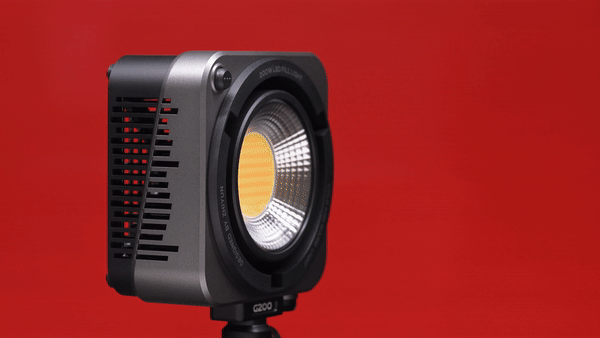
The Bowens mount is nice and solid and well made. The MOLUS G300 is actually one of the few lights I have come across with a Bowens mount that doesn’t wobble around when you use accessories.
There is a carry handle on the MOLUS G300 which is a nice touch.
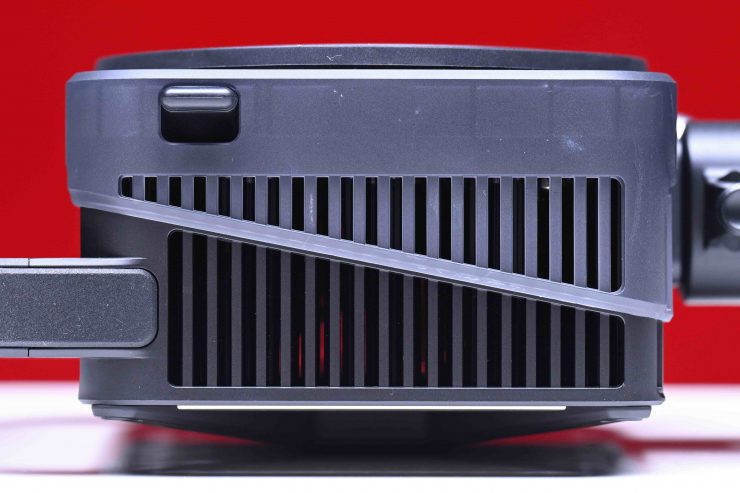
The release button for removing Bowens mount accessories is made out of hard composite material and not metal, although it still works reasonably well.
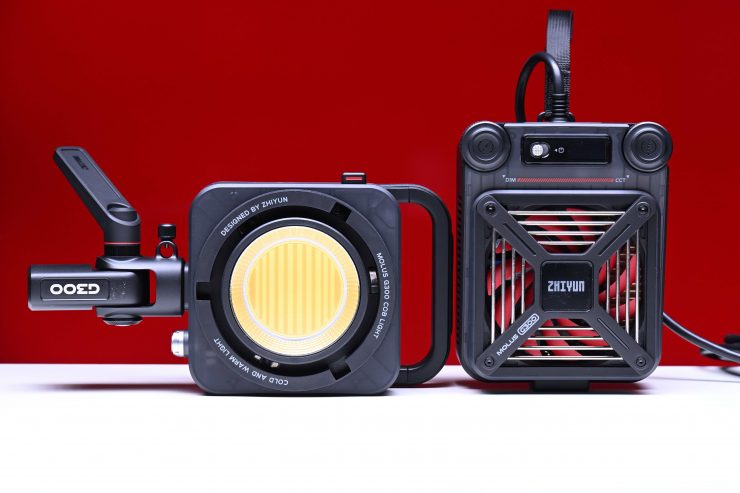
Just like the slightly smaller MOLUS G200, the MOLUS G300 features a separate head unit and a power supply/controller. The cable that goes from the power supply/controller to the light head is around 2m / 6.6′ long.
I am glad to see that ZHIYUN upgraded the power supply/controller on the MOLUS G300, and it is an improvement over the MOLUS G200, which I thought wasn’t quite as well made as the light head. The upgraded controller boasts cushions, extended 7.5m cables, and USB-C input for firmware upgrades.
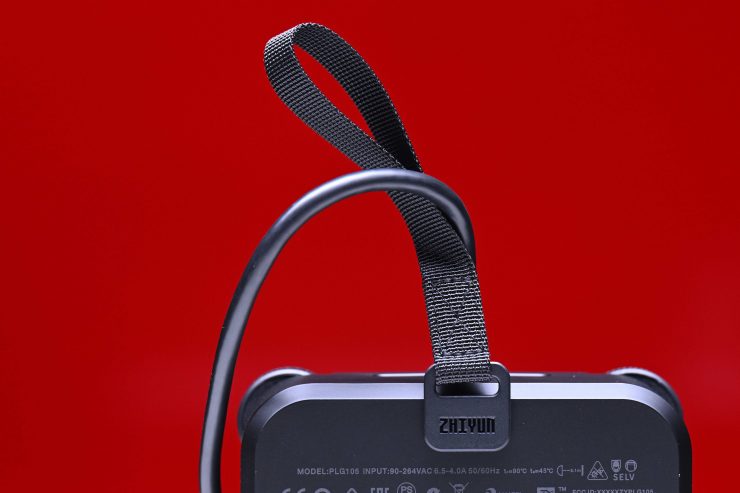
It does have a lanyard strap on it so you can attach it to a light stand, etc.
The dimming and CCT adjustment dials are not overly tactile.
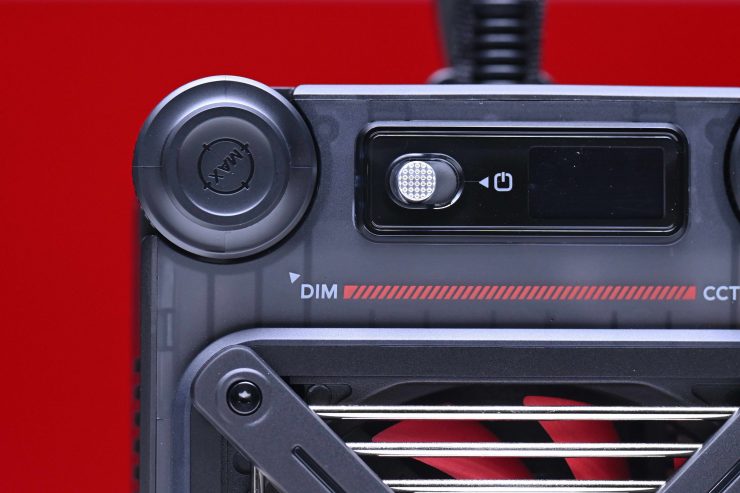
MOLUS G300 
MOLUS G200
The power on/off switch is now on the front, which is an improvement over the MOLUS G200.
Weight & Size
The MOLUS G300 fixture weighs in at just 3.3 lb / 1.5 kg. The power supply/controller tips the scales at 2.75 lb / 1.25 kg.

As a comparison, the MOLUS G200 fixture weighs in at 2.2 lb / 1 kg. The power supply/controller tips the scales at 2.01 lb / 0.91 kg.
I think the small size and lack of weight make this an appealing light for anyone who needs to travel while maintaining a small footprint.
So how does this weight compare to some other lights with a similar power draw that could be considered competition? Below you can see:
| TOTAL WEIGHT | |
| ZHIYUN MOLUS G300 | 6.05 lb / 2.75 kg |
| amaran COB 200x S | 8.18 lb / 3.71 kg |
| Aputure LS 300x | 25.13 lb / 11.4 kg |
| Nanlite FS-300B | 6.6 lb / 3 kg |
| Sirui Blaze C300B | 8.33 lb / 3.78 kg |
| CAME-TV Tioga Series 310W Bi-Color | 5.16 lb / 2.34 kg |
| GVM Pro SD300B | 8.31 / 3.77 kg |
If you look at the weight comparison above, you can see that the ZHIYUN MOLUS G300 is lighter than most of the other options.
Bowens Mount
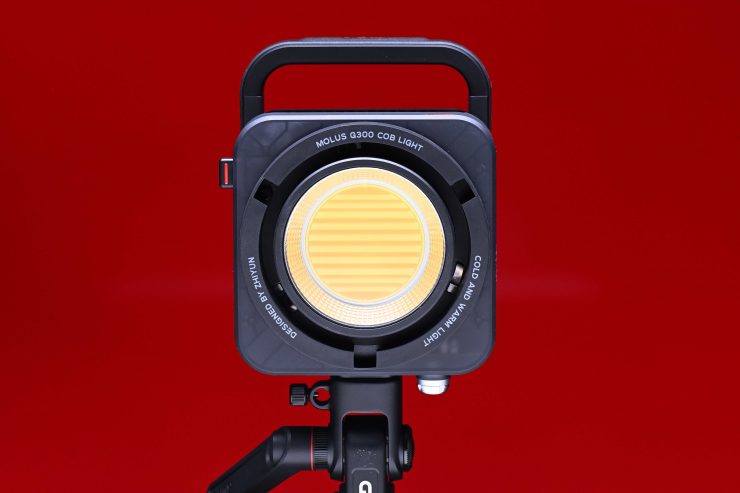
Despite its small size, the light still features a full-size Bowens mount which allows you to use a wide array of affordable lighting modifiers.
Being able to use Bowen Mount accessories is a nice feature, but because the light is relatively small, you do need to be careful how big those accessories are that you attach.
If you tried to run any type of lighting modifier that was too big or heavy I would be very concerned about how much weight the light stand mount could handle. I will actually test how much weight it can handle further down in the review.
Power Draw

The ZHIYUN MOLUS G300 draws a maximum of 500W, which is a lot considering its size. I am not sure about the naming convention that ZHIYUN uses, as you have to wonder why it isn’t called a G500.
| POWER DRAW | |
| ZHIYUN MOLUS G300 | 500W |
| amaran COB 200x S | 229W |
| Aputure LS 300x | 350W |
| Nanlite FS-300B | 350W |
| Sirui Blaze C300B | 300W |
| CAME-TV Tioga Series 310W Bi-Color | 310W |
| GVM Pro SD300B | 300W |
So how does this power draw compare to some other lights that could be considered competition? Above you can see. The 500W power draw is a lot more than some other competing fixtures.
The caveat with the ZHIYUN MOLUS G300 is that it can only be run via a 100 to 240 VAC input. It doesn’t feature any battery plates and there is no way to run it from a DC source.
How does it stay cool?

COB LED lights generate a lot of heat, so it is no real surprise that ZHIYUN has chosen to separate the COB from the power supply/controller as this would help immensely with the cooling. ZHIYUN is utilizing what they refer to as the DynaVort Cooling System MKⅡ which features a heat sink and FOC fan. It is claimed to deliver exceptional heat dissipation in a compact form.
The MOLUS G300 light head does feature a large fan, but there are no controls to adjust the fan.
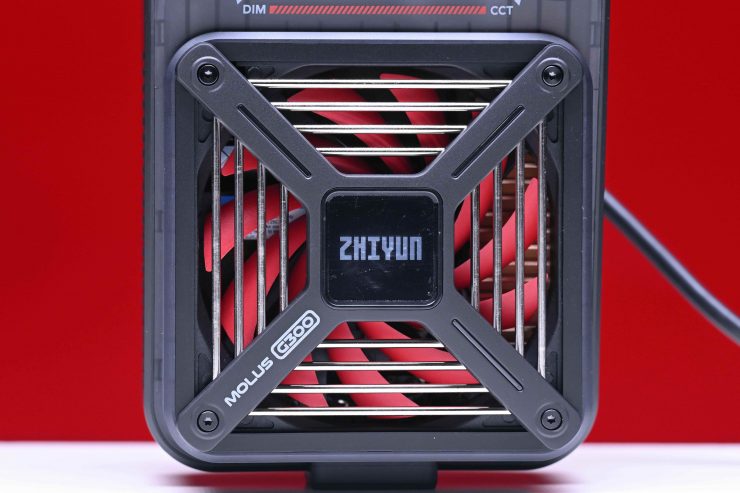
The power supply/controller also features a large fan.
The fans are relatively quiet even when operating at 100% output for long periods of time in the normal operating mode.
In the MAX Extreme mode, the fans are pretty noisy, especially the one in the light head. You wouldn’t want to use this mode if you need to record any critical audio. Even in the MAX Extreme mode, after an hour of being on at 100% the housing didn’t get that hot and you could still touch it.
Beam Angle
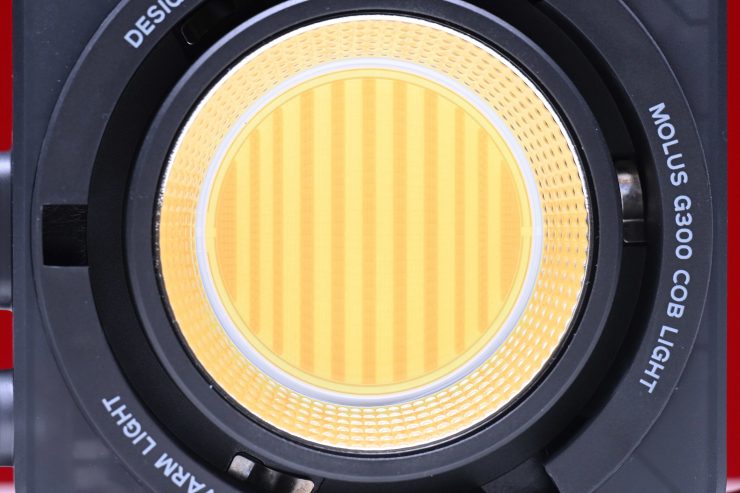
The native beam angle of the MOLUS G300 when used open face is 105°. This is reasonably wide and handy for a lot of situations where you want to create a broad spread of light.
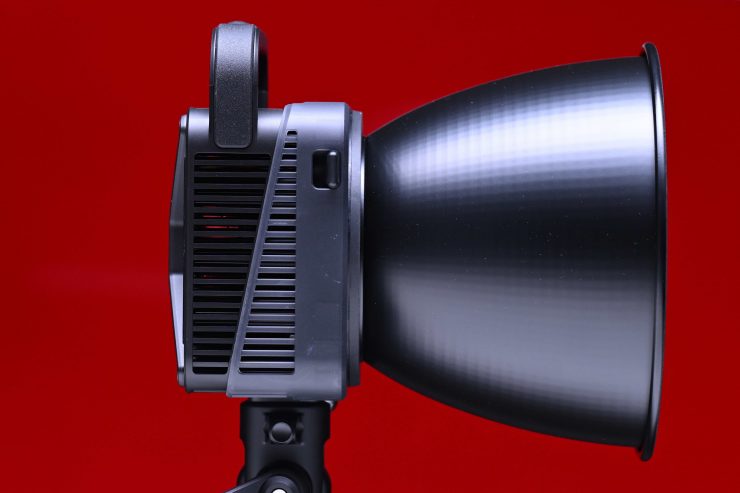
You can alter that beam angle by using the included reflector. The beam angle with the reflector is 47°.
Mounting
The light features an integrated light stand support that allows for up to 180 degrees of movement. There is also a built-in umbrella slot for running affordable lighting modifiers.
As I mentioned earlier, this locks off without moving and it is nice and solid, despite being lightweight.
Controls & Menu System
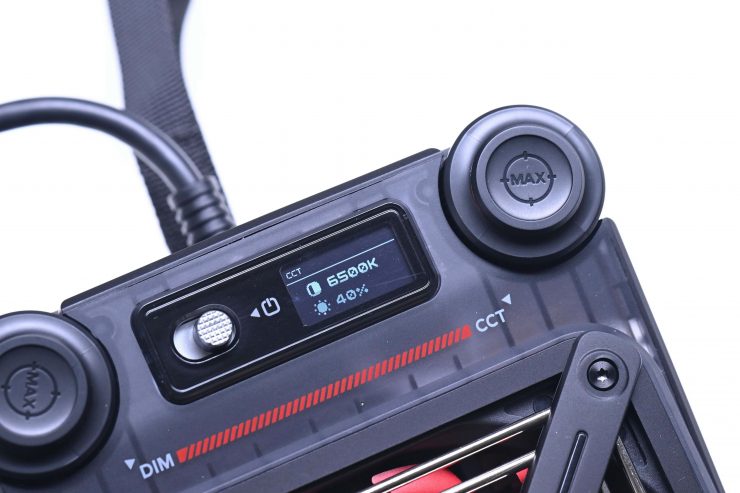
MOLUS G300 
MOLUS G200
The MOLUS G300 has a pretty basic interface that is located on the power supply/controller box. The interface is similar to that of the MOLUS G200.
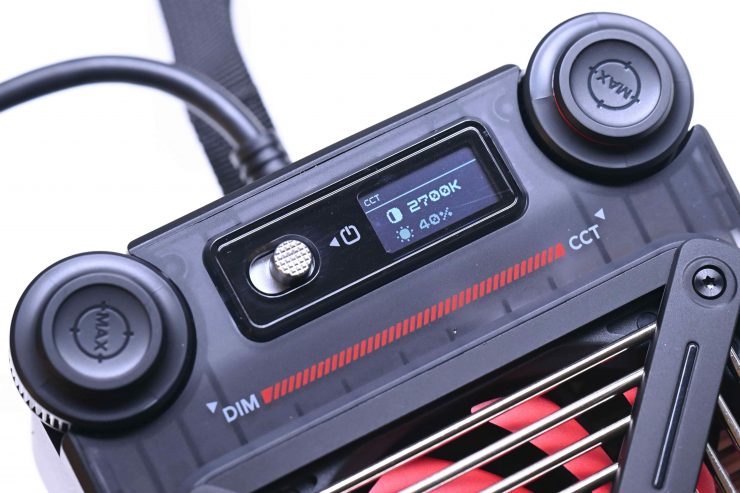
Here you can adjust the CCT from 2700-6500K, as well as the intensity. My issue with the CCT adjustment is that you can only make changes in 100K increments.
If you press the Dimmer button the intensity increases by 20% each time.
There are also 5 preset CCT settings you can choose from. You do this by pressing the CCT button.
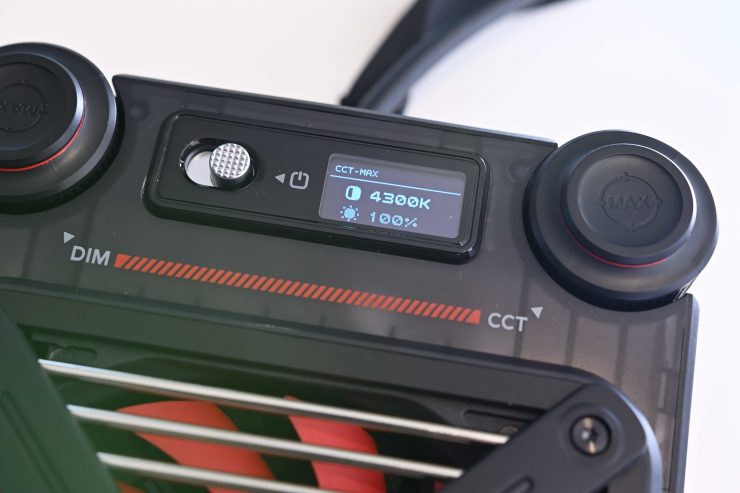
By pressing both the color temp and brightness dials you can activate MAX Extreme mode. In this mode you get an increased output of 60% (500W). The catch with this mode, according to ZHIYUN, is that the light only works at 4300K and it will only work in this mode for a certain period of time (depending on the ambient temperature). ZHIYUN doesn’t list how long the light will run in this mode. I will test this out further down in the review.
While there is nothing overly fancy about the interface, it certainly does the job.
As I always say, the hallmark of a good operating system is that you shouldn’t have to read a manual to work out how to use it. You should be able to turn it on and use it straight away. In that regard, the light is fairly straightforward and easy to operate and control.
ZY Vega

There is an app available for controlling the light called ZY Vega.

Once you download the app you need to agree to quite a few terms and conditions.

Once you have agreed to these, you will get a request for the app to use Bluetooth.
The next step is to create a Set.
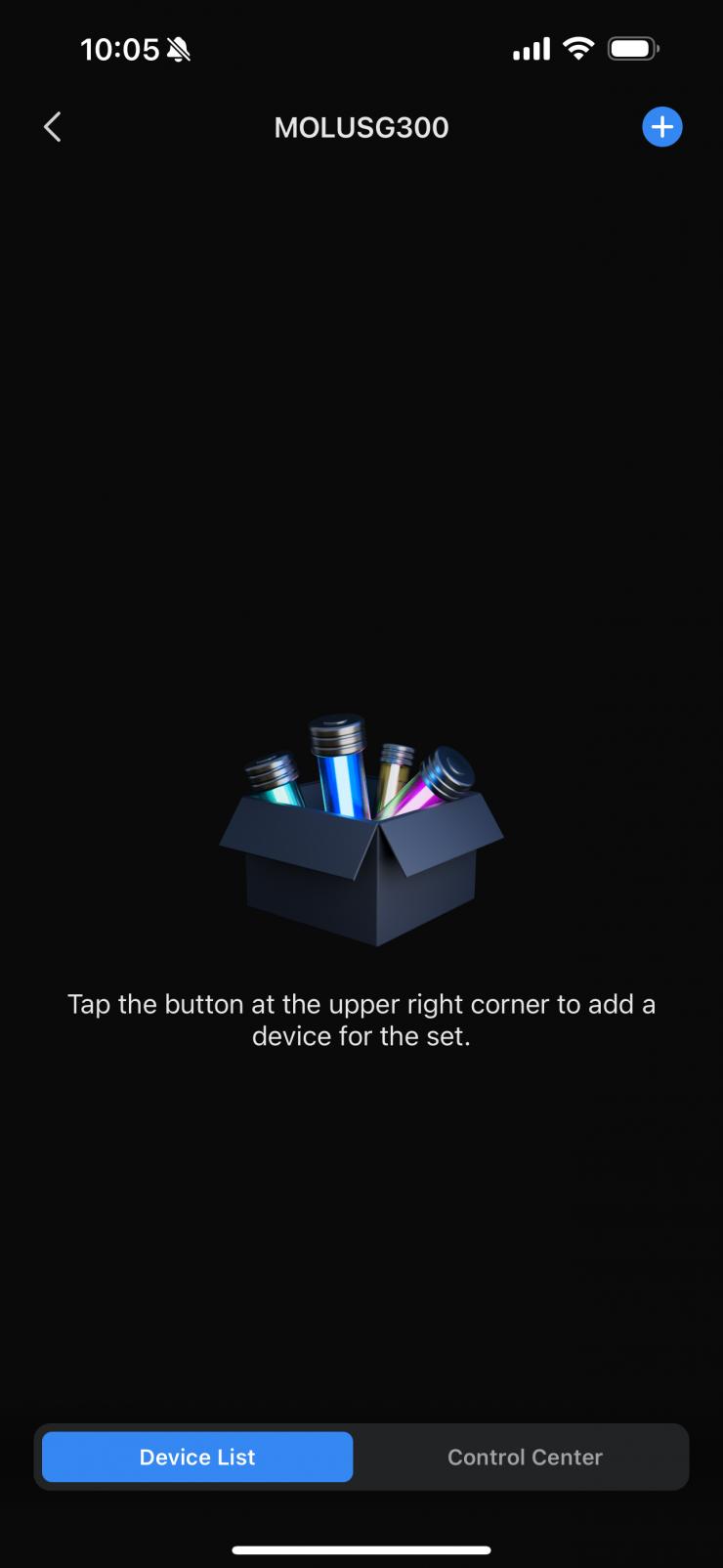
Once you have created a Set, you then add fixtures to that set.
Once you add a fixture it takes about 5-10 seconds to set it up.
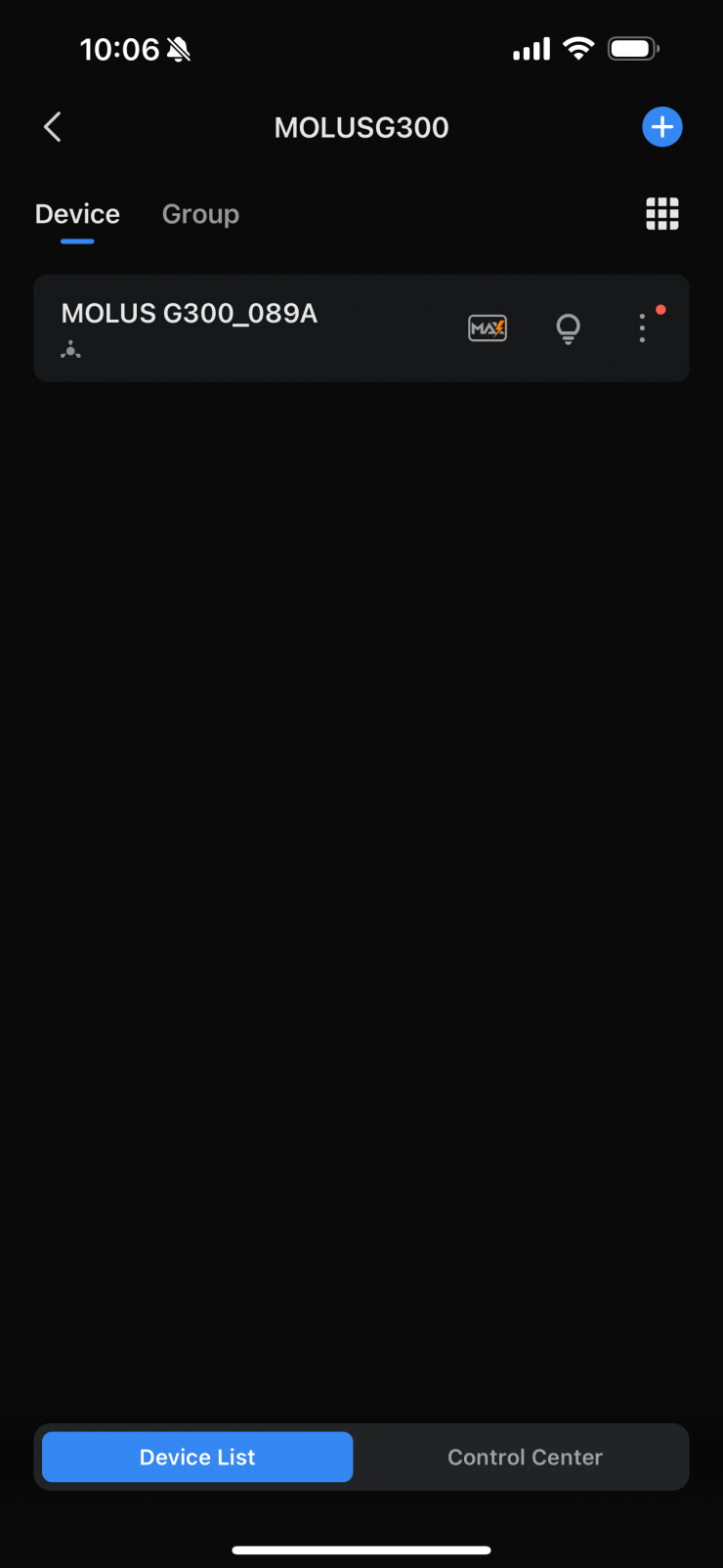
Once everything is set up the device or devices will be listed in the main window.
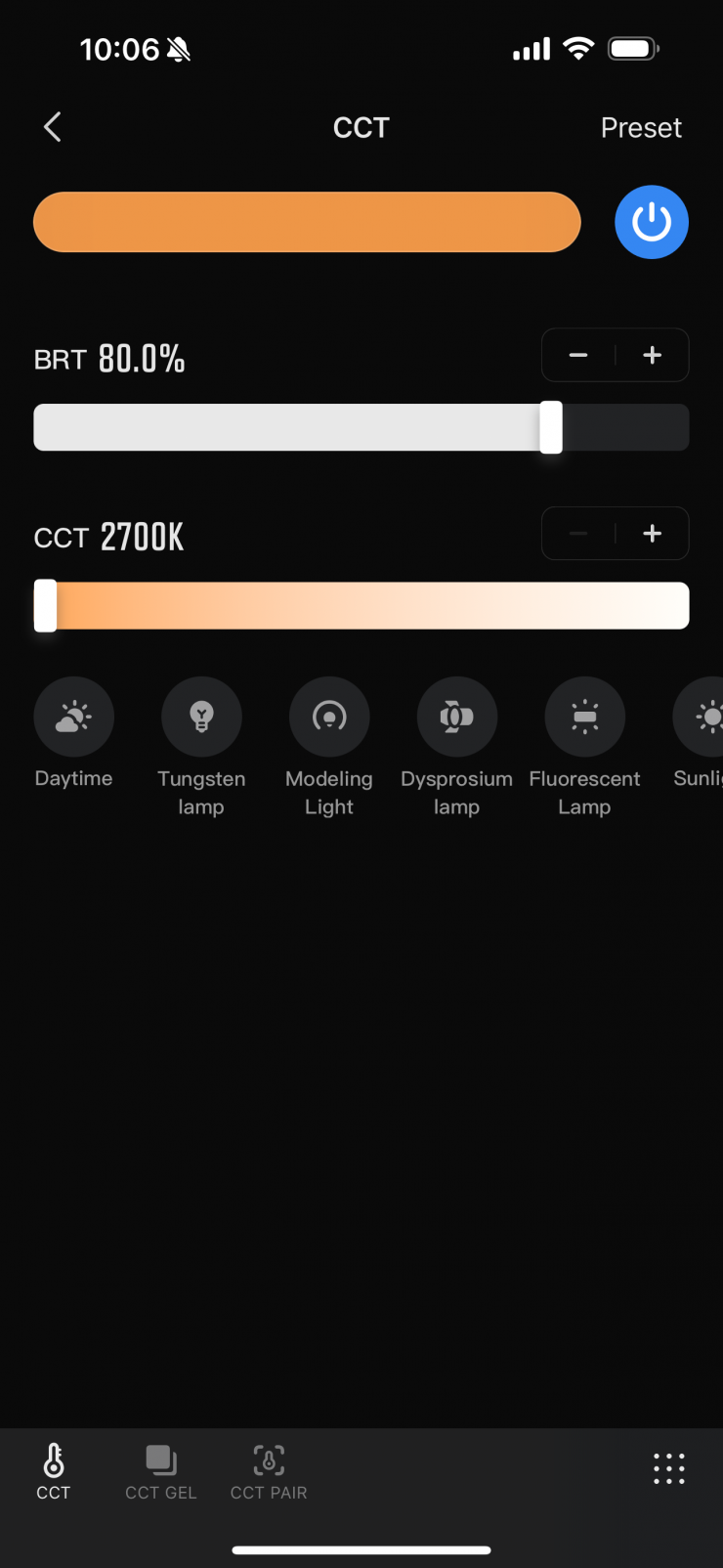
By clicking on the fixture you then get taken to the control interface. Here you can adjust the CCT and brightness. There are also options for selecting a wide array of light sources. You can’t access these modes unless you use the app.
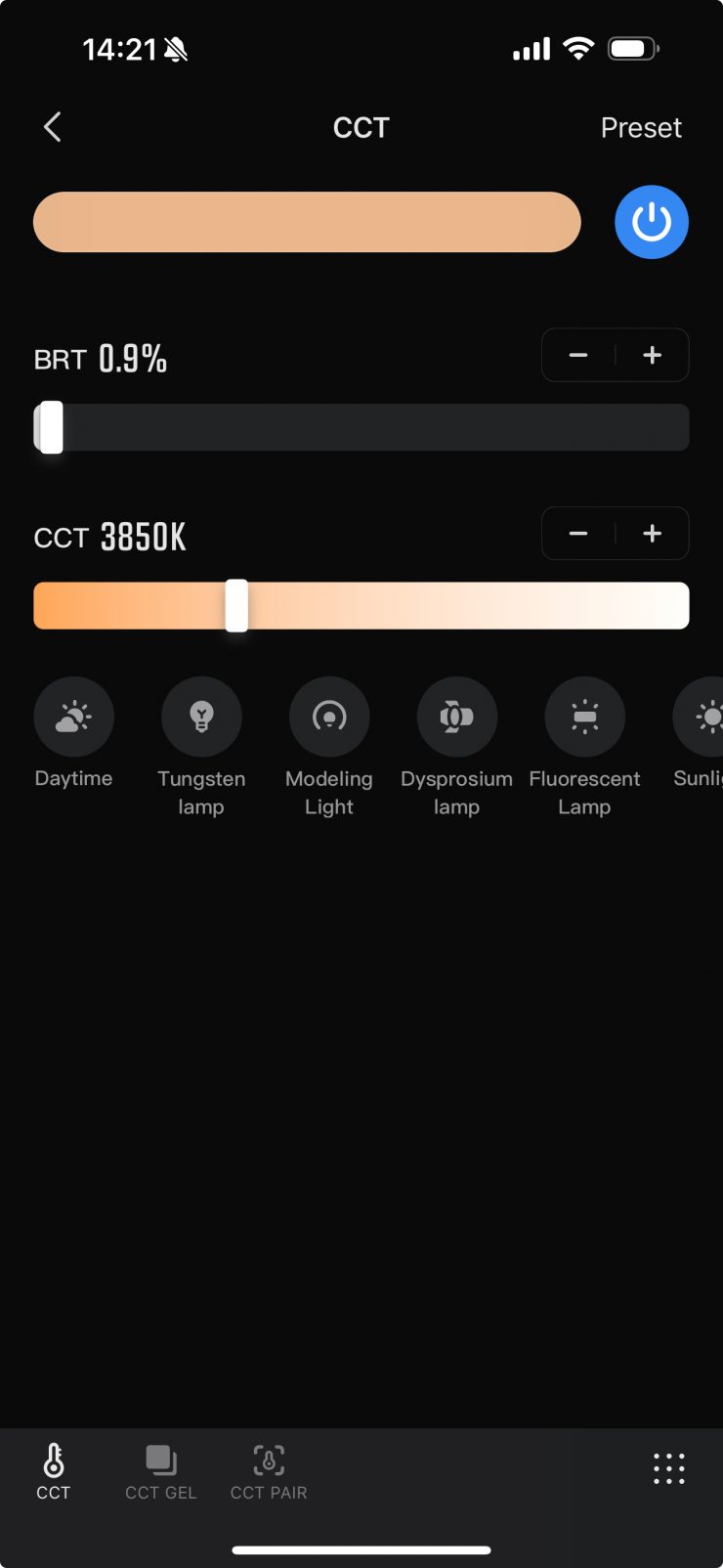
Unlike on the light itself, using the app you can adjust the brightness in increments of 0.1% and the CCT in increments of 50K.

You can also turn the MAX Extreme mode On and Off through the app.

There is also the ability to access two other modes that also can’t be accessed if you don’t use the app. The first is CCT Gel where you can apply CTO gels for Tungsten lamp or Dysprosium lamp.

The second mode is CCT Pair. In this mode, the app will ask you to access your camera. Here you can select another lighting source and press match.
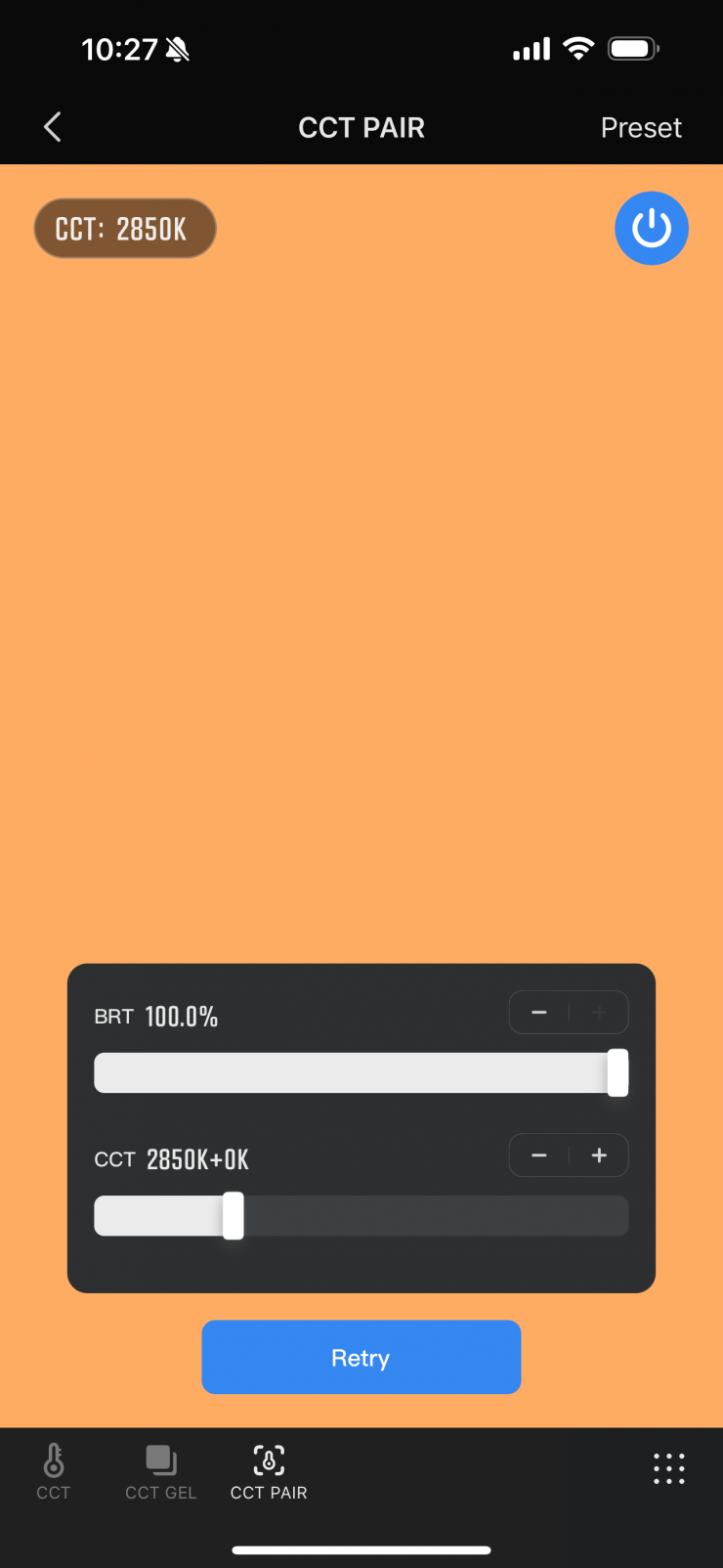
The light will then try and replicate that lighting source. You can make adjustments to that reading if you like. What you need to remember is that this is a Bi-color fixture, so it is only going to be able to replicate certain lighting sources.
The app works reasonably well and it is pretty intuitive, but because it uses Bluetooth there is a bit of lag from when you make changes on the app until you see them being reflected on the light.
Operating Modes

The light has three operating modes:
- CCT
- Music Mode
- FX Mode
There are also the hidden modes that I previously mentioned in the ZY Vega app section.
Correlated Color Temperature (CCT)
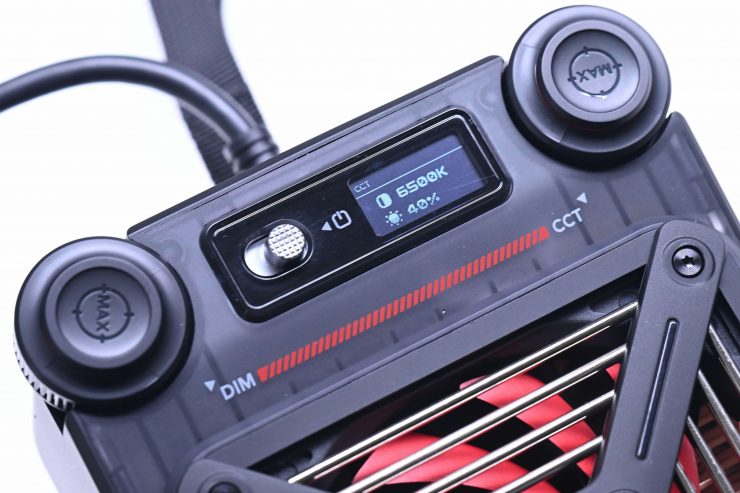
In the CCT Mode, you have full access to making CCT adjustments between 2700-6500K. This isn’t a massive adjustment range, but it will suit most people’s needs.
The fixture doesn’t feature any continuous variable (full minus green to full plus green) correction.
Music Mode
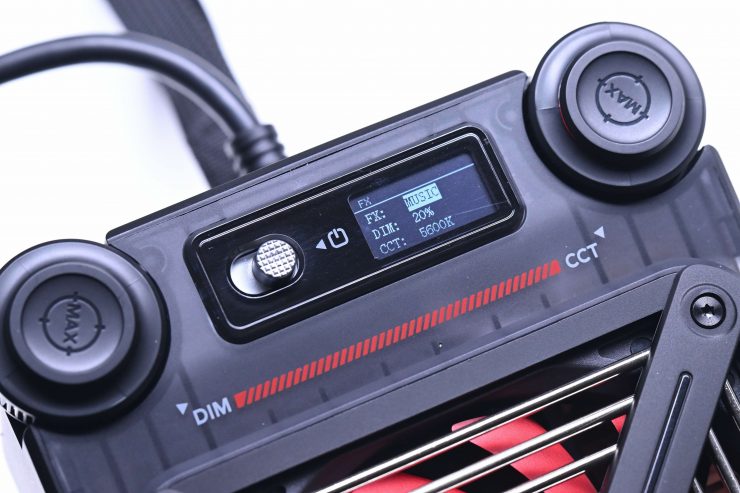
In this mode, the light uses its built-in microphones to sync to music beats.
This is useful if you are doing music videos.
To access this mode you press down and hold the CCT button.
FX Mode
In this mode you can choose from various effects.
Photometrics
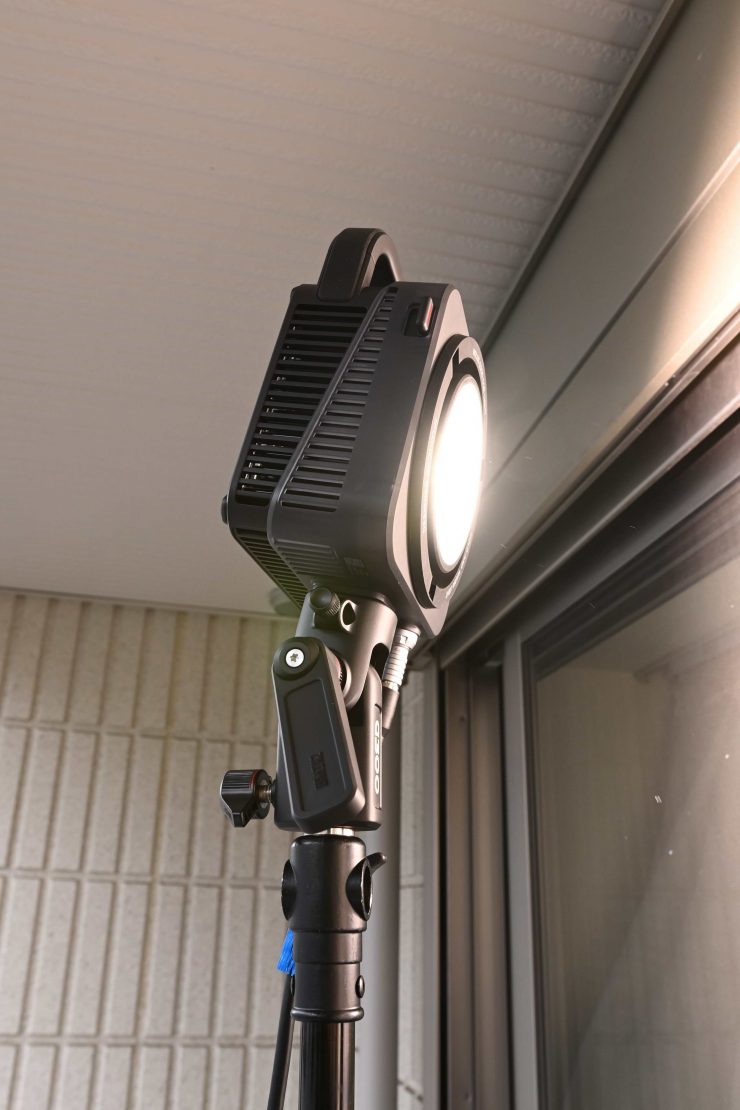
So now let’s get to the photometric results. I always test lights in this way so that I get a reference to how they compare to other fixtures. Results only tell part of the story and should never be used alone to judge a light. I have found from extensive testing over the years that certain lights that have good photometric results don’t always look good, and lights that have worse photometric scores can sometimes look better than their results indicate.
You can’t judge a light from one set of photometric results. SSI, while great, doesn’t provide you with all of the information you need. You have to look at all of the different results to be able to come to a conclusion. Judging alight on one set of results is like reading one chapter in a book and thinking you know the whole story.
Different lights can also look different depending on what camera you happen to be using.
Output & Color Temperature Accuracy

According to ZHIYUN, the MOLUS G300 is capable of outputting 15,500 lx when used open face.
As I previously mentioned, there is also a MAX Extreme mode you can activate where the light is claimed to be able to utilize 500W and output 20,300 lx when used open face. The catch with this mode, according to ZHIYUN, is that the light only works at 4300K and it will only work in this mode for a certain period of time (depending on the ambient temperature). If you turn the light off and then on again, it will default to the normal operating mode and not come back on in MAX Extreme mode.
Now, even though ZHIYUN states that this mode only works with the light at 4300K, but I was able to adjust the CCT in this mode. I left it on in its MAX Extreme mode at an ambient temperature of 26c for more than an hour and it didn’t turn off.
I tested the MOLUS G300 at a variety of CCT settings with a Sekonic C-800 Spectrometer to find out how much output the light had and how accurate the CCT reproduction was. All readings are taken at a distance of 1m (3.28ft) in a controlled environment. The readings were all taken directly from the lighting source. In the case of using the light with a Reflector or any attachment, the readings were taken from the edge of those attachments. This is how I test all lights.
So just how much output does it have? Well, let’s find out.
ZHIYUN MOLUS G300 5600K (open face)
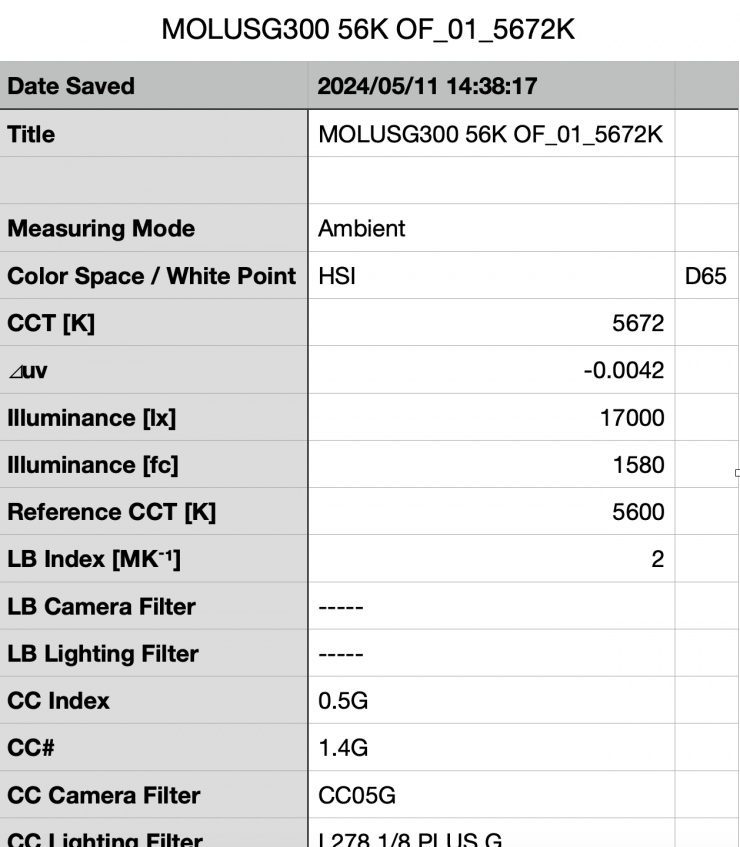
Above you can see the MOLUS G300 recorded an output of 17,000 lx (1580 fc) when set at 5600K and used open face. This was a lot of output for a light of this size with a beam angle of 105 degrees.
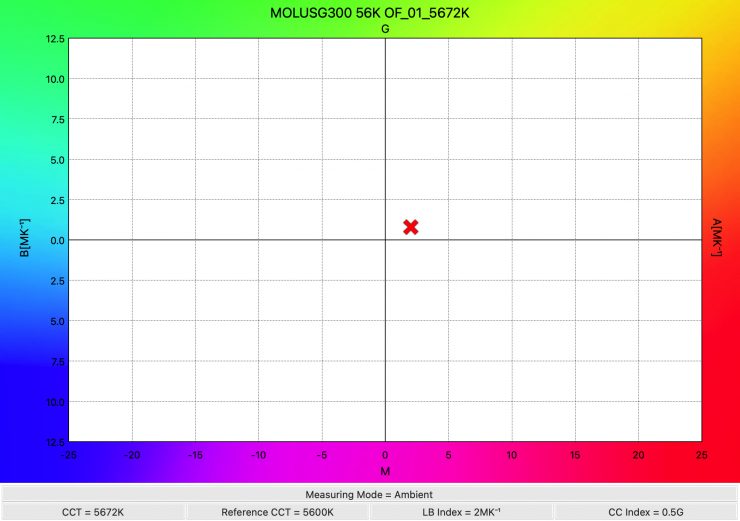
The light recorded a CCT reading of 5672K which was a pretty good result.
ZHIYUN MOLUS G300 3200K (open face)
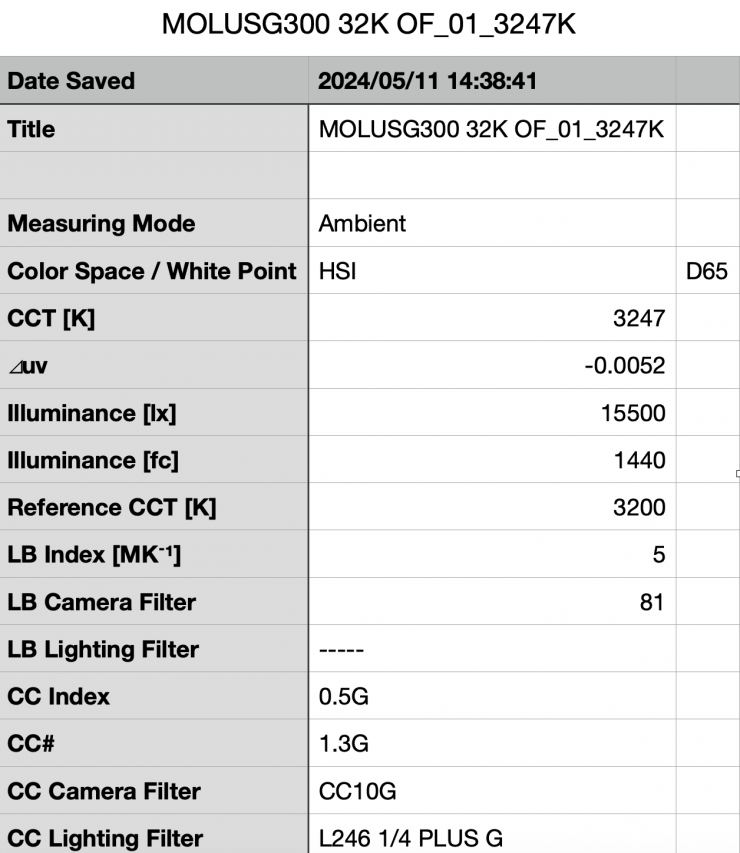
Above you can see the light’s output when it was set at 3200K in the open face configuration was 15,500 lx (1440 fc), which was 9.67% less than it produced at 5600K.
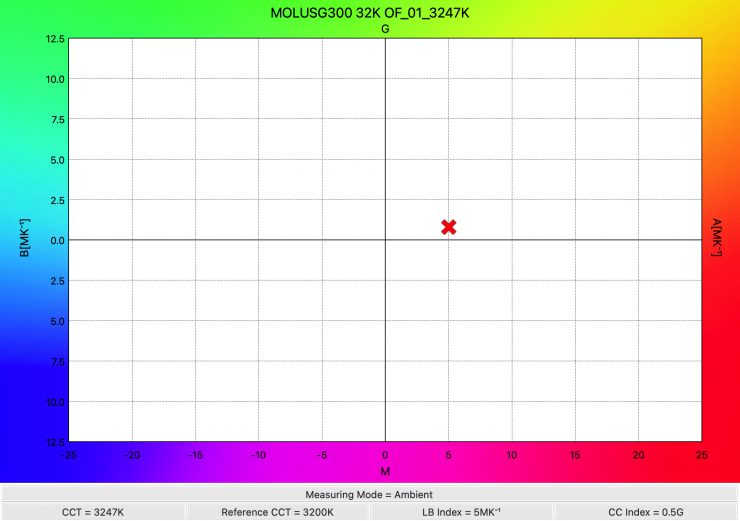
As far as CCT accuracy goes, it recorded a very good reading of 3247K.
ZHIYUN MOLUS G300 5600K Reflector
Now, that we have seen some results when it was used open face, what happens if we use it with the included reflector?
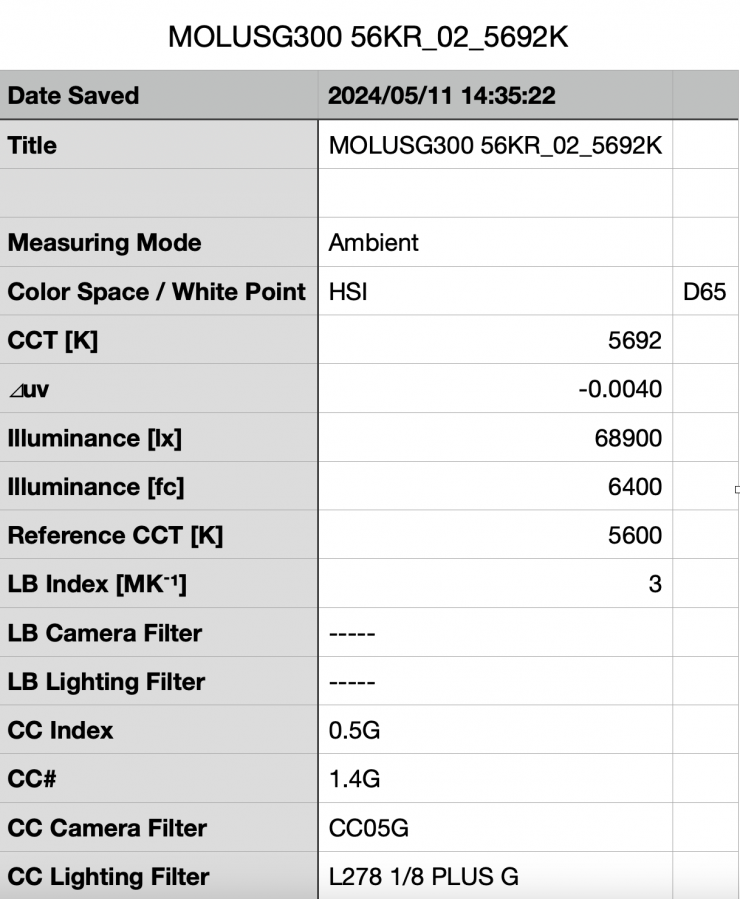
Above you can see the light’s output when it was set at 5600K with its reflector was 68,900lx (6400 fc), which was 310.58% more than it produced when used open face.
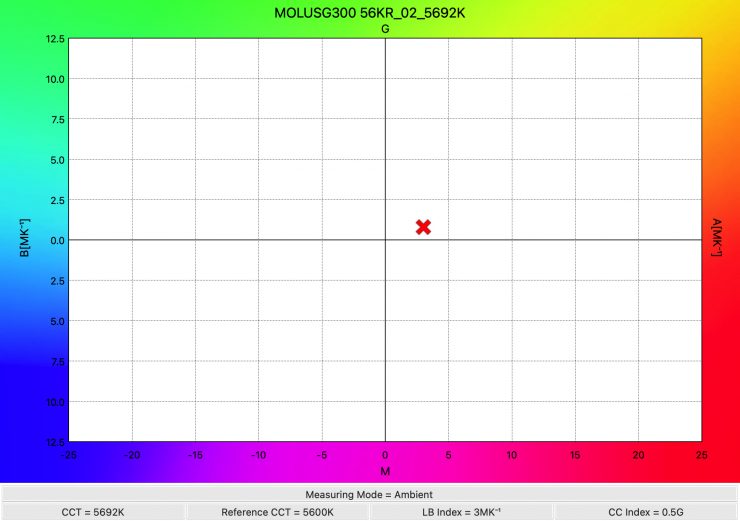
As far as CCT accuracy goes, it recorded a reading of 5692K, which wasn’t that much difference from the 5672K it recorded when used open face. This clearly tells me that the reflector doesn’t alter the CCT when used at 5600K.
ZHIYUN MOLUS G300 3200K Reflector
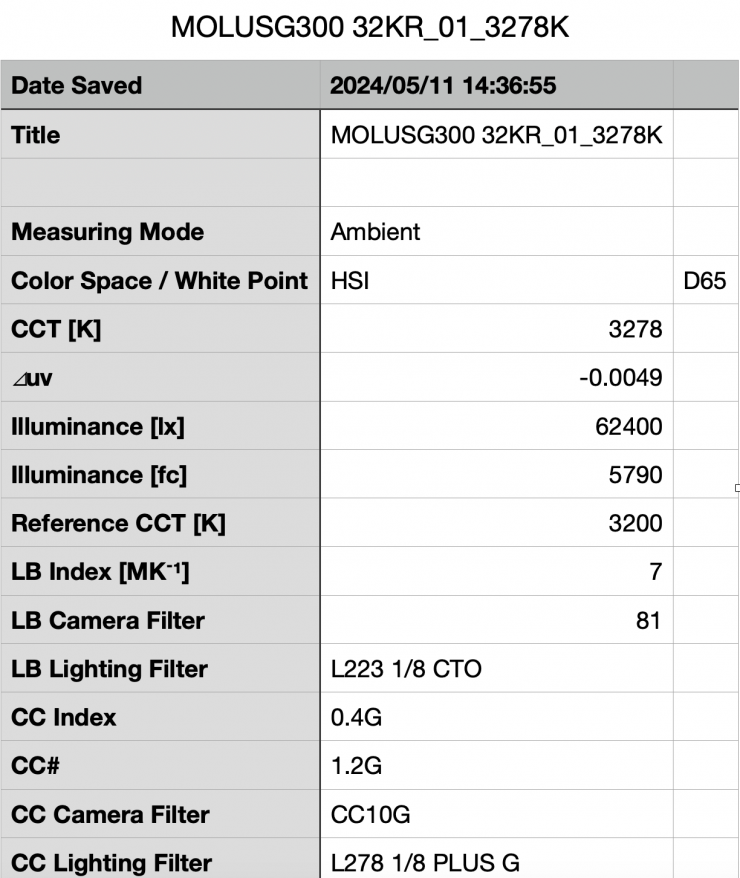
Above you can see the light’s output when it was set at 3200K using its reflector was 62,400 lx (5790 fc), which was 11.85% less than it produced at 5600K.
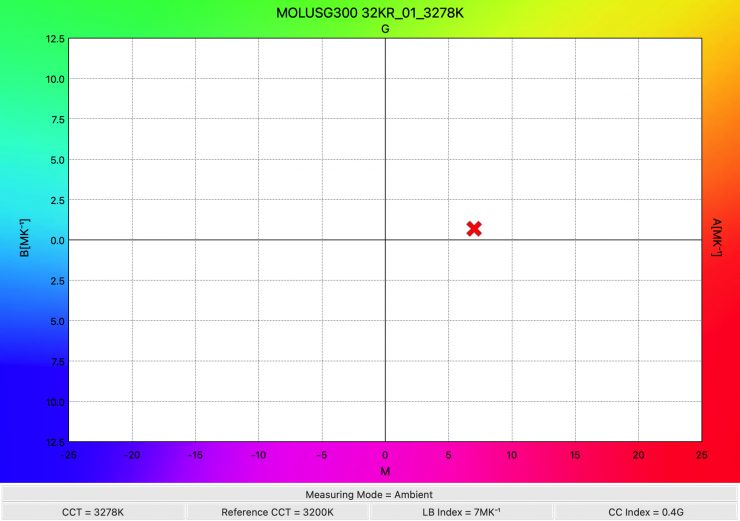
As far as CCT accuracy goes, it recorded a reading of 3278K which wasn’t too far off the 3247K it produced when used open face.
This tells me that the reflector doesn’t alter the CCT too much when used at 3200K.
ZHIYUN MOLUS G300 4300K Reflector (MAX Extreme Mode)
Now, that we have seen some results when it was used open face and with its reflector, what happens if we turn on the MAX Extreme mode?
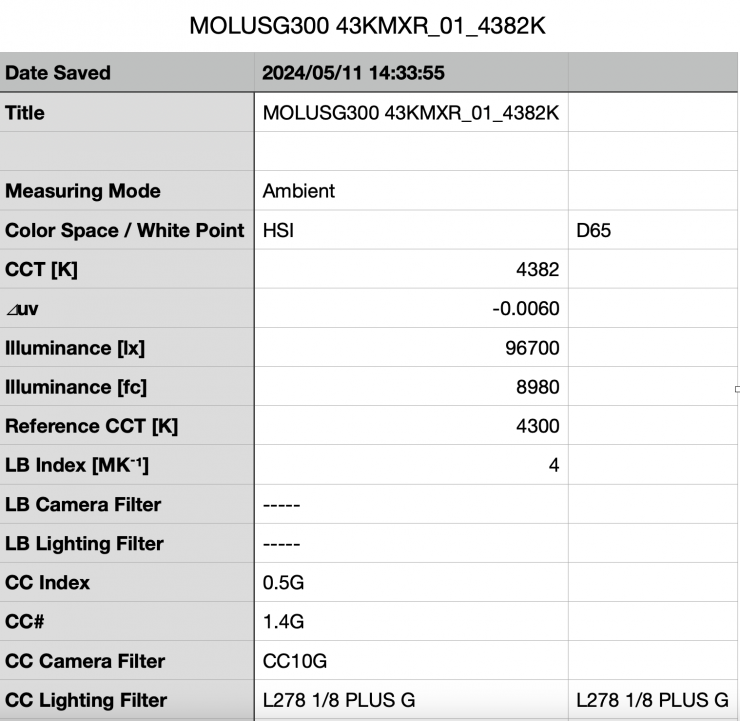
Above you can see the light’s output when it was set at 4300K with its reflector in the MAX output mode was 96,700 lx (8980 fc), which was 38.53% more than it produced when used with its reflector in the normal mode.
97,700 lx is a ton of output from a light of this size. As a comparison, the Nanlite FS-300B puts out 43,200 lx at the same distance using its 55-degree reflector when set at 4500K. In saying this, you do have to factor in the higher power draw of the MOLUS G300.
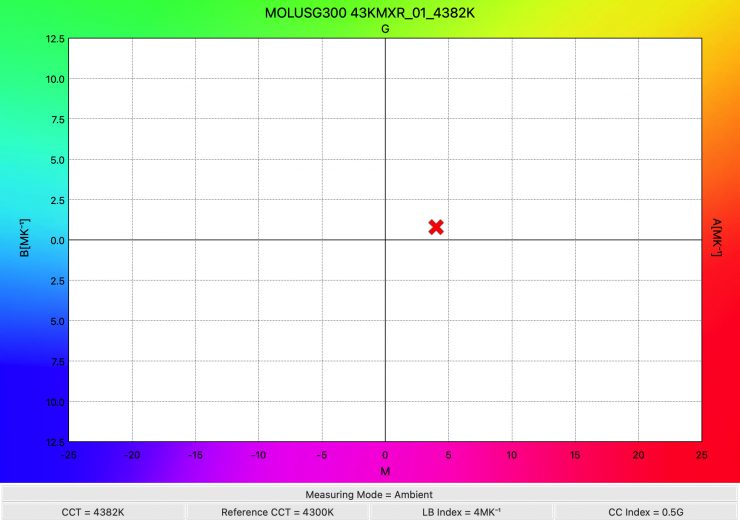
As far as CCT accuracy goes, it recorded a reading of 4382K, which was a decent result. This shows me that running the light in its MAX output mode doesn’t”t have any adverse effect on the CCT accuracy.
ZHIYUN MOLUS G300 3200K Reflector (MAX Extreme Mode)
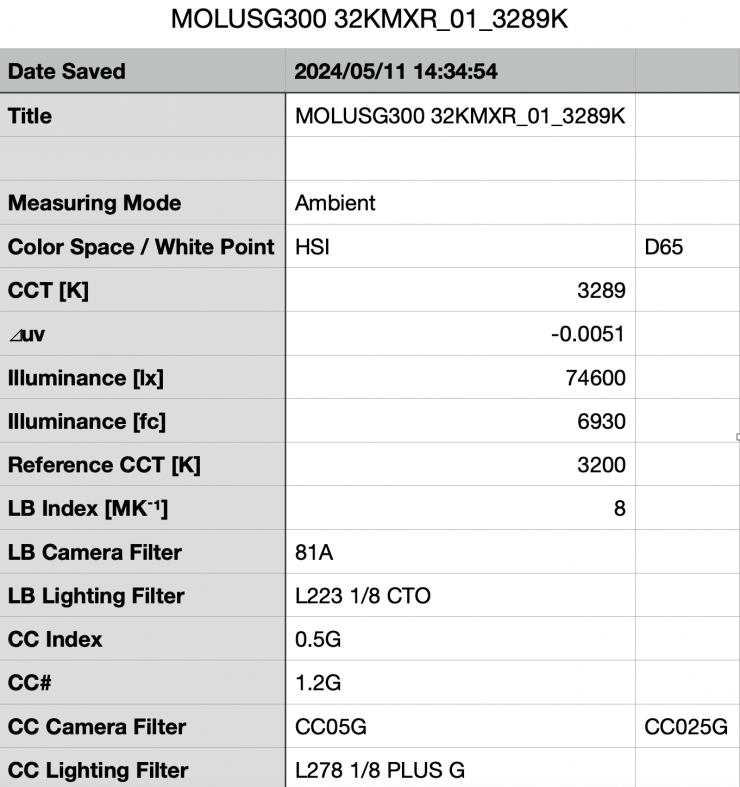
Above you can see the light’s output when it was set at 3200K with its reflector in the MAX Extreme mode was 74,600 lx (6930 fc).
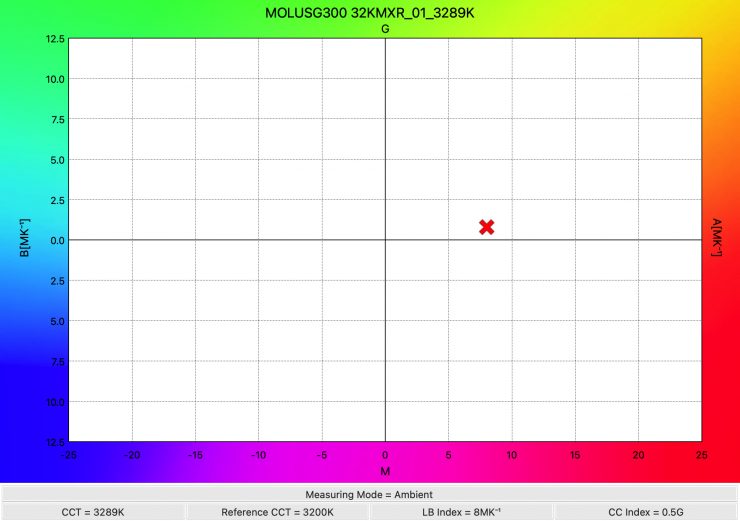
As far as CCT accuracy goes, it recorded a reading of 3289K.
ZHIYUN MOLUS G300 5600K Reflector (MAX Extreme Mode)
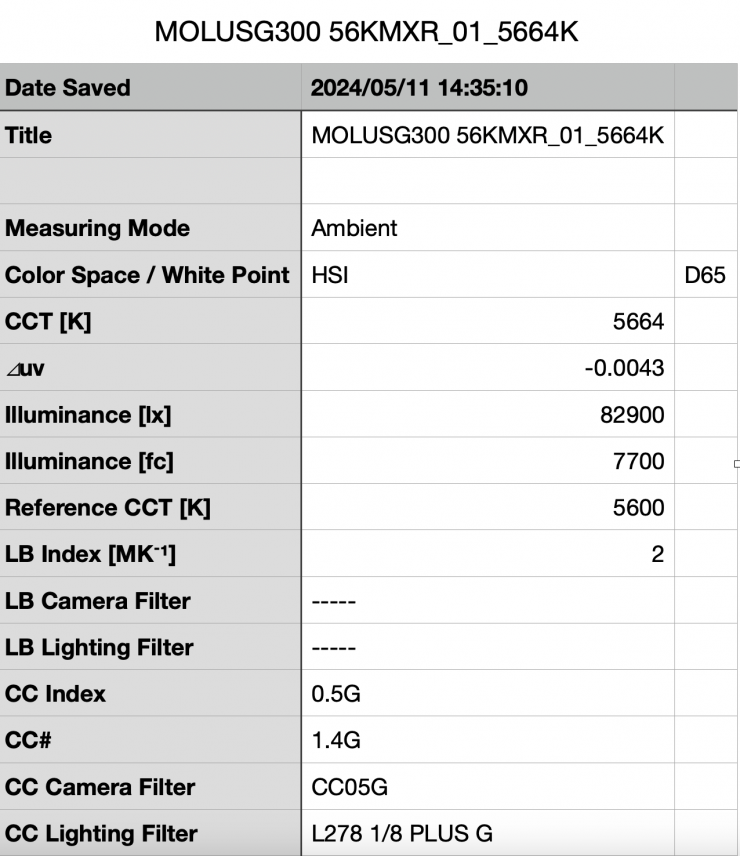
Above you can see the light’s output when it was set at 5600K with its reflector in the MAX Extreme mode was 82,900 lx (7700 fc).
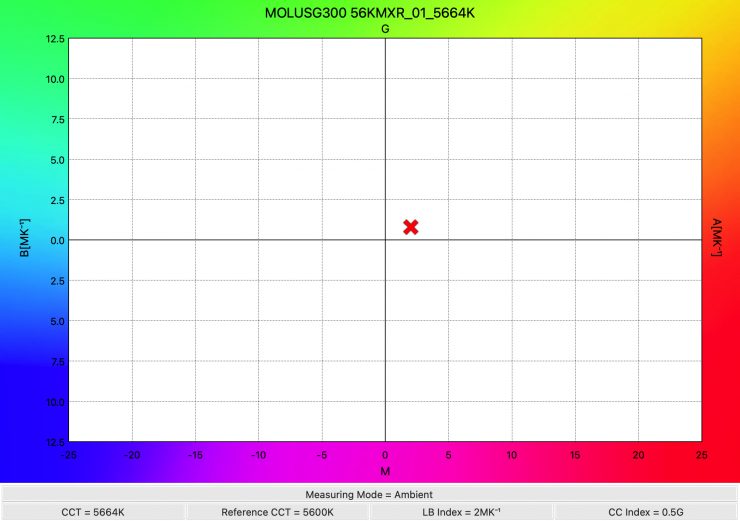
As far as CCT accuracy goes, it recorded a reading of 5664K.
ZHIYUN MOLUS G300 4300K (MAX Extreme Mode) DoPChoice Octa 3 Softbox
I wanted to test how much output the MOLUS G300 had when used with a DoPChoice Octa 3 softbox at a distance of 1m / 3.3′. The measurement was taken at this distance from the softbox and not the light head.
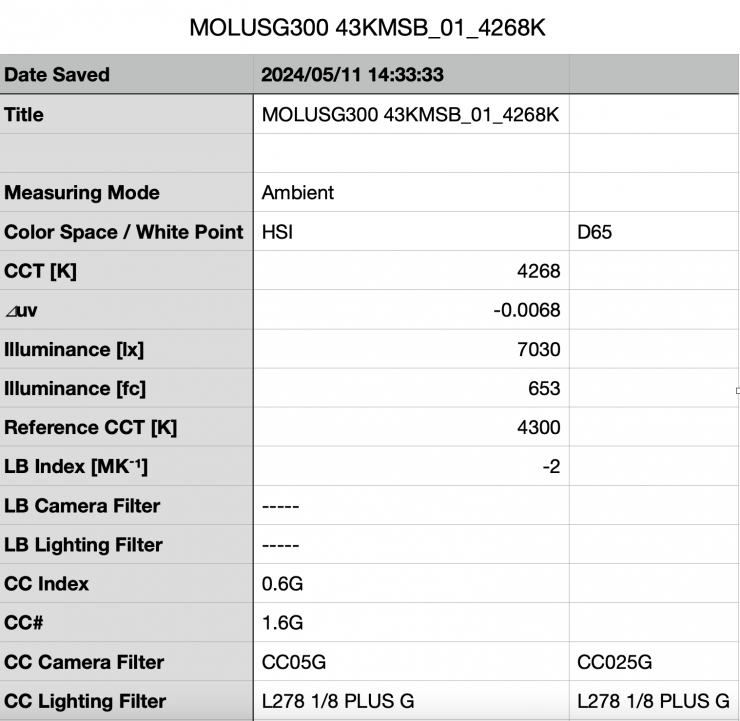
Above you can see the light’s output when it was set at 4300K in its MAX Extreme mode and using a DoPChoice Octa 3 Soft Box was 7030 lx (653 fc).
7030 lx is a good amount of output when using a large softbox.
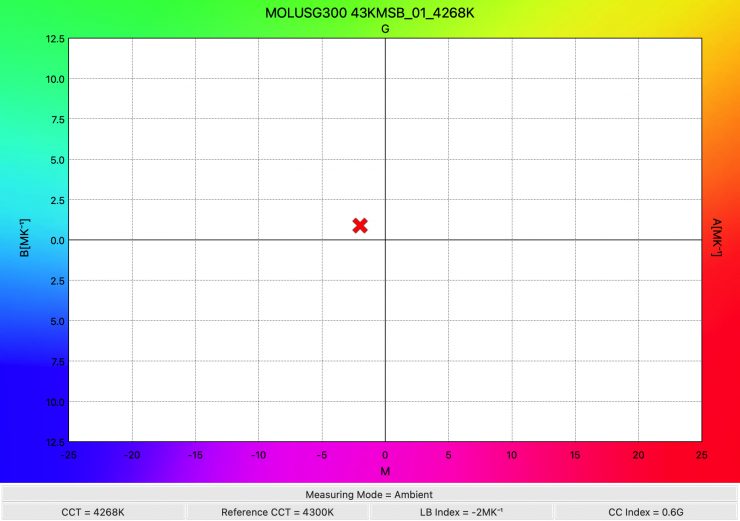
As far as CCT accuracy goes, it recorded a reading of 4286K which was almost perfect.
ZHIYUN MOLUS G300 5600K DoPChoice Octa 3 Softbox
I also wanted to test how much output the MOLUS G300 had when used with a DoPChoice Octa 3 softbox at a distance of 1m / 3.3′ when set at 5600K with the MAX output mode turned off. The measurement was taken at this distance from the softbox and not the light head.
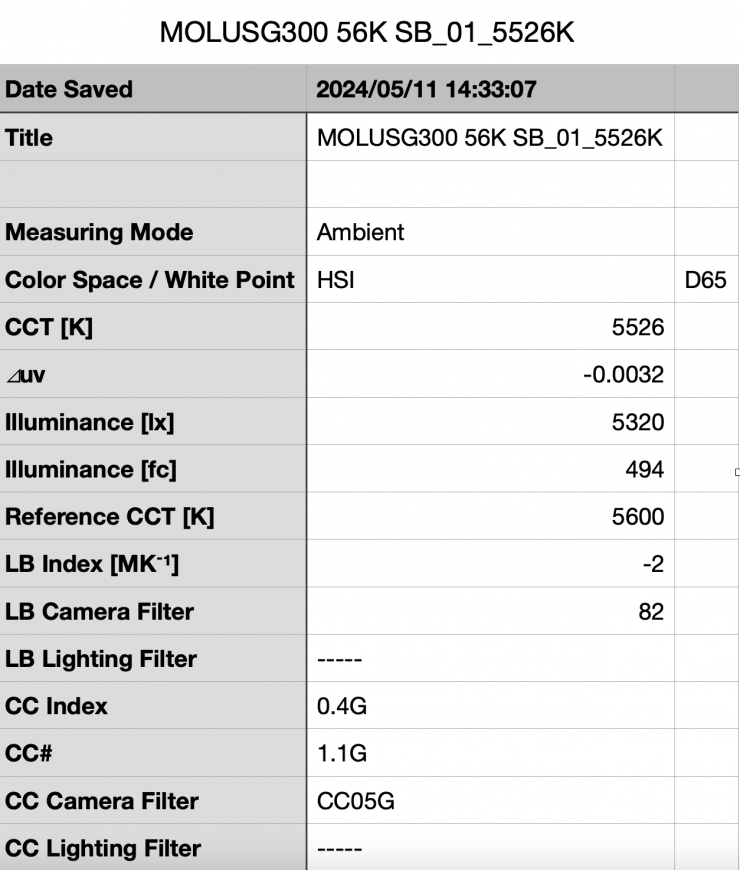
Above you can see the light’s output when it was set at 5600K in its normal output mode and using a DoPChoice Octa 3 Softbox was 5320 lx (494 fc).
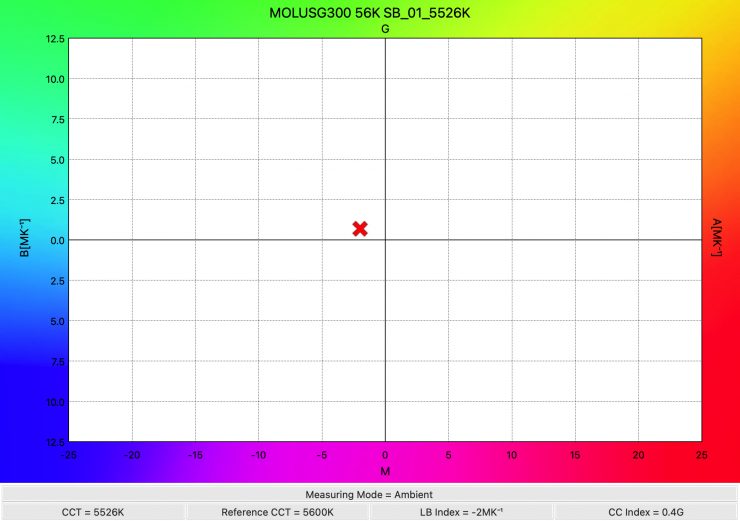
As far as CCT accuracy goes, it recorded a reading of 5526K which was pretty good.
ZHIYUN MOLUS G300 3200K DoPChoice Octa 3 Softbox
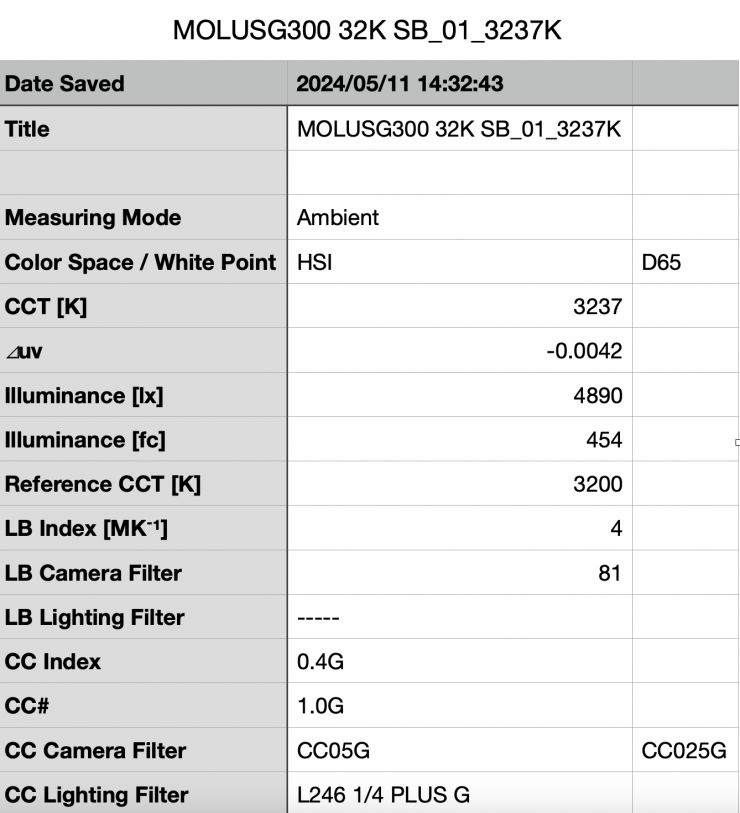
Above you can see the light’s output when it was set at 5600K in its normal output mode and using a DoPChoice Octa 3 Softbox was 4890 lx (454 fc).
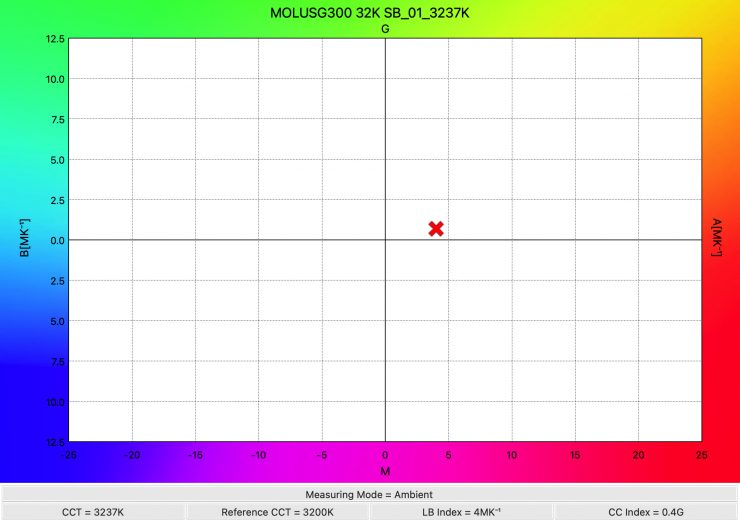
As far as CCT accuracy goes, it recorded a reading of 3237K which was very good.
Output Comparison against the Nanlite FS-300B & Aputure LS 300x
| SETTING | OUTPUT | |
| ZHIYUN MOLUS G300 | 4300K | 96,700 lx* |
| Nanlite FS-300B | 4500K | 43,200 lx |
| Aputure LS 300x | 4500K | 22,300 lx |
*Boost mode
So as a comparison, how does this output compare to the Nanlite FS-300B and Aputure LS 300x when they are used with their reflectors? Well, above you can see. The ZHIYUN MOLUS G300 has considerably more output, however, it also draws a lot more power.
| OUTPUT @3200K | OUTPUT @5600K | |
| ZHIYUN MOLUS G300 | 74,600 lx* | 82,900 lx* |
| Nanlite FS-300B | 37,200 lx | 37,400 lx |
| Aputure LS 300x | 15,100 lx | 17,500 lx |
*Boost mode
Just to be fair to all the lights, let’s also look at the output at 3200K and 5600K. As you can see, the ZHIYUN has considerably more output than both of these other lights, but again, it has a much higher power draw.
How does it perform at various CCT Settings?
Summary of results (Reflector)
| SETTING | OUTPUT | CCT READING |
| 2700K | 57,000 lx | 2766K |
| 3200K | 62,400 lx | 3278K |
| 4500K | 68,300 lx | 4595K |
| 5600K | 68,900 lx | 5692K |
| 6500K | 68,100 lx | 6582K |
These results show me that the light’s output varies by 20.8% depending on what CCT temperature you are using between 2700-6500K. However, between 3200-6500K the output only varies by 10.41%.
The CCT accuracy across the range is very good. It was no more than 95K off at any reading which tells me the light has very good CCT consistency across its range.
CCT consistency & linear output when dimming the light
Now, what you should always do when testing lights is to see if the CCT remains consistent when dimming the light. Just because you set a light at say 5600K, that doesn’t mean that the CCT will remain stable as you start dimming the fixture down. I also wanted to see how linear the dimming curve was.
I decided to do a series of tests at 100%/75%/50%/25%10% to see if the CCT being recorded changed. This was done at a distance of 1m using a Sekonic C-800. These tests were done at 5600K using the standard reflector.
| CCT READING | OUTPUT | INTENSITY % |
| 5674K | 68,900 lx | 100 |
| 5727K | 53,400 lx | 75 |
| 5787K | 37,200 lx | 50 |
| 5900K | 19,800 lx | 25 |
| 5847K | 9190 lx | 10 |
The ZHIYUN MOLUS G300’s CCT consistency wasn’t great, but it wasn’t terrible either. As you start dimming the fixture down the CCT changes. My testing showed that the CCT readings varied by 173K.
As far as how linear the output is when you start dimming the light, at 50% output it had 46.00% less output than when used at 100%. At 25% it had 71.26% less output than when used at 100%. At 10% output, it had 86.66% less output than when used at 100%. This shows me that the light’s dimming curve is reasonably linear.
Color Rendering
So now that we have seen how much output the ZHIYUN MOLUS G300 produces, how does it perform when it comes to replicating accurate colors?
ZHIYUN MOLUS G300 5600K (Reflector)
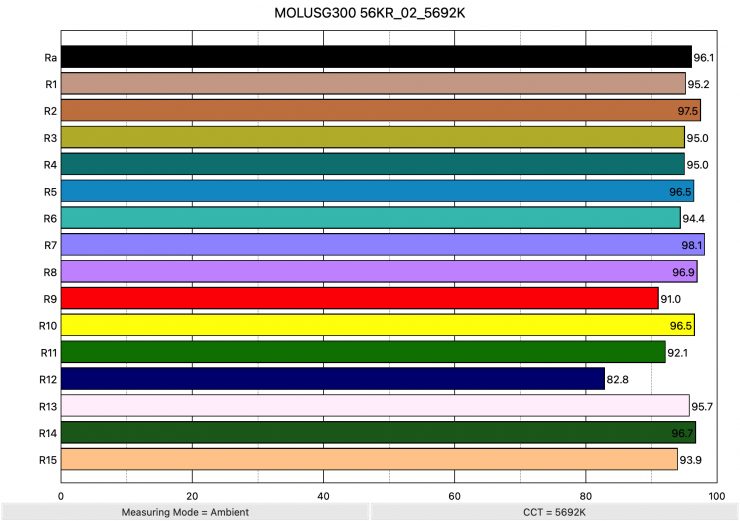
Above you can see that when the light was set at 5600K and used with its reflector, recorded an average CRI (R1-R8) of 96.1 and an extended CRI (R1-R15) of 94.48. For replicating accurate skin tones it recorded for R9 91.0 (red), 95.7 for R13 (closest to caucasian skin tones), and 93.9 for R15 (closest to Asian skin tones). These were decent results, and only R12 (Blue), was under 90.
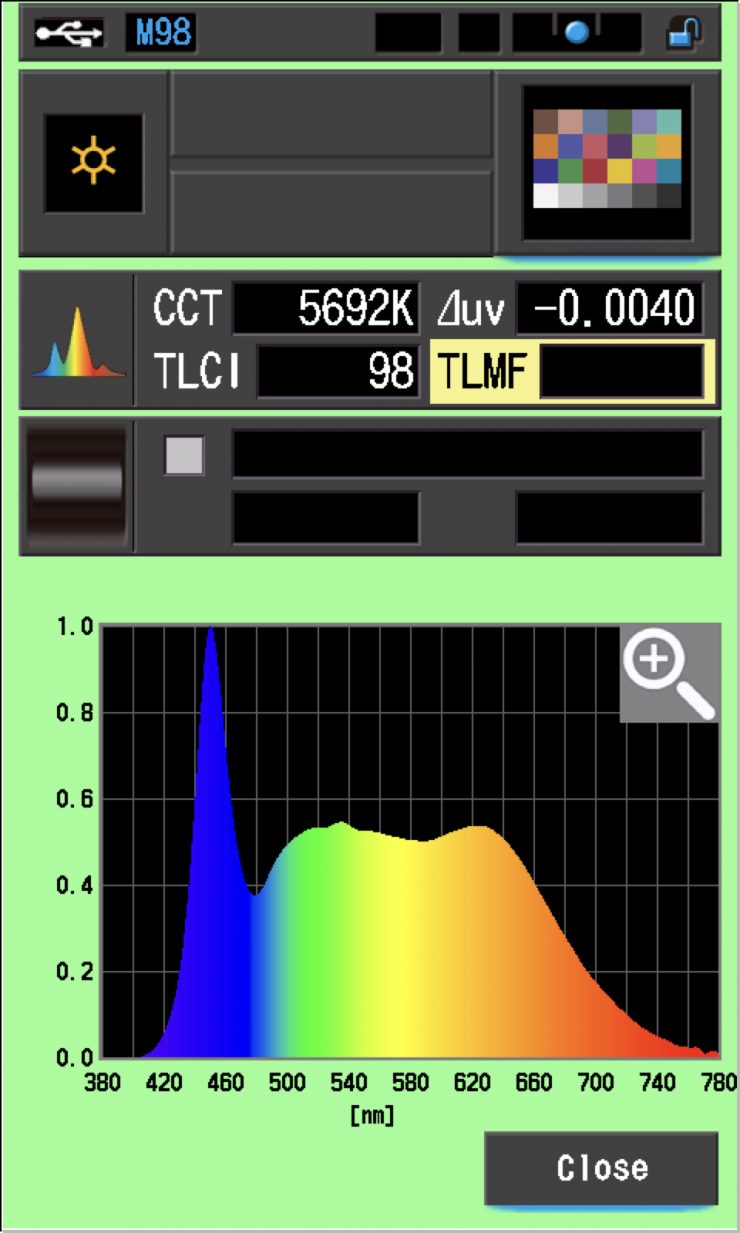
The ZHIYUN MOLUS G300 when set at 5600K recorded a TLCI score of 98. This was a good result.
ZHIYUN MOLUS G300 3200K (Reflector)
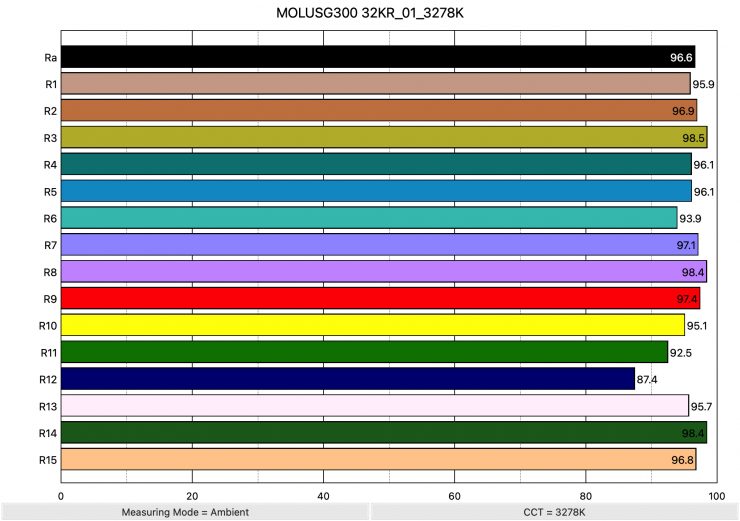
Above you can see the scores for when the light was used at 3200K. It recorded an average CRI (R1-R8) of 96.6 and an extended CRI (R1-R15) of 95.74. For replicating accurate skin tones it recorded 97.4 for R9 (red), 95.7 for R13 (closest to caucasian skin tones), and 96.8 for R15 (closest to Asian skin tones). These were good results. Only R12 was below 90, but not by much.
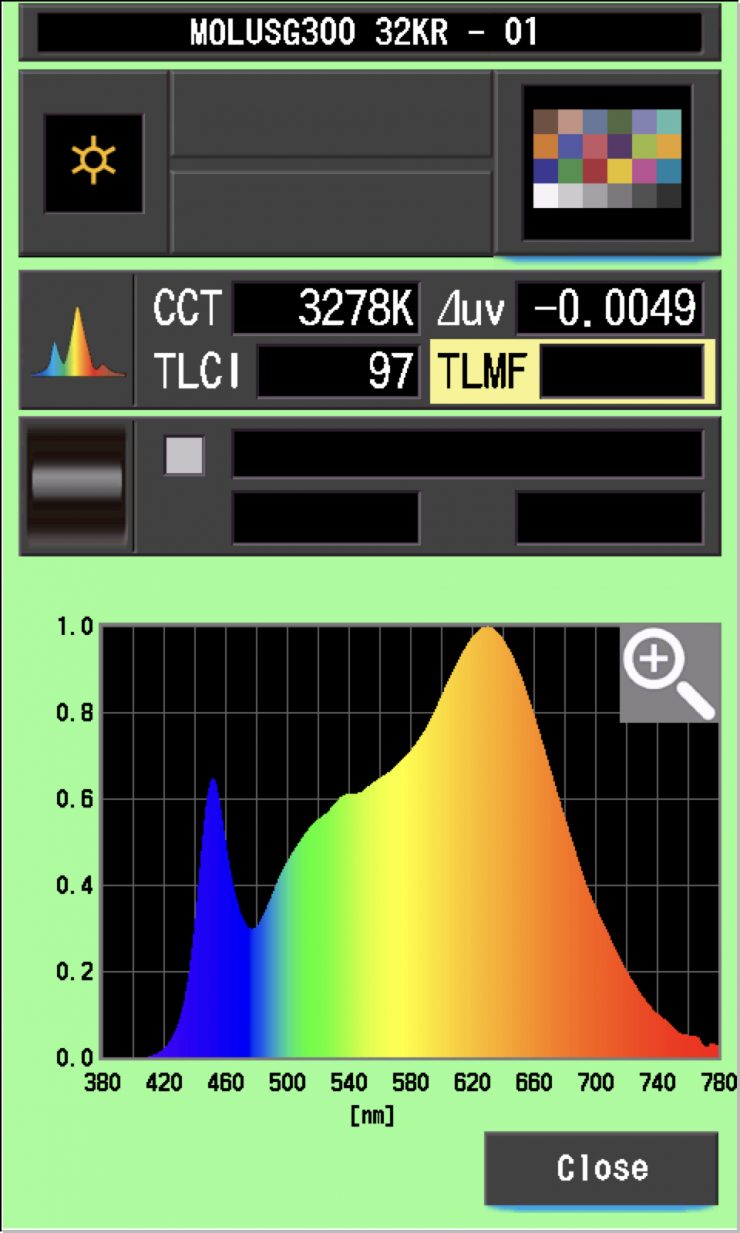
The ZHIYUN MOLUS G200, when set at 3200K recorded a TLCI score of 97.
Color Rendering Comparison against the Nanlite FS-300B & Aputure LS 300x
5600K
| CCT READING | EXTENDED CRI | |
| ZHIYUN MOLUS G300 | 5592K | 94.48 |
| Nanlite FS-300B | 5807K | 95.66 |
| Aputure LS 300x | 5295K* | 95.97 |
*tested at 5500K
3200K
| CCT READING | EXTENDED CRI | |
| ZHIYUN MOLUS G300 | 3278K | 95.74 |
| Nanlite FS-300B | 3215K | 96.24 |
| Aputure LS 300x | 3144K | 96.08 |
So as a comparison, how does this color rendering compare to the Nanlite FS-300B and Aputure LS 300x when they are used with their reflectors? Well, above you can see that all of the lights have almost identical scores.
ZHIYUN MOLUS G300 5600K (Open Face)
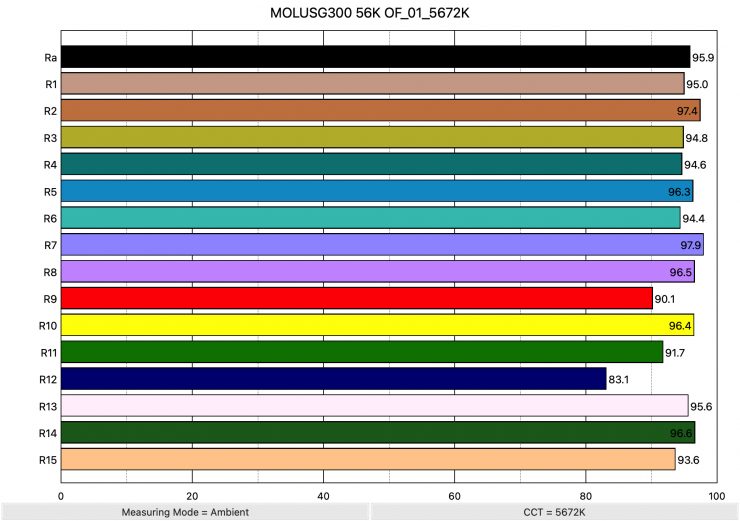
Above you can see that when the light was set at 5600K and used open face recorded an average CRI (R1-R8) of 95.9 and an extended CRI (R1-R15) of 94.26. For replicating accurate skin tones it recorded for R9 90.1 (red), 95.6 for R13 (closest to caucasian skin tones), and 93.6 for R15 (closest to Asian skin tones). These were decent results, and only R12 (Blue), was under 90.
What was good to see is that the color rendering scores were basically identical whether you use the light with its reflector or open-faced.
ZHIYUN MOLUS G300 3200K (Open Face)
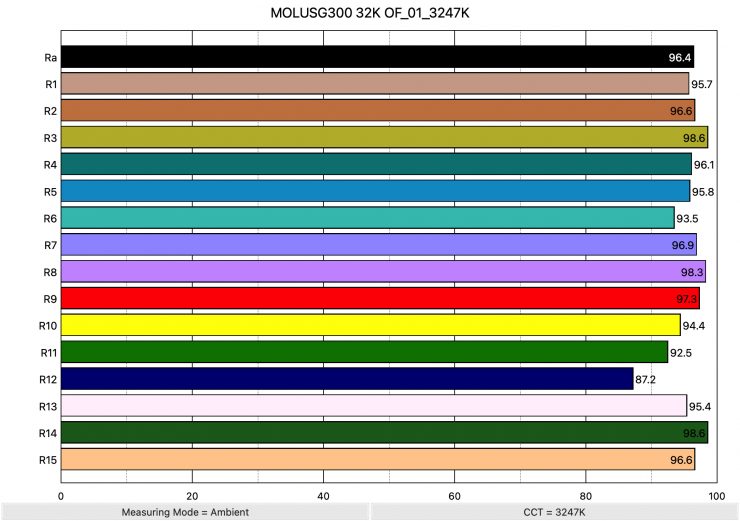
Above you can see that when the light was set at 3200K and used open face it recorded an average CRI (R1-R8) of 96.4 and an extended CRI (R1-R15) of 95.56. For replicating accurate skin tones it recorded for R9 97.3 (red), 95.4 for R13 (closest to caucasian skin tones), and 96.6 for R15 (closest to Asian skin tones). These were good results, with only R12 (Blue) being slightly below 90.
Again, the results were very consistent when using the light with or without its reflector. When used Open Faced it did have a slightly better score than when used with its reflector, but not by much.
ZHIYUN MOLUS G300 4300K Reflector (MAX Extreme mode) Mode)
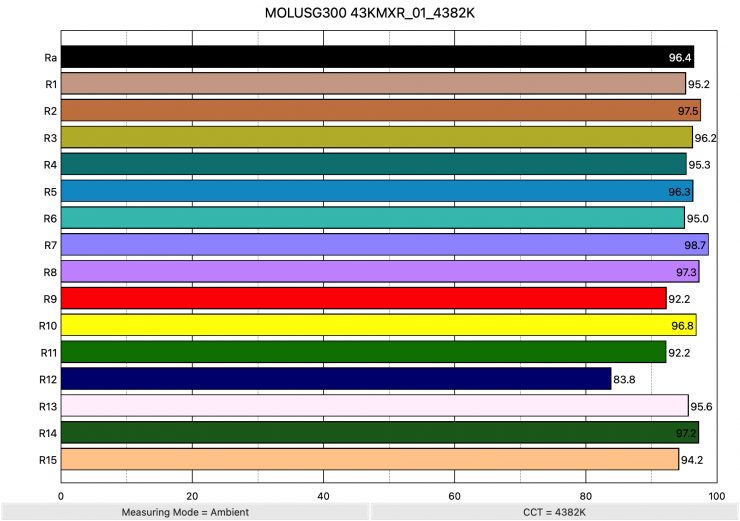
Above you can see that when the light was set at 4300K and used with its reflector in its MAX Extreme mode recorded an average CRI (R1-R8) of 96.4 and an extended CRI (R1-R15) of 94.9. For replicating accurate skin tones it recorded for R9 92.2 (red), 95.6 for R13 (closest to caucasian skin tones), and 94.2 for R15 (closest to Asian skin tones). These are good results, and only R12 (Blue), was under 90.
What this shows me is that the color rendering scores are still very good even when using the light in the MAX Extreme mode.
CC Index & ⊿uv
The CC Index displays the CC correction value and whether any magenta or green need to be added or subtracted. 1 CC corresponds to 035 Kodak CC values or 1/8 Rosco filter values. Any reading less than +1.00 or -1.00 and you’re probably not going to need to make any kind of adjustment. The ⊿uv is the value to show how much this light is away from being an ideal light source (black body radiation = incandescent lamp). As with the CC Index you want this number to theoretically be zero. Kelvin is not a linear value, so we need to convert from Kelvin to MK-1 to compare the values of color temperature. To calculate from Kelvin to Mired is MK-1= 1*1000000/Kelvin. While this may sound confusing, it is the only way of measuring if the Kelvin shift is significant enough to warrant having to use a filter for correction. Below are the results for the ZHIYUN MOLUS G300:
ZHIYUN MOLUS G300 Kelvin Vs MK-1
| Kelvin | Difference in K | MK-1 | Difference in MK-1 | |
| SET VALUE | 2700K | 0 | 370.37 | 0 |
| ACTUAL READING | 2766K | 66 | 361.53 | 8.84 MK-1 |
| SET VALUE | 3200K | 0 | 312.5 | 0 |
| ACTUAL READING | 3278K | 78 | 305.06 | 7.44 MK-1 |
| SET VALUE | 4500K | 0 | 222.22 | 0 |
| ACTUAL READING | 4595K | 95 | 217.62 | 4.6 MK-1 |
| SET VALUE | 5600K | 0 | 178.57 | 0 |
| ACTUAL READING | 5692K | 92 | 175.68 | 2.89 MK-1 |
| SET VALUE | 6500K | 0 | 158.84 | 0 |
| ACTUAL READING | 6582K | 82 | 151.92 | 6.92 |
These figures might look confusing, but what it tells me is that the light is reasonably CCT accurate across its 2700-6500K range. Any MK-1 score that is under -9/9 means you wouldn’t have to use any color correction gels. Any MK-1 score that is under -6/6 is a very good result.
Ok, now let’s look at the CC INDEX & ⊿uv.
ZHIYUN MOLUS G300 CC INDEX & ⊿uv
| CC INDEX | ⊿uv | |
| 2700K | 0..0 | 0.0004 |
| 3200K | 0.4G | -0.0049 |
| 4500K | 0.5G | -0.0062 |
| 5600K | 0.5G | -0.0040 |
| 6500K | 0.4G | -0.0012 |
These weren’t great results, but they were still pretty decent. The light certainly does lean magenta from 3200-6500K, but the amount isn’t high enough to be of any big concern.
TM-30
TM-30 is a relatively new color rendering standard that was developed to deal with the limitations of CRI. TM-30 looks at 99 individual colors. These 99 colors are categorized into seven groups: nature, skin color, textiles, paints, plastics, printed material, and color systems.
TM-30 scores go from 0 – 100. The higher the score, the more accurate a light is at producing colors. Any TM-30 Rf score in the ’90s is considered to be good. What is interesting and something that you need to be very aware of is that two separate light sources with the exact same CRI scores can render colors very differently. A light with a high CRI rating could have a low TM-30 score. Conversely, a light with a good TM-30 score could have a bad CRI score.
Now, there are two measurements associated with TM-30, Rf and Rg.
Rf (Color Fidelity)
Rg (Color Gamut)
With Rf value, ideally, you want a score in the 90’s.
With Rg value, a score below 100 indicates that the light source renders colors with less saturation than the reference source. So ideally you want this score to be 100.
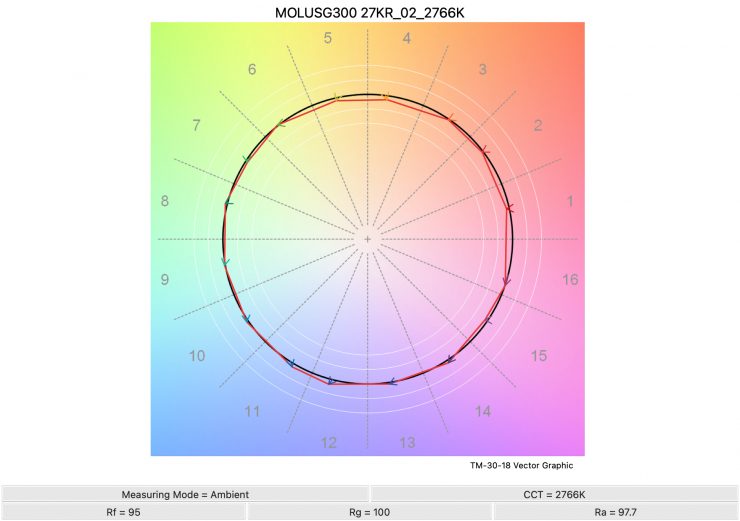
2700K 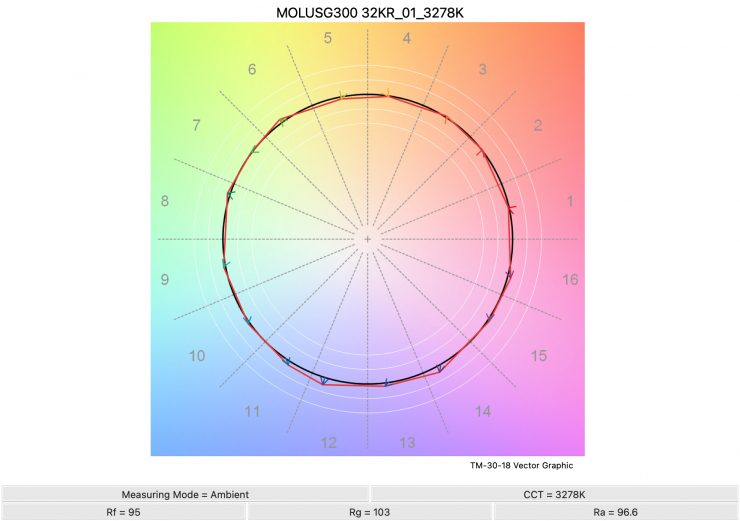
3200K 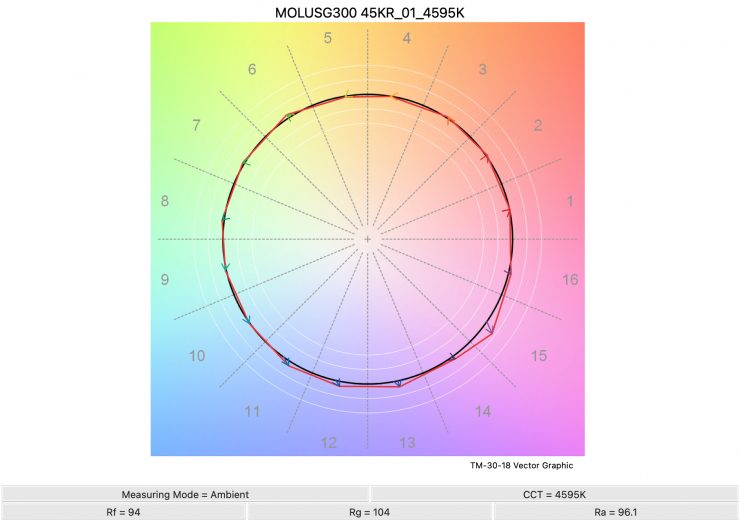
4500K 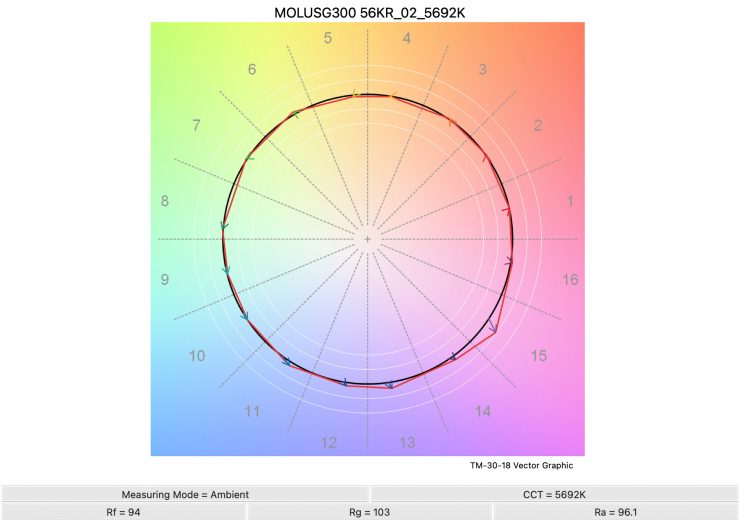
5600K 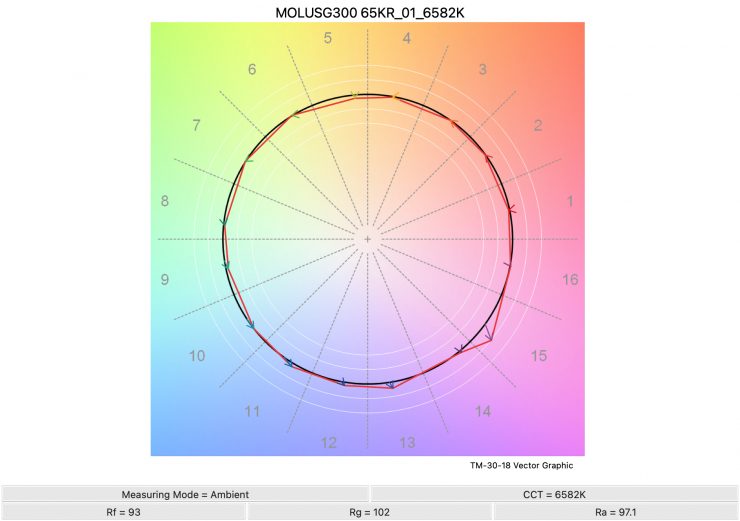
6500K
Above you can see the scores for the MOLUS G300 at various CCT settings. Below I have listed the figures as well.
Here are the results:
| Rf | Rg | |
| 2700K | 95 | 100 |
| 3200K | 95 | 103 |
| 4500K | 94 | 104 |
| 5600K | 94 | 103 |
| 6500K | 93 | 102 |
The TM-30 scores were ok, but you can see why the light leans magenta as it is over-saturating those colors, especially at 3200K, 4500K, and 5600K.
SSI
SSI (Spectral Similarity Index) was developed by the Sci-Tech Council of the Academy. SSI gives me the ability to set any light as a standard, or use predefined standards (such as CIE D55), and then give other lights an SSI score based on how well they will match standards such as CIE D55. This way I can measure spectral response and compare it directly against an ideal light source. This is actually a much better test than recording CRI scores.
ZHIYUN MOLUS G300 3200K
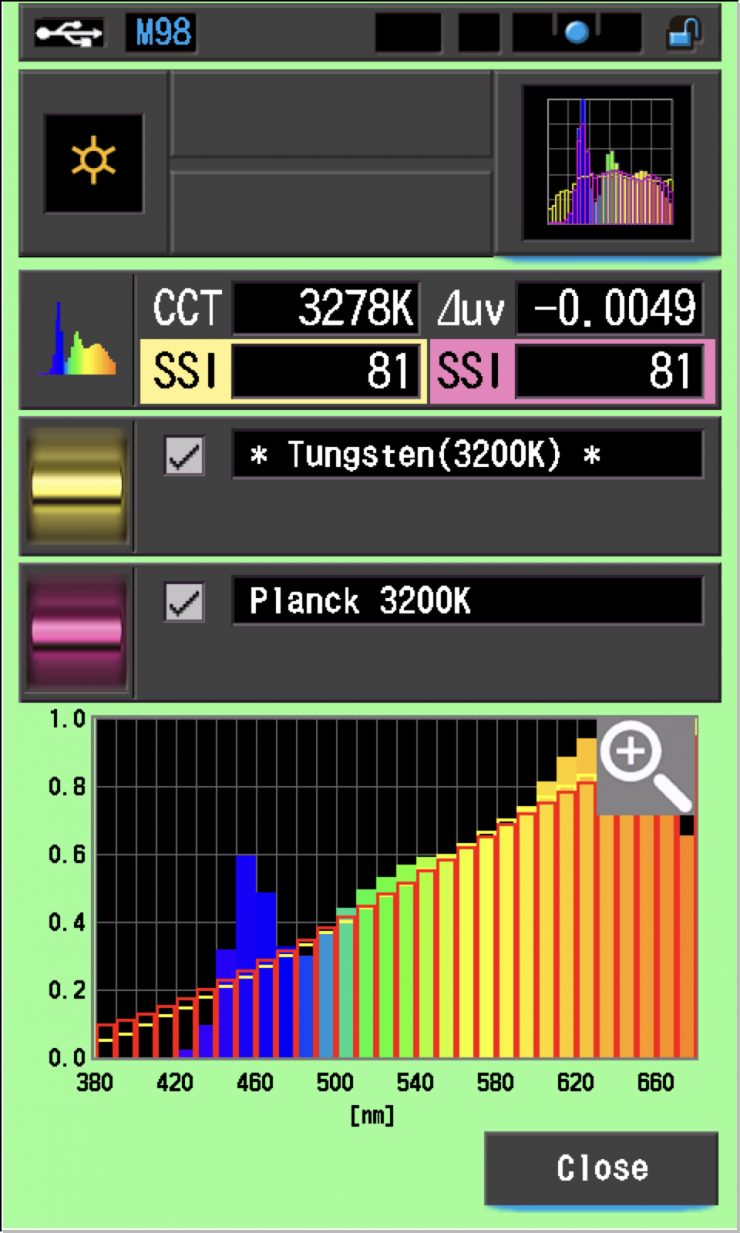
In this graph, the red bars indicate a perfect Planck 3200K source. The gold bars indicate a perfect 3200K Tungsten source. This lets us compare how close to a perfect 3200K lighting source the MOLUS G300 is. Any SSI score in the high 70’s, low ’80s is very good for a 3200K LED light. The results for the MOLUS G300 were pretty good when used at 3200K. As you can see, LED lights have a hard time replicating colors below about 450nm.
ZHIYUN MOLUS G300 5600K
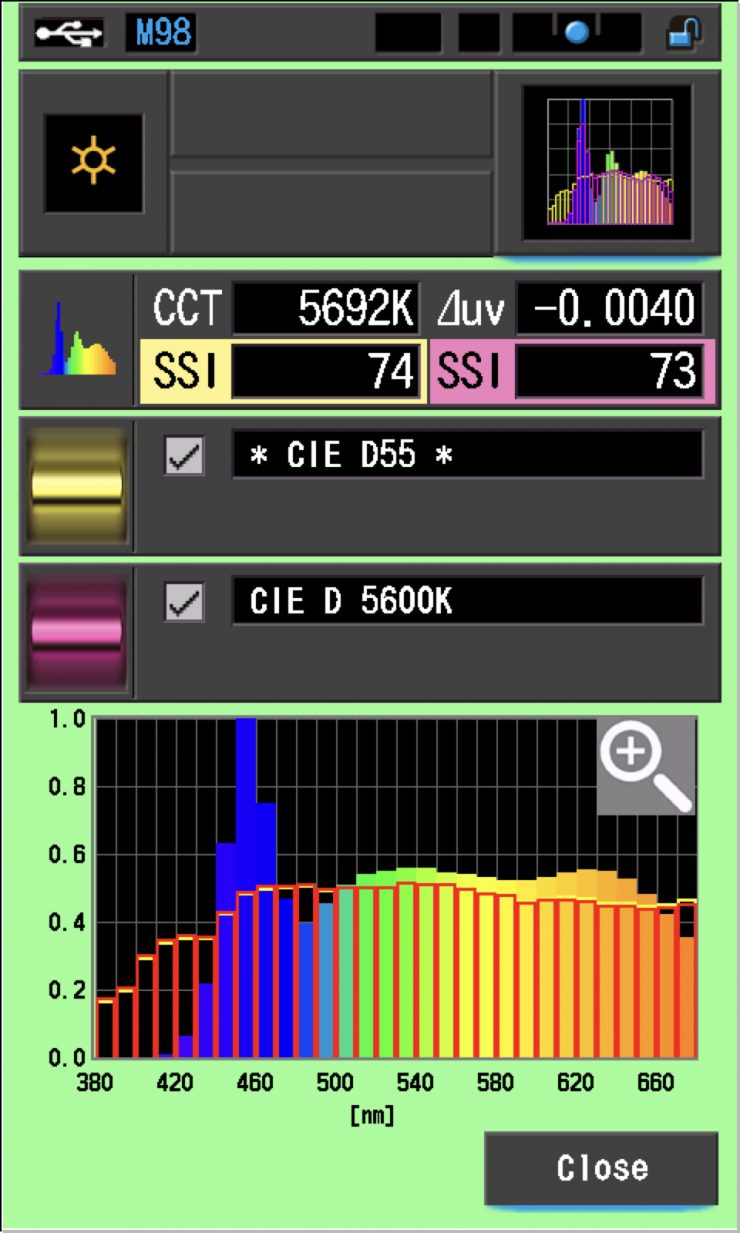
In the graph above the gold bars indicate a perfect CIE D55 source. The red bars indicate a perfect CIE D 5600K source. This lets us compare how close to a perfect 5600K lighting source the MOLUS G300 is. A score in the low 70’s is typical for a 5600K LED source.
The main reason we want to record SSI scores is so we can see how well they match with other lights. As an example, I wanted to see how well the ZHIYUN MOLUS G300 matched the ARRI Orbiter and ZHIYUN’s own MOLUS B500. Below you can see the results.
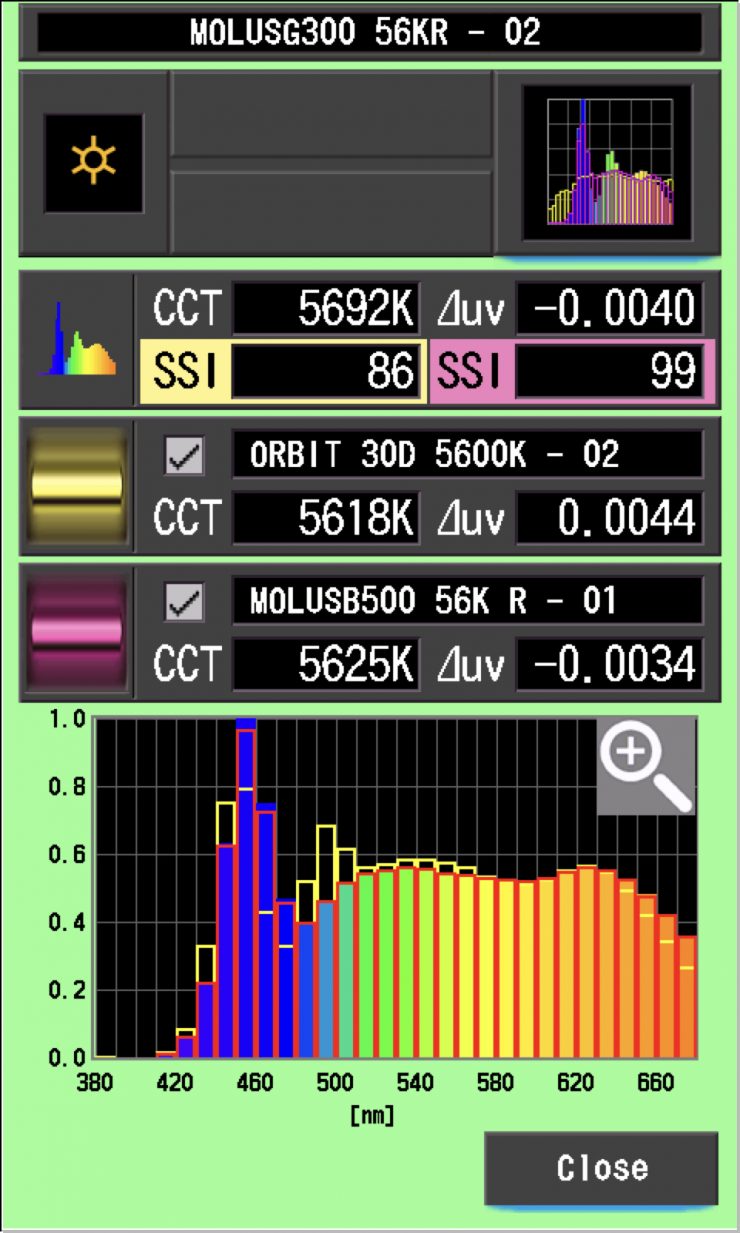
As you can see the MOLUS B500 is almost a perfect match with the MOLUS G300, and its still reasonable match to the ARRI Orbiter. Any score in the high ’80s and low 90s would be enough to get a decent enough match.
As another test, I thought I would compare those same lights against the ZHIYUN MOLUS G300 at 3200K. Below you can see the results.
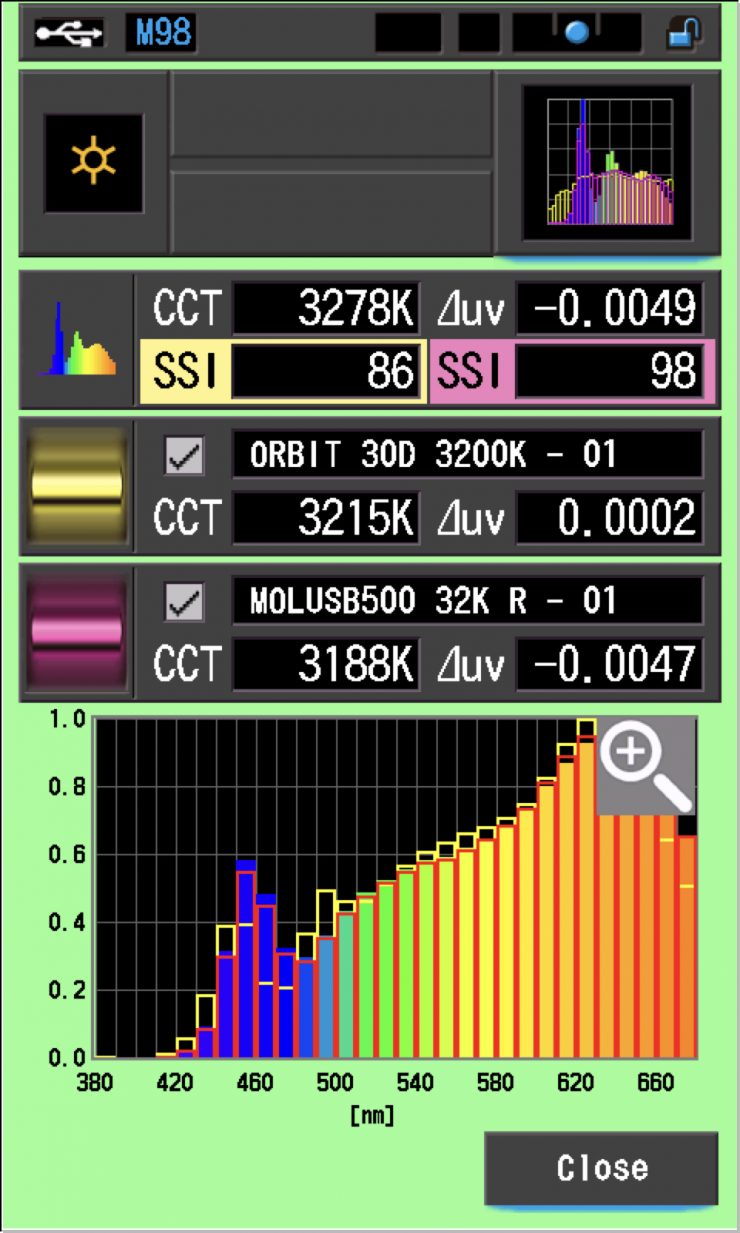
As you can see, the results were almost identical to what they were at 5600K. Very few lights from different manufacturers are ever going to be an exact match.
Ok, so let’s do some more comparisons. This time I wanted to see how well the MOLUS G300 when used Open Face matched the light when it was used with its reflector and with a DoPChoice Octa 3 Softbox.
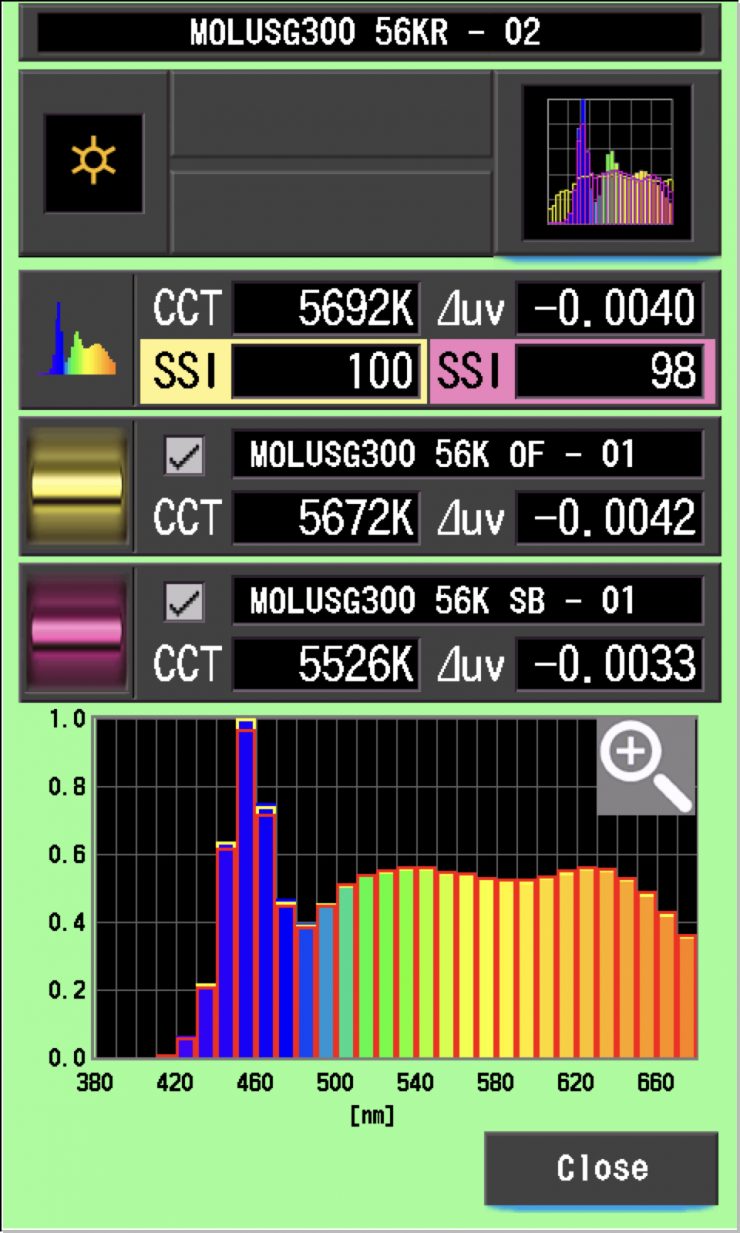
As you can see, with a score of 100 and 98, the light matches very well when used both Open face and with its reflector or a soft box. This tells me that if I had two MOLUS G300s, and I used one open-face and the other with a reflector or soft box they would be virtually indistinguishable.
SSI tests are a great way of telling you what lights you own or use will work well together.
CCT Match Mode
As I mentioned earlier in the review if you use the ZY Vega app you can access the CCT Match mode where you can use your smartphone’s camera to capture a lighting source that the MOLUS G300 will then attempt to replicate.
I decided to test this out, by capturing the light from a tungsten bulb in my room and getting the MOLUS G300 to replicate it. I then measured both the tungsten bulb and the MOLUS G300 to see how close they were.
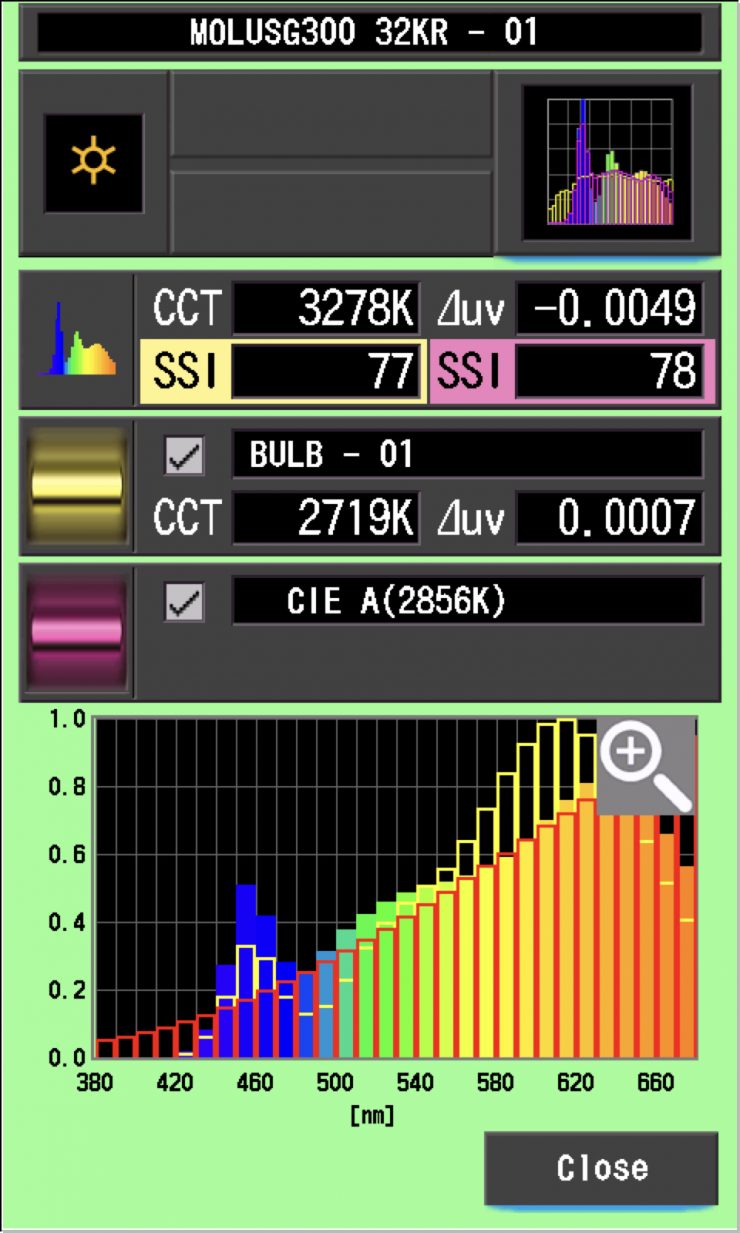
Now, because the MOLUS G300 can go down to 2700K I expected it to be able to replicate the tungsten bulb reasonably well. Unfortunately, even with the CCT reading for the bulb being above 2700K the Sri score was just 77, which was ok, but not great. If I tried to get the light to actually replicate this bulb in the real world it wouldn’t be overly accurate, but at least it would get you in the ball park.
Spectral Distribution
5600K
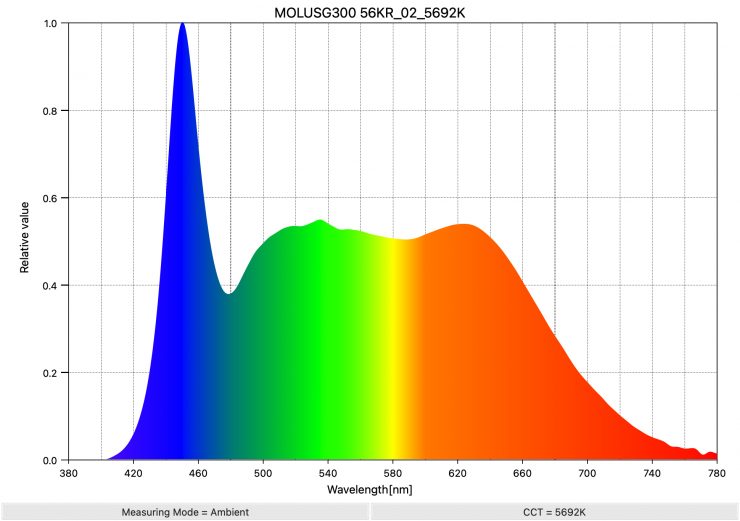
Above you can see the spectral distribution of the ZHIYUN MOLUS G300 when it is set at 5600K. The spectral distribution is reasonably decent for a Bi-color LED light.
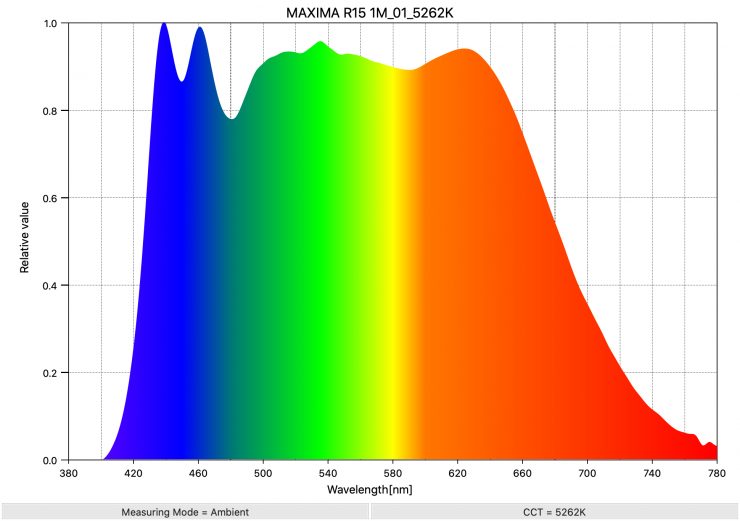
If you want to see what a really good spectral response looks like for a LED light at 5600K, above is the result for the Maxima 3.
3200K
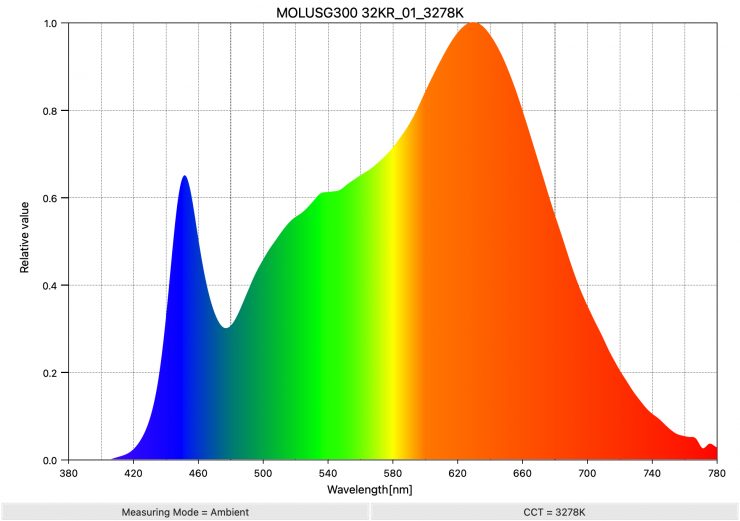
Above you can see the spectral distribution of the ZHIYUN MOLUS G300 when it is set at 3200K. The spectral distribution is nice and even.
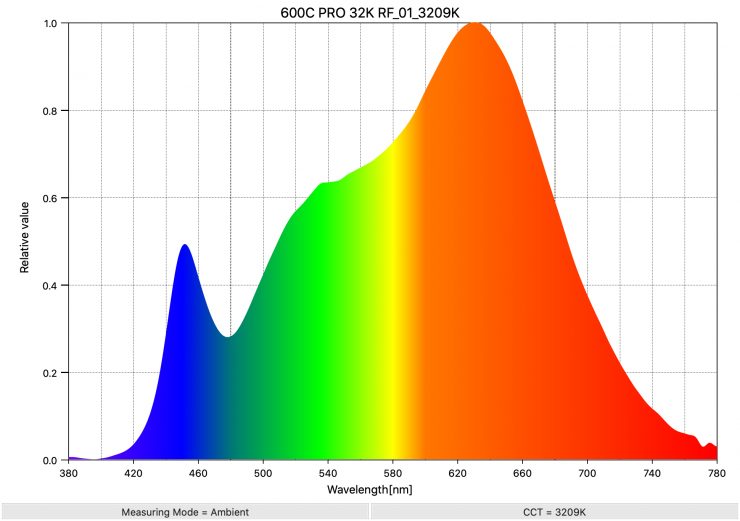
As a comparison, above you can see the spectral distribution of the Aputure 600c Pro when it is set at 3200K.
Real-World Performance & Quality of Light
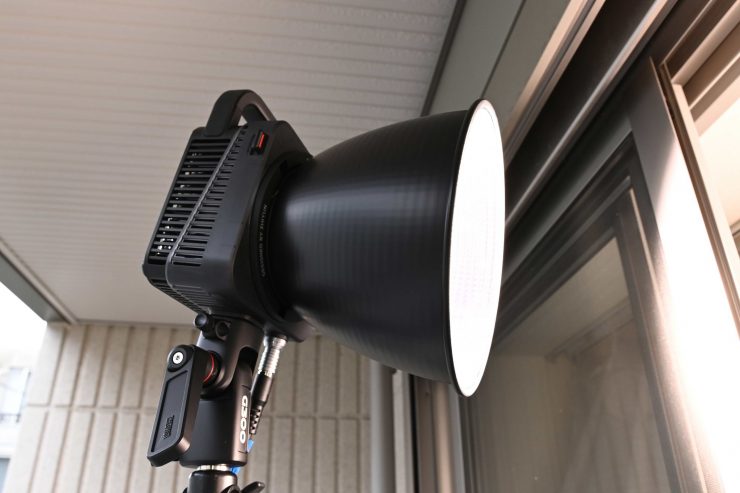
As I always say, photometric scores only tell you part of the story. So let’s find out if the scores from the ZHIYUN MOLUS G300 translate into good real-world performance.
The photometric results can only give me scientific data and it is much more important for me to see how the light looks and performs. Contrary to popular belief, if you are in the business of making lights you don’t want to try and achieve perfect scores because perfect scientific scores don’t equate to a light looking good. A good light should look good to a camera because, after all, that is what is capturing the image. Cameras and our eyes see differently and ideally, you want to use a light that looks good to your camera. There’s a bit of alchemy in knowing what to prioritize in order to render colors that appear accurate, natural, and pleasing. It’s not just about hitting certain numbers.
Lighting really comes down to how you use the light and having a great light isn’t suddenly going to produce better results for you unless you know what you are doing.
The 105-degree beam spread you get when using the light open-faced allows you to create a nice broad spread of light. For a small-sized light, it is certainly capable of lighting up a decent-sized room.
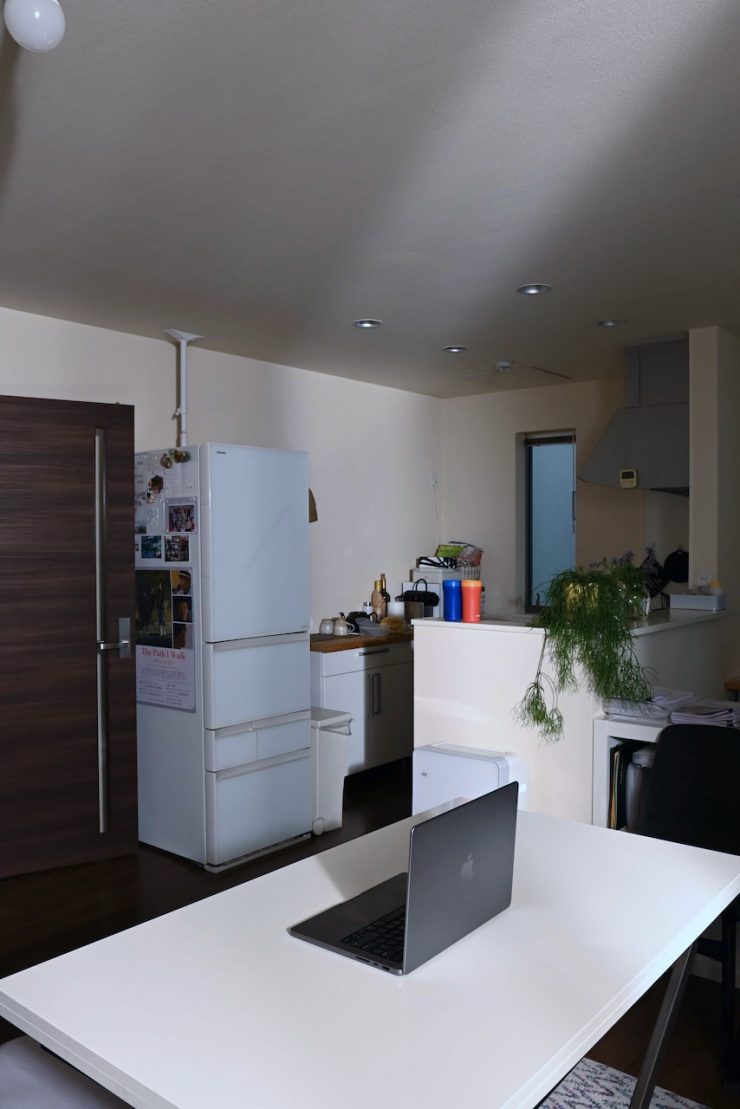
Reflector (MAX Extreme mode) 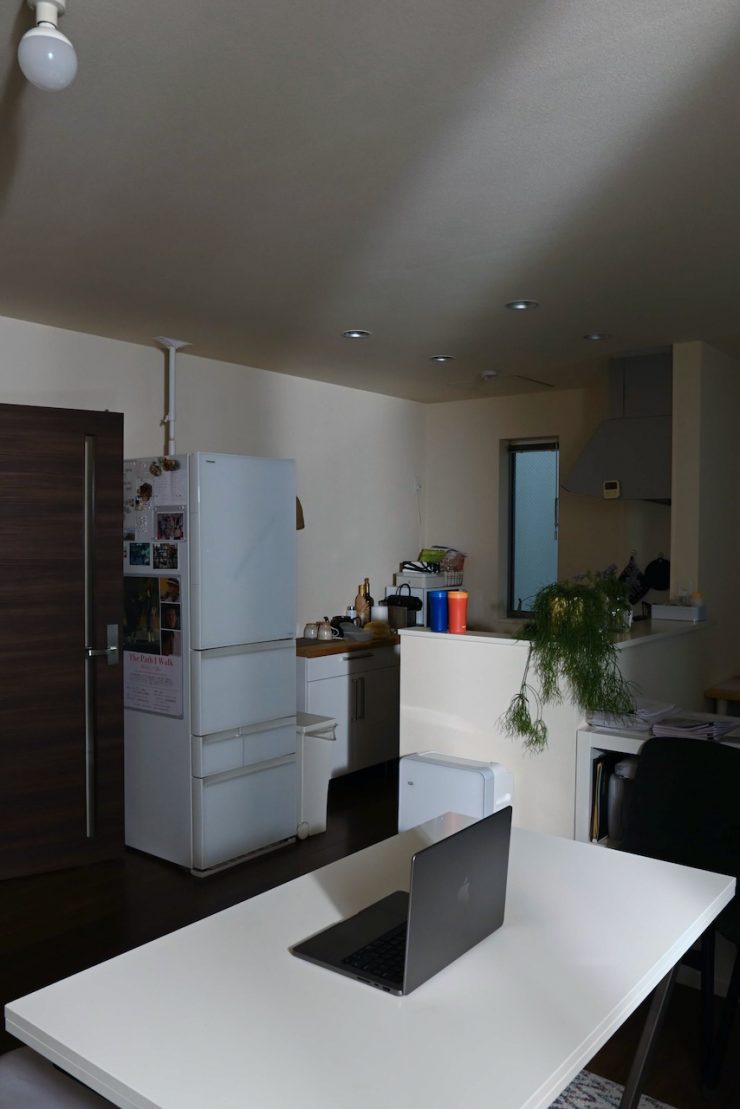
Reflector (MAX Extreme mode Off) 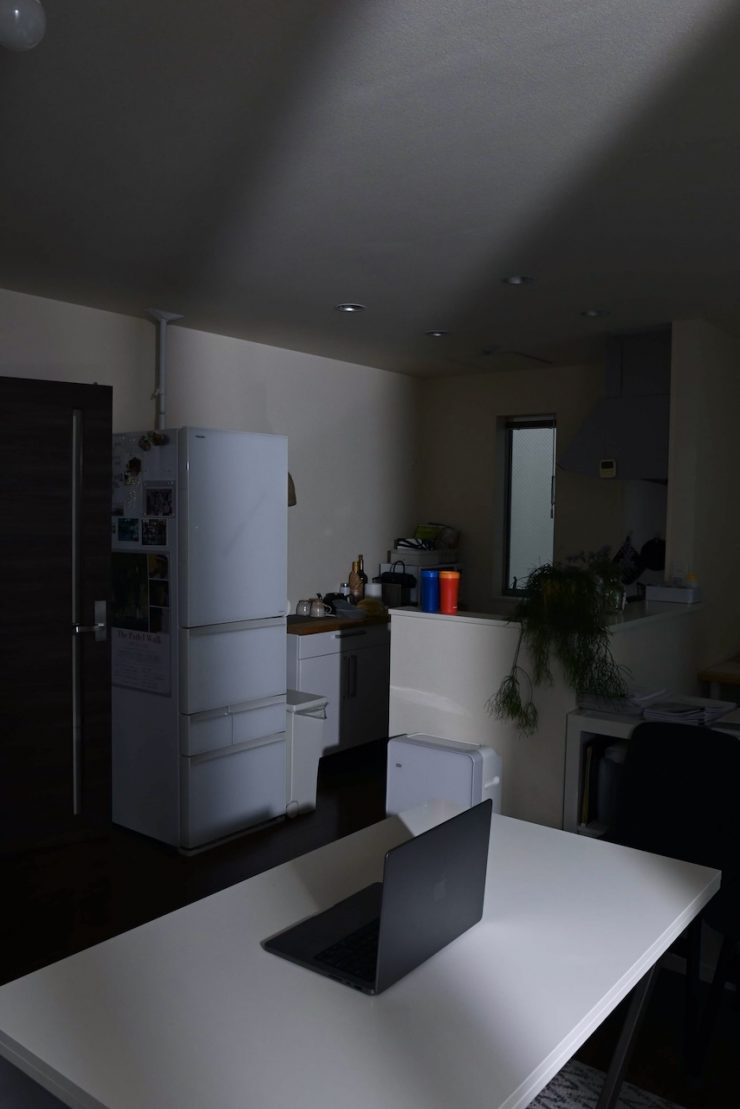
Open Face (MAX Extreme mode) 
Light Off
Above you can see a comparison of the output difference between the light used with its reflector, open-faced, and with the light turned off. The light is placed outside and punched through a sheer curtain. I have kept the same camera settings for all three shots.
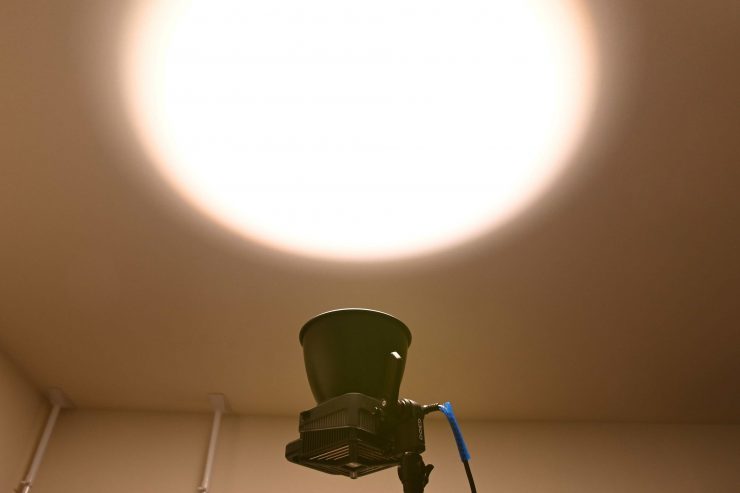
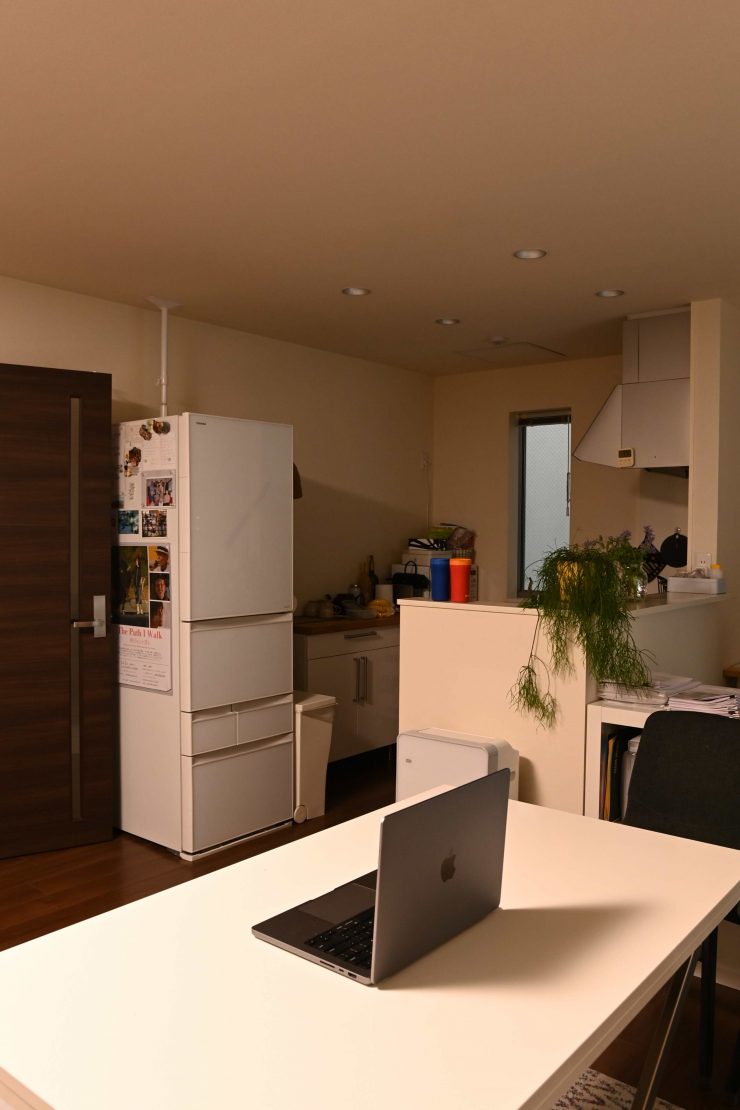
Light On 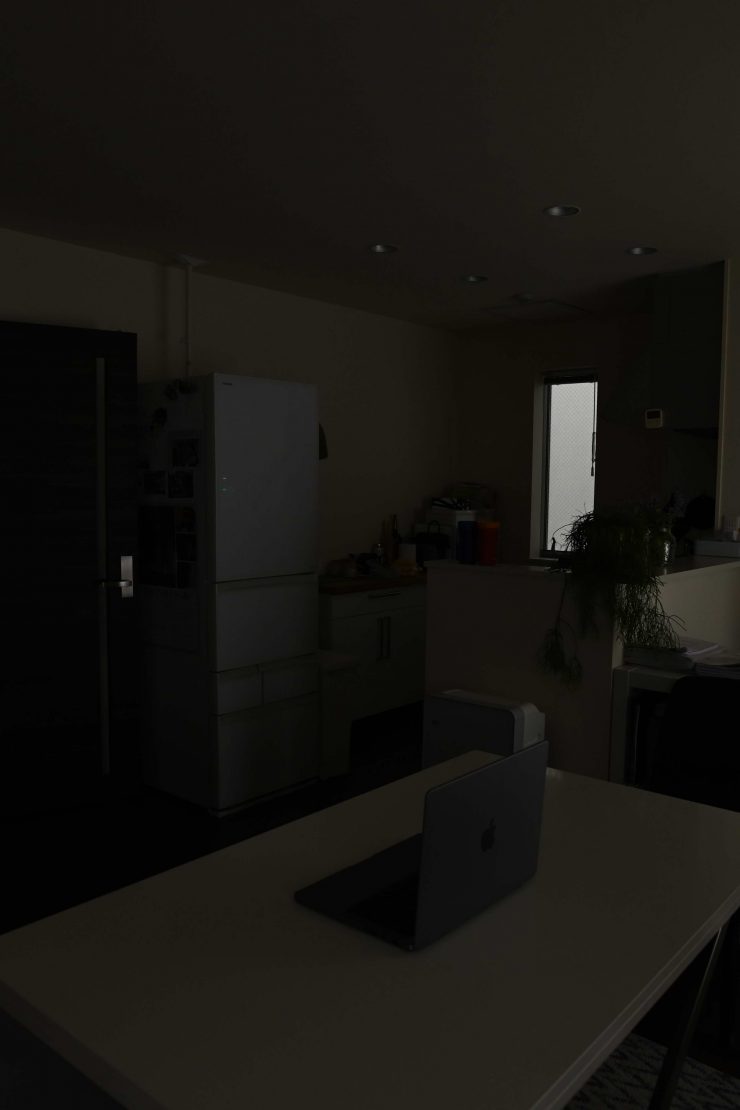
Light Off
The light does have a good amount of output for a light of this size with this power draw. Above you can see a comparison with the light being used with its reflector being punched into the ceiling and with the light off.
Above you can see what the light looks like being used when used open face and punched in the ceiling.
Above you can see what the light looks like with its reflector being punched directly down onto a table.
Above you can see what it looks like when used with and without its reflector at a distance of 3m / 9.9′ from the wall. I have kept the camera setting the same for both shots.

Reflector (close to wall) 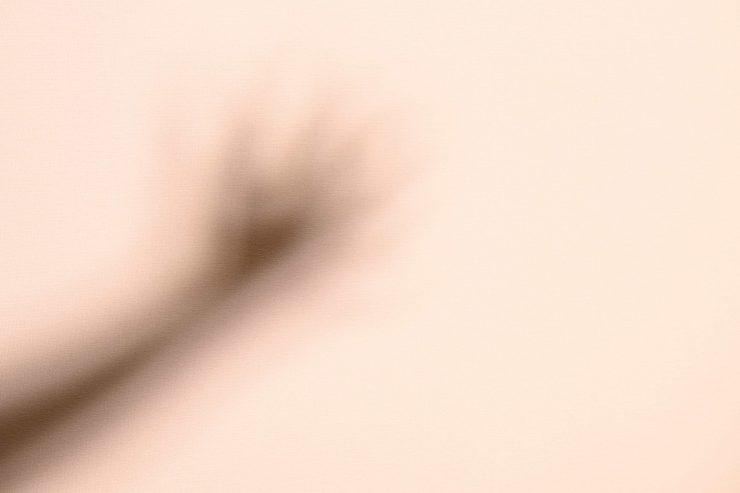
Reflector (away from wall) 
Open Face (close to wall) 
Open Face (away from wall)
Above you can see what the shadows look like when the fixture is used with and without its reflector at a distance of 3m / 9.9′ from the wall.
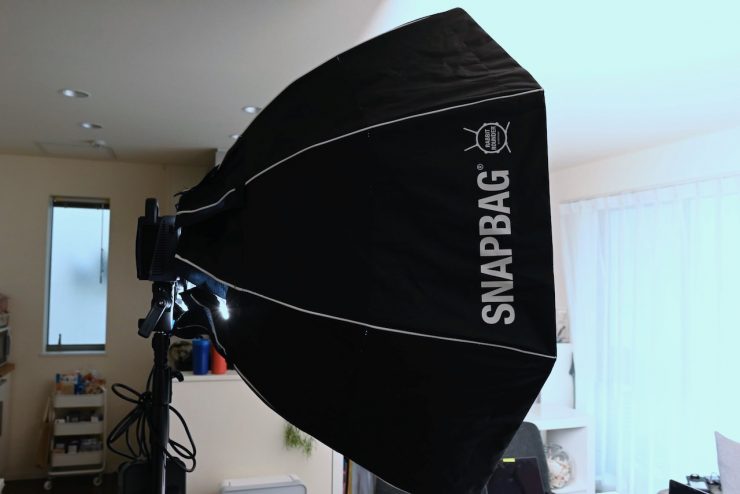
Like most modern-day LED lights, you can create a very soft, flattering light source using a softbox or other lighting modifier.
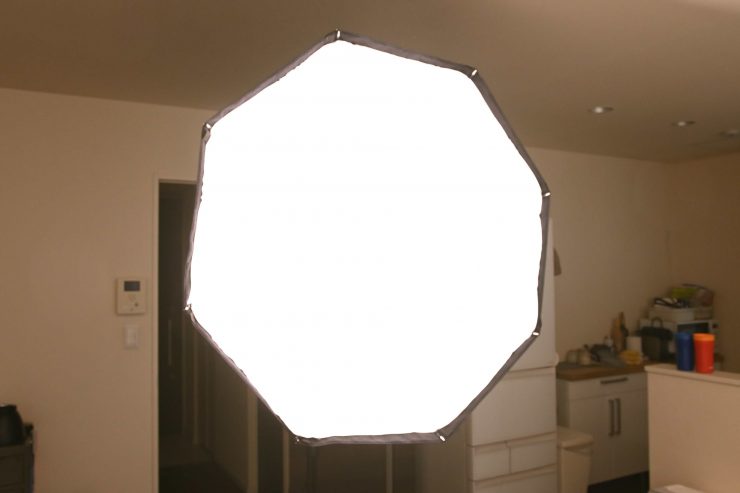
The light was able to fill up a large softbox reasonably well and it still provided lots of output.

The light was able to handle a large and heavy DoPChoice Octa 3 SNAPBAG.
What I also liked is that because the light is so small and it doesn’t weigh much, you could easily put it out on a boom arm. You can use the power supply/controller as a counterweight.
Who is the ZHIYUN MOLUS G300 aimed at?
This is certainly a fixture that could be used for lots of different applications, by lots of different people. The light is arguably being targeted at the same audience that may be looking at lights from amaran, Aputure, Nanlite, CAME-TV, GVM, etc.
The small size of the light and its ability to use Bowens Mount accessories is probably its biggest drawcard. It also has an incredible amount of output for such a small-sized fixture.
Price & Availability
The ZHIYUN MOLUS G300 retails for $599 USD and it is now available to purchase.
Unlike the MOLUS G200, the light doesn’t come in a hard/soft carry case. This means you will have to find a case or bag to put it in.
Below you can see how the price compares to some of the competition.
| PRICE | |
| ZHIYUN MOLUS G300 | $599 USD |
| amaran COB 200x S | $349 USD |
| Aputure LS 300x | $999 USD |
| Nanlite FS-300B | $239 USD* |
| Sirui Blaze C300B | $398 USD* |
| CAME-TV Tioga Series 310W Bi-Color | $440 USD |
| GVM Pro SD300B | $389 USD |
*On special at B&H as of the 12th May 2024
At $599 USD, it could be a tough sell for ZHIYUN considering lights like the Nanlite FS-300B and other options from more well know lighting brands are more affordable.
Specifications

Conclusion
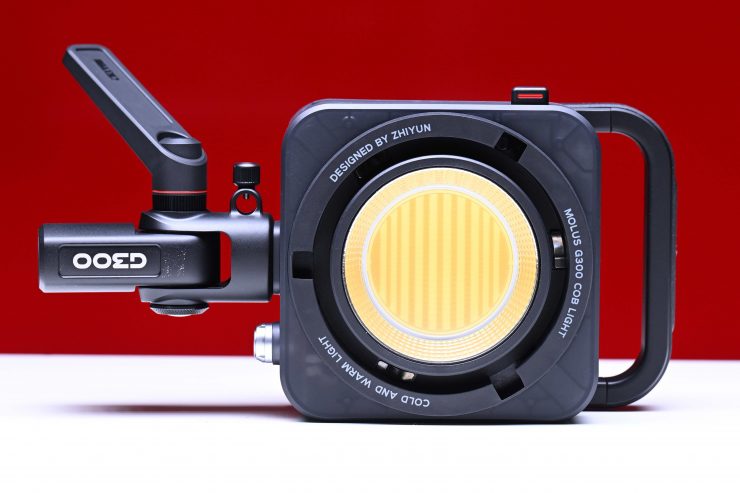
The ZHIYUN MOLUS G300 has its pros and cons like any light. The build quality is generally good, and the light packs a massive punch for a small-sized fixture. Its compact size and lack of weight make it a good choice if you need to keep your kit to a minimum or you are traveling. The photometric scores are solid and most importantly, very consistent. The CCT accuracy when dimming the light could be better and it doesn’t have a consistent output across its CCT range.
The tiny footprint of the MOLUS G300 means you could create a very small lightweight lighting kit using 2-3 of these fixtures. Everything could easily fit inside a small-sized backpack or Pelican case.
Having a Bowens Mount attachment on a light of this size is a nice touch because it allows you to use affordable lighting modifiers.
Yes, the fan noise is reasonably loud when the light is used in its MAX Extreme mode, but that is probably a small price to pay for the output you get.
What I find interesting (and this is probably a clever marketing move) is that by calling the MOLUS G300 a 300W fixture, even though it draws 500W, ZHIYUN has potentially avoided people complaining about any fan noise. If they had marketed the MOLUS G300 as a 500W fixture (which technically it is), then users would have complained about the fan noise. However, if you add a ‘MAX Extreme mode’ you give the impression that it is an added extra feature, and therefore people won’t complain. Whether you think this is clever marketing or not, I’ll leave it to you to decide.
Not having any way to power the light other than from mains power seems to be an oversite, especially since you could theoretically power this light from two flight-safe camera batteries. In saying that, with a 500W power draw that would be pretty hard to do and I doubt most people looking at this type of light would would to invest in high power draw batteries to be able to make that work even if it was possible. In saying that, even the ability to run this light remotely at 50% output would be a bonus.
Another issue ZHIYUN is likely to face, through no fault of their own, is that it isn’t a brand a lot of people would be familiar with, especially in the lighting world. When you don’t have a track record of making certain products you need to either have an exceptionally good product that offers a lot more than its competition, or it needs to be considerably cheaper. Now, you should never judge a book by its cover, but that is the reality ZHIYUN faces.
The ZHIYUN MOLUS G300 has its faults, but there is certainly a lot to like about it. Its color rendering performance is good and in most of the tests I conducted, it performed well. Its compact size and high output make it a very intriguing option when compared to a lot of its competition, however, it will face very stiff competition given other options that are more affordable and more well known.
This light, just like the smaller MOLUS G200, actually surprised me, and I don’t think I have come across any other fixture of this size that has this much output and utilizes a Bowens Mount.

